Scott M. Graffius Delivering a Talk at DevOps Experience 2021 Conference
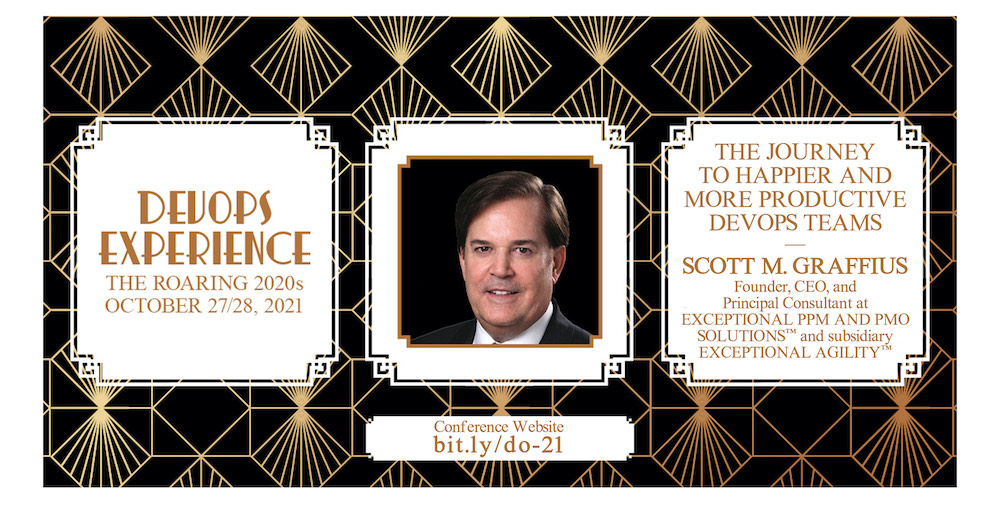
🔥 Update: The DevOps Experience 2021 conference recorded sessions and made the videos available. The video for Scott's session is included at the end of this post.
Scott M. Graffius will be speaking at the DevOps Experience 2021 Conference. Now in its 4th year, the conference will explore the role DevOps will play in the "roaring 2020s". This year, speakers and attendees will interact virtually. Scott will present “The Journey to Happier and More Productive DevOps Teams.” His session will air at:
- Pacific Time: 11:45 a.m. to 12:30 p.m. on 28 October
- Eastern Time: 2:45 to 3:30 p.m. on 28 October
- Central European Time: 8:45 to 9:30 p.m. on 28 October
- Australian Eastern Time: 5:45 to 6:30 a.m. on 29 October
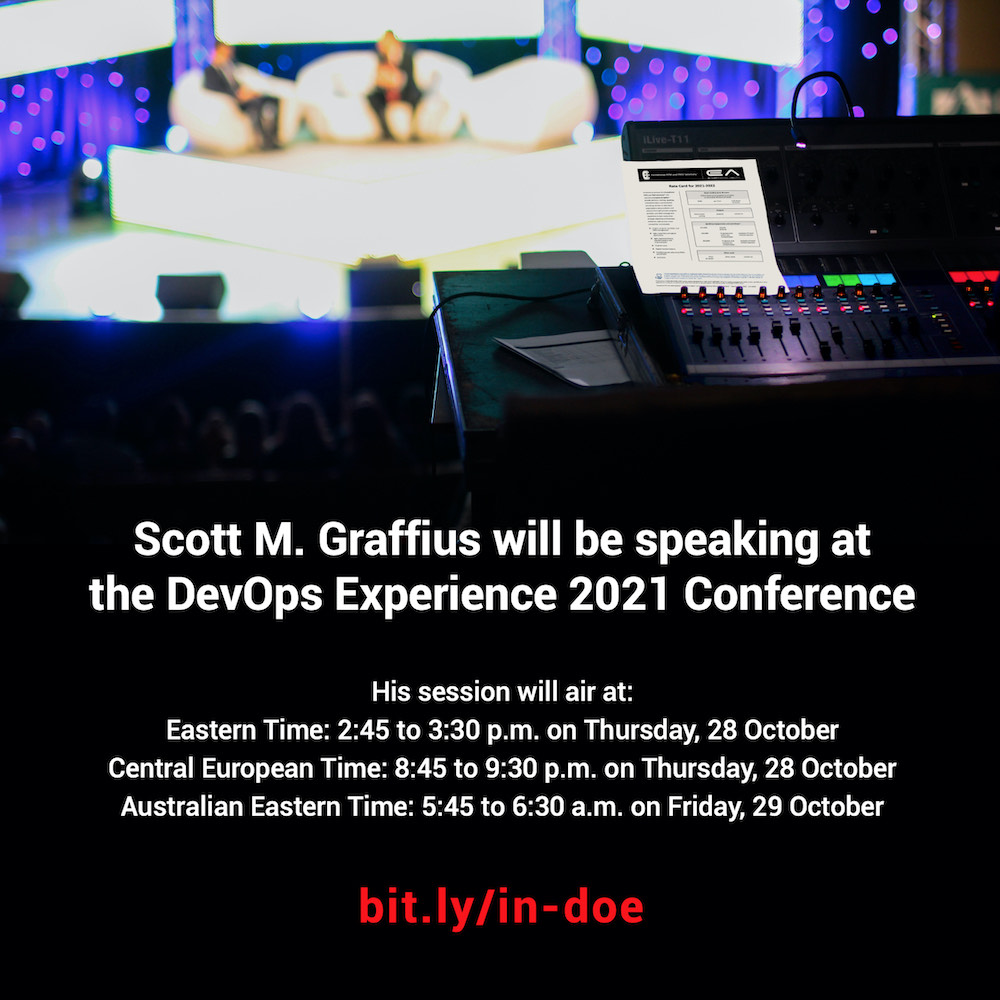
Attendees may be eligible to receivntinuing education unit (CEU) credit, equivalent to 0.75 Professional Development Hour (PDH). For reporting with the Project Management Institute (PMI), it's 0.75 Professional Development Unit (PDU), under the Leadership category. For reporting with the Scrum Alliance, it's 0.75 Scrum Educational Unit (SEU), under either the Learning category or the Events category. For reporting with other organizations, refer to their respective instructions.
To learn more and to secure tickets for the conference, visit https://www.techstrongevents.com/devopsexperience.

About Scott M. Graffius

Scott M. Graffius, PMP, CSP-SM, CSP-PO, CSM, CSPO, SFE, ITIL, LSSGB is an agile project management practitioner, consultant, award-winning author, and international speaker. He has generated over one billion dollars of business value in aggregate for the organizations he has served. Graffius is the founder, CEO, and principal consultant at Exceptional PPM and PMO Solutions™ and subsidiary Exceptional Agility™, based in Los Angeles, California. His expertise spans project, program, portfolio, and PMO leadership inclusive of agile, traditional, and hybrid approaches. Content from his books (Agile Scrum and Agile Transformation), workshops, speaking engagements, and more have been featured and used by businesses, governments, and universities including Gartner, Microsoft, Deloitte, Oracle, Cisco, Ford, Qantas, Atlassian, Bayer, the National Academy of Sciences, the United States Department of Energy, the United States Army, Project Management Institute, the IEEE, the New Zealand Ministry of Education, Tufts University, Texas A&M University, Virginia Tech, Penn State, Warsaw University of Technology, University of Waterloo, Loughborough University London, and others. Graffius has spoken at 58 conferences and other events around the world, including Armenia, Australia, Brazil, Canada, Czech Republic, Finland, France, Germany, Greece, India, Ireland, Lithuania, Luxembourg, Netherlands, New Zealand, Sweden, United Kingdom, and the United States. Thinkers360 named Graffius a global top thought leader and influencer in four domains: Agile, Change Management, Digital Transformation, and GovTech.
His full bio is available here.
Connect with Scott on:
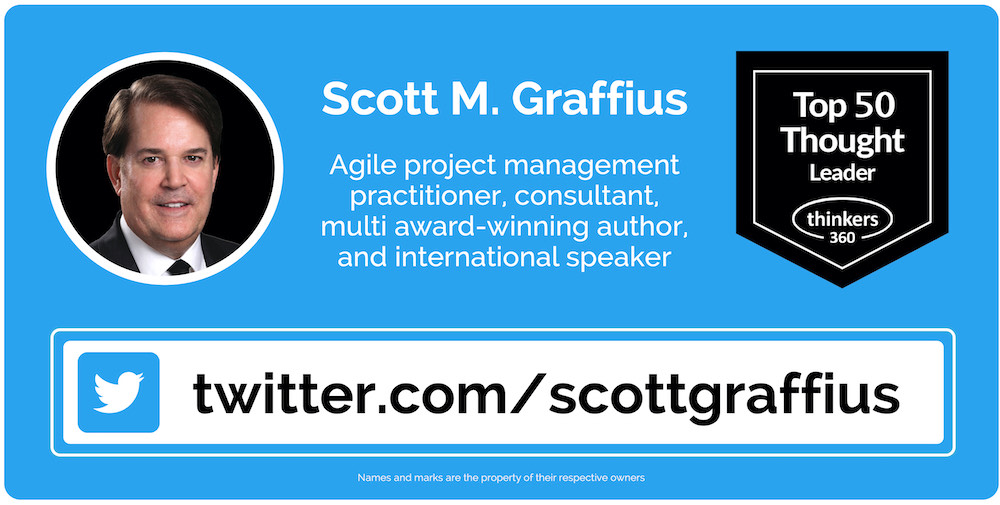

About Agile Scrum: Your Quick Start Guide with Step-by-Step Instructions
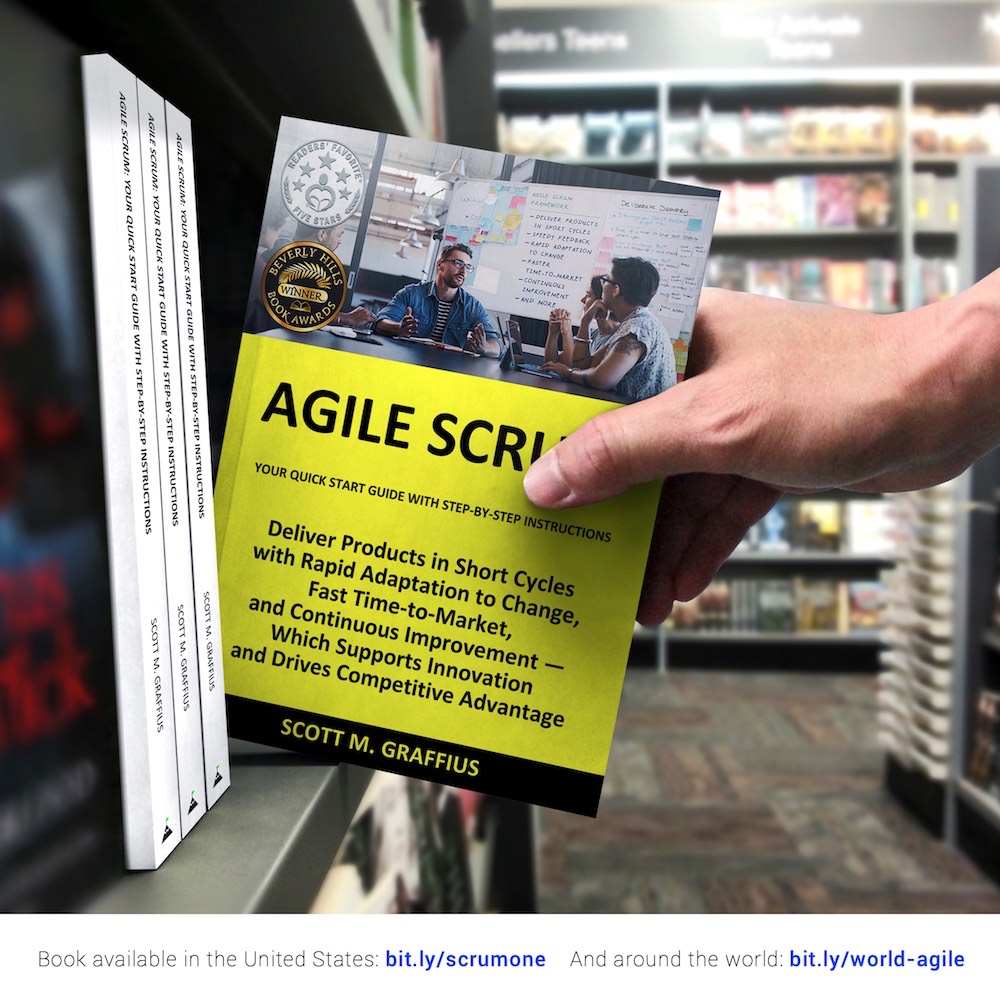
Shifting customer needs are common in today's marketplace. Businesses must be adaptive and responsive to change while delivering an exceptional customer experience to be competitive.
There are a variety of frameworks supporting the development of products and services, and most approaches fall into one of two broad categories: traditional or agile. Traditional practices such as waterfall engage sequential development, while agile involves iterative and incremental deliverables. Organizations are increasingly embracing agile to manage projects, and best meet their business needs of rapid response to change, fast delivery speed, and more.
With clear and easy to follow step-by-step instructions, Scott M. Graffius's award-winning Agile Scrum: Your Quick Start Guide with Step-by-Step Instructions helps the reader:
- Implement and use the most popular agile framework―Scrum;
- Deliver products in short cycles with rapid adaptation to change, fast time-to-market, and continuous improvement; and
- Support innovation and drive competitive advantage.
Hailed by Literary Titan as “the book highlights the versatility of Scrum beautifully.”
Winner of 17 first place awards.
Agile Scrum: Your Quick Start Guide with Step-by-Step Instructions is available in paperback and ebook/Kindle in the United States and around the world. Some links by country follow.
- 🇧🇷 Brazil
- 🇨🇦 Canada
- 🇨🇿 Czech Republic
- 🇩🇰 Denmark
- 🇫🇮 Finland
- 🇫🇷 France
- 🇩🇪 Germany
- 🇬🇷 Greece
- 🇭🇺 Hungary
- 🇮🇳 India
- 🇮🇪 Ireland
- 🇮🇱 Israel
- 🇮🇹 Italy
- 🇯🇵 Japan
- 🇱🇺 Luxembourg
- 🇲🇽 Mexico
- 🇳🇱 Netherlands
- 🇳🇿 New Zealand
- 🇳🇴 Norway
- 🇪🇸 Spain
- 🇸🇪 Sweden
- 🇨🇭 Switzerland
- 🇦🇪 UAE
- 🇬🇧 United Kingdom
- 🇺🇸 United States

About Agile Transformation: A Brief Story of How an Entertainment Company Developed New Capabilities and Unlocked Business Agility to Thrive in an Era of Rapid Change
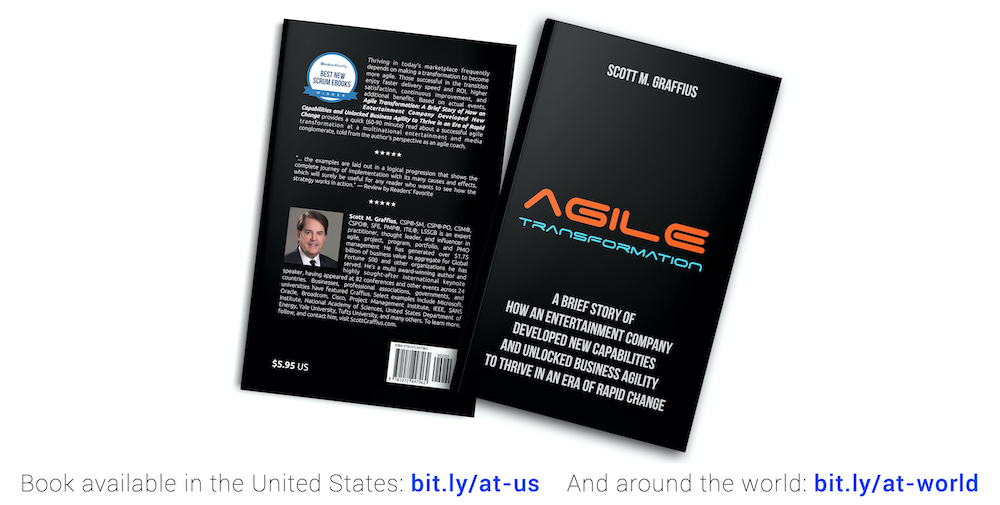
Thriving in today's marketplace frequently depends on making a transformation to become more agile. Those successful in the transition enjoy faster delivery speed and ROI, higher satisfaction, continuous improvement, and additional benefits.
Based on actual events, Agile Transformation: A Brief Story of How an Entertainment Company Developed New Capabilities and Unlocked Business Agility to Thrive in an Era of Rapid Change provides a quick (60-90 minute) read about a successful agile transformation at a multinational entertainment and media company, told from the author's perspective as an agile coach.
The award-winning book by Scott M. Graffius is available in paperback and ebook/Kindle in the United States and around the world. Some links by country follow.
- 🇦🇺 Australia
- 🇦🇹 Austria
- 🇧🇷 Brazil
- 🇨🇦 Canada
- 🇨🇿 Czech Republic
- 🇩🇰 Denmark
- 🇫🇮 Finland
- 🇫🇷 France
- 🇩🇪 Germany
- 🇬🇷 Greece
- 🇮🇳 India
- 🇮🇪 Ireland
- 🇯🇵 Japan
- 🇱🇺 Luxembourg
- 🇲🇽 Mexico
- 🇳🇱 Netherlands
- 🇳🇿 New Zealand
- 🇪🇸 Spain
- 🇸🇪 Sweden
- 🇨🇭 Switzerland
- 🇦🇪 United Arab Emirates
- 🇬🇧 United Kingdom
- 🇺🇸 United States

About the DevOps Experience Conference
The following includes content from the conference website:
As we stand poised to move beyond the COVID-19 pandemic, we are on the edge of what could be a giant leap forward. The world has come to see and recognize the power of digital transformation. Digital transformation is driven by software, and software is accelerated by DevOps. Cloud native computing has served as a catalyst to the DevOps, software, and digital transformation cycle. Now after perhaps 4-7 years worth of digital transformation progress compressed into the last 18 months concurrent with the pandemic, and with favorable capital markets and business outlook on the horizon, we are poised for a generational leap forward.
As we look forward to all of the great things this transformation enables, we also have to be ready to tackle tough problems like cybersecurity threats, future pandemics, and more. DevOps can be a powerful force for change in all of this. In its 4th year, this year's DevOps Experience will explore how DevOps will be a major factor in the "roaring 2020s."
To learn more about the DevOps Experience 2021 Conference, visit https://www.techstrongevents.com/devopsexperience.
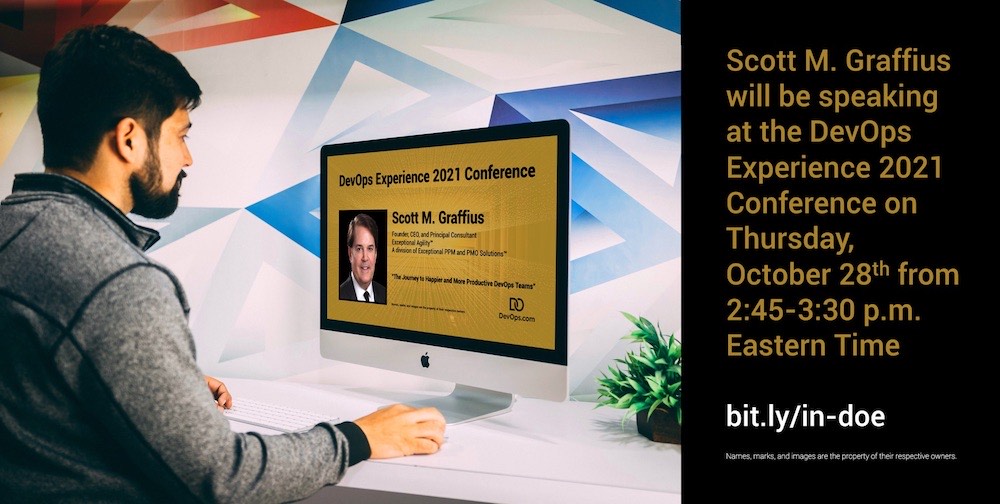

Update on October 28, 2021
If you missed the event, recordings of sessions are now available. Scott's talk is at https://player.vimeo.com/video/637145697 and the video is also shown below.

The short link for this blog post is: https://bit.ly/doe-21
The short link for a related post on LinkedIn is: https://bit.ly/in-doe
© Copyright 2021 Scott M. Graffius. All rights reserved. This material may not be published, broadcast, rewritten or redistributed without the express written permission of Scott M. Graffius.

Bruce Tuckman’s Model (Forming, Storming, Norming, Performing, and Adjourning) is Highly Relevant and Beneficial, But It Doesn’t Please Everyone
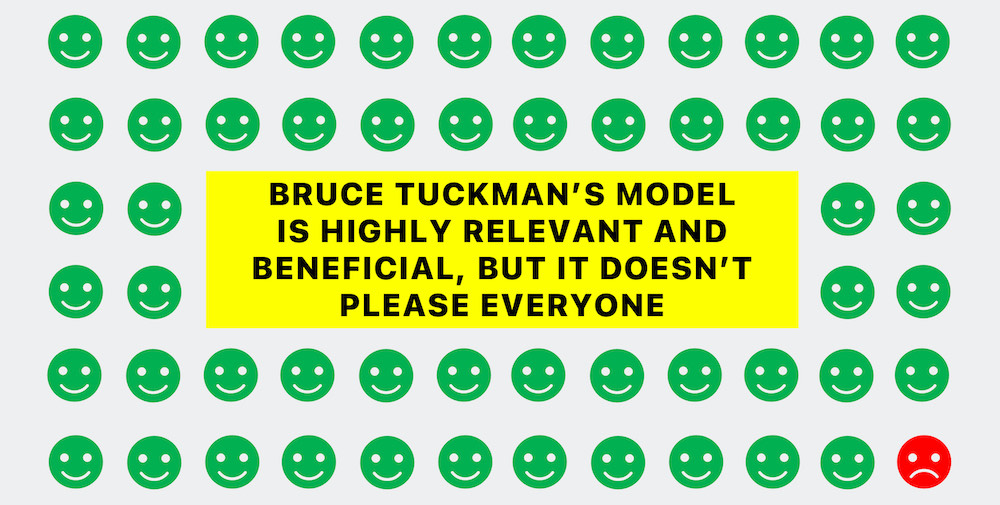
Names and certain identifying details are not included or are redacted (replaced with black rectangles) to respect privacy.

The Question
Steve Jobs famously said: “You can please some of the people some of the time” in response to a tough question at the 1997 Worldwide Developer Conference. The following experience reminded me of that quote.
In a recent workshop on team leadership, a student asked me, “What do you think about █████████’s disregard of Tuckman’s model?” (Note: The student was referring to a person who's a leader in Agile and Scrum. That person's name is redacted, subsequently referred to as “critic.” His or her stance seems to be the rare exception.) I’m detailing my response here.

The Background for Context
Bruce Tuckman (Ph.D. in Psychology from Princeton University) conducted extensive research on group dynamics, and he published a related model in 1965. At that time, the model included four phases: forming, storming, norming, and performing. However, Dr. Tuckman subsequently determined that adjourning was so important that he (with Mary Ann Jensen) updated his model in 1977 to add adjourning as the fifth phase. In the context of this discussion, phases and stages may be used interchangeably; and group dynamics is also referred to as group development, team dynamics, and team development.
Dr. Tuckman’s model has stood the test of time because it remains highly relevant and beneficial. Since his related work was published, it has been supported by additional peer-reviewed research. And it has received recommendations and coverage from leading organizations including Google, Harvard Business Review, IEEE, Forbes, MIT, Fast Company, NASA, Microsoft, TNW, Project Management Institute, Scrum Alliance, Scrum.org, Association for Project Management, Gartner, CIO, Spotify, Imperial College London, RAND Corporation, Princeton University, Software Engineering Institute, University of Edinburgh, Cisco, KPMG, Warsaw University of Technology, DevOps Institute, American Express, SANS Institute, Zurich University, SAP, ViacomCBS, Oxford University, American Management Association, AT&T, University of Southern California, IBM, and many others.
While Tuckman’s model is durable and relevant, no model is perfect. It can be helpful to understand any concerns or limitations—with an emphasis on any which are independently verifiable and are published in peer-reviewed studies.
I related to the student that there are critics of Tuckman’s model, but that they’re few—and I’m not familiar with criticisms meeting the aforementioned rigor of being independently verifiable with such findings appearing in peer-reviewed studies.
I said, for example, that I was already aware of the critic's stated disregard of Bruce Tuckman’s model. I previously looked into the situation to learn more. My research and findings follow.

The Research and Findings
In a █████ communication, the critic said “I never liked ...” referring to Tuckman’s model. He or she went on to state that his or her reason was that “Gersick tested it ...” (Tuckman’s model) and “...it’s not true.” The critic included a link to the paper which was the basis for his or her stance. The link goes to the following paper:
Curtis, B., Walz, D., and Elam, J. (1990, October 1). Studying the Process of Software Design Teams. In: ISPW '90: Proceedings of the 5th International Software Process Workshop on Experience with Software Process Models, pages 52-53.
The critic said that “Gersick tested it” and pointed to the paper. However, Gersick is not an author on the paper. Still, I reviewed the content to see what, if anything, the authors (Curtis, Walz, and Elam) said about Tuckman, Tuckman’s model, and/or Gersick. Here’s what I found.
On Tuckman: Tuckman was not mentioned anywhere in the paper.
On Tuckman’s model (a reference to forming, storming, norming, performing, and/or adjourning): The following appears: “Rather than the standard group process of form-storm-norm-perform, Gersick suggested there came a point halfway through a group project where the team faced its lack of progress.”
On Gersick: Gersick was mentioned four times: “Gersick (1988) observed such a point in a study of project teams” and “Rather than the standard group process of form-storm-norm-perform, Gersick suggested there came a point halfway through a group project where the team faced its lack of progress” and “Gersick's model may be more descriptive of temporary teams that are asked to perform tasks out of their area of expertise” and (a reference citation) “Gersick, C.J.G. (1988). Time and Transition in Work Teams: Toward a New Model of Work Development. Academy of Management Journal, 31 (1), 9-41.”
The critic said that “Gersick tested it” ... and “...it’s not true.” However, as a summary of the above, Gersick is not the author of the paper, and the authors (Curtis, Walz, and Elam) commented that Tuckman’s model did not seem to work for one project. On that one project, “Rather than ... form-storm-norm-perform ... there came a point halfway through ... where the team faced its lack of progress.” That does not negate Tuckman’s model. While teams typically move through the different phases, it’s entirely possible for a team to face a lack of progress at a given time. Phases don’t progress magically; the phase is a marker of the team’s current progress and effectiveness. The critic said that “Gersick tested it” ... and “...it’s not true.” The research specified by the critic did not state that it tested Tuckman’s model and found it to not be true. The research specified by the critic does not support his or her stand. Nevertheless, I dug deeper.
The above paper by Curtis, Walz, and Elam includes Gersick’s work as a reference. I found and carefully reviewed Gersick’s respective research. Again, it’s: “Gersick, C.J.G. (1988). Time and Transition in Work Teams: Toward a New Model of Work Development. Academy of Management Journal, 31 (1), 9-41.” I looked to see what Gersick said about Tuckman or his model. Here’s what I discovered.
Tuckman was mentioned five times: “There was no initial ‘storming’ (Tuckman, 1965; Tuckman & Jensen, 1977) in this group” and “First, as Tuckman pointed out in 1965 and others have noted up to the present (Hare, 1976; McGrath, 1986; Poole, 1983b), they offer snapshots of groups at different points in their life-spans but say little about the mechanisms of change” and “Since all teams were doing construction work on their projects during phase 2, similar to ‘performing’ in Tuckman’s (1965) synthesis, it was a time when teams were more similar to both each other and to the traditional model than they were in phase 1” and (a reference citation) “Tuckman, B. 1965. Developmental Sequence in Small Groups. Psychological Bulletin, 63: 384-399” and (another reference citation) “Tuckman, B., & Jensen, M. 1977. Stages of Small-Group Development. Group and Organizational Studies, 2: 419-427.”
The critic said that “Gersick tested it” ... and “...it’s not true.” However, as a summary of the above, Gersick did not state that Tuckman’s model was tested and found to not be true. For example, Gersick did not say that there was no storming; rather, it was qualified as “no initial ‘storming.’” Furthermore, and most importantly, Gersick provided the following caveat: “This study must be interpreted with caution. It was hypothesis-generating, not hypothesis-testing; the model is expressly provisional.” According to Gersick, the research did not test or prove anything.
The research—both the paper pointed to by the critic, and the reference study—does not supply the stated basis for the critic's stance.

The Conclusion with the Answer
In conclusion, Tuckman’s model has stood the test of time because it remains highly relevant and beneficial. No model is perfect, and it is helpful to understand any concerns or limitations—with an emphasis on any which are independently verifiable and are published in peer-reviewed studies.
My answer to the student’s question (“What do you think about █████████’s disregard of Tuckman’s model?”) was that I diligently reviewed the facts and neither the paper linked to by the critic, nor the other study cited by the paper, support the critic’s assertion that “Gersick tested it ...” (Tuckman’s model) and “...it’s not true.”
Maybe—or maybe not—the critic's view of the model is because of a misunderstanding regarding the research. Or maybe—or maybe not—there's another reason. As Steve Jobs said, “You can please some of the people some of the time.”



The Phases of Team Development Visual
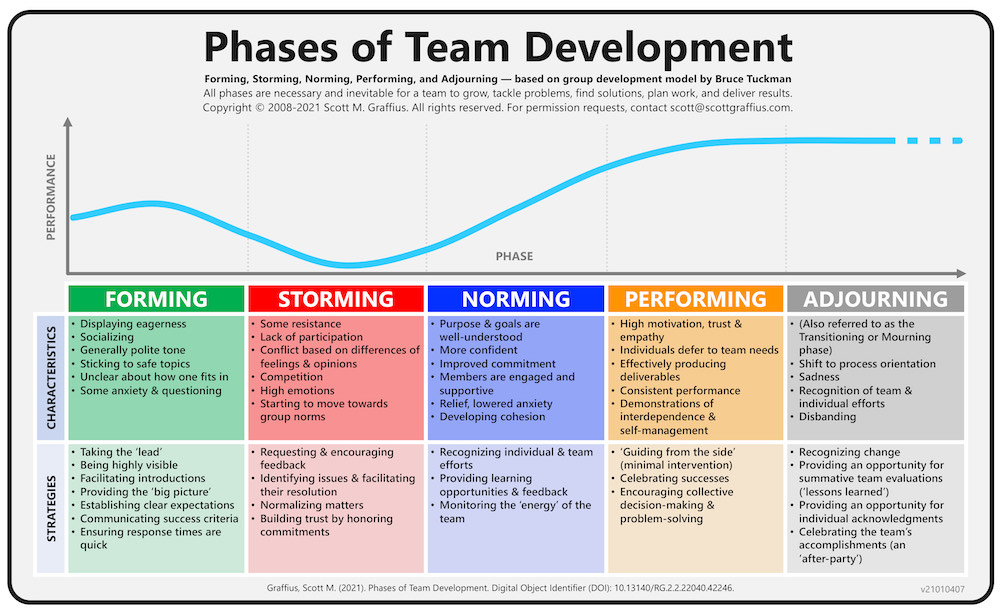
🔥 Update: The newest version is here.

About Scott M. Graffius

Scott M. Graffius, PMP, CSP-SM, CSP-PO, CSM, CSPO, SFE, ITIL, LSSGB is an agile project management practitioner, consultant, award-winning author, and international speaker. He has generated over 1.75 billion dollars of business value in aggregate for the organizations he has served. Graffius is the founder, CEO, and principal consultant at Exceptional PPM and PMO Solutions™ and subsidiary Exceptional Agility™, based in Los Angeles, California. His expertise spans project, program, portfolio, and PMO leadership inclusive of agile, traditional, and hybrid approaches. Content from his books (Agile Scrum and Agile Transformation), workshops, speaking engagements, and more have been featured and used by businesses, governments, and universities including Gartner, Microsoft, Deloitte, Oracle, Cisco, Ford, Qantas, Atlassian, Bayer, the National Academy of Sciences, the United States Department of Energy, the United States Army, Project Management Institute, the IEEE, the New Zealand Ministry of Education, Tufts University, Texas A&M University, Virginia Tech, Penn State, Warsaw University of Technology, University of Waterloo, Loughborough University London, and others. Graffius has spoken at 58 conferences and other events around the world, including Armenia, Australia, Brazil, Canada, Czech Republic, Finland, France, Germany, Greece, India, Ireland, Lithuania, Luxembourg, Netherlands, New Zealand, Sweden, United Kingdom, and the United States. Thinkers360 named Graffius a global top thought leader and influencer in four domains: Agile, Change Management, Digital Transformation, and GovTech.
His full bio is available here.
Connect with Scott on:


About Agile Scrum: Your Quick Start Guide with Step-by-Step Instructions

Shifting customer needs are common in today's marketplace. Businesses must be adaptive and responsive to change while delivering an exceptional customer experience to be competitive.
There are a variety of frameworks supporting the development of products and services, and most approaches fall into one of two broad categories: traditional or agile. Traditional practices such as waterfall engage sequential development, while agile involves iterative and incremental deliverables. Organizations are increasingly embracing agile to manage projects, and best meet their business needs of rapid response to change, fast delivery speed, and more.
With clear and easy to follow step-by-step instructions, Scott M. Graffius's award-winning Agile Scrum: Your Quick Start Guide with Step-by-Step Instructions helps the reader:
- Implement and use the most popular agile framework―Scrum;
- Deliver products in short cycles with rapid adaptation to change, fast time-to-market, and continuous improvement; and
- Support innovation and drive competitive advantage.
Hailed by Literary Titan as “the book highlights the versatility of Scrum beautifully.”
Winner of 17 first place awards.
Agile Scrum: Your Quick Start Guide with Step-by-Step Instructions is available in paperback and ebook/Kindle in the United States and around the world. Some links by country follow.
- 🇧🇷 Brazil
- 🇨🇦 Canada
- 🇨🇿 Czech Republic
- 🇩🇰 Denmark
- 🇫🇮 Finland
- 🇫🇷 France
- 🇩🇪 Germany
- 🇬🇷 Greece
- 🇭🇺 Hungary
- 🇮🇳 India
- 🇮🇪 Ireland
- 🇮🇱 Israel
- 🇮🇹 Italy
- 🇯🇵 Japan
- 🇱🇺 Luxembourg
- 🇲🇽 Mexico
- 🇳🇱 Netherlands
- 🇳🇿 New Zealand
- 🇳🇴 Norway
- 🇪🇸 Spain
- 🇸🇪 Sweden
- 🇨🇭 Switzerland
- 🇦🇪 UAE
- 🇬🇧 United Kingdom
- 🇺🇸 United States

About Agile Transformation: A Brief Story of How an Entertainment Company Developed New Capabilities and Unlocked Business Agility to Thrive in an Era of Rapid Change

Thriving in today's marketplace frequently depends on making a transformation to become more agile. Those successful in the transition enjoy faster delivery speed and ROI, higher satisfaction, continuous improvement, and additional benefits.
Based on actual events, Agile Transformation: A Brief Story of How an Entertainment Company Developed New Capabilities and Unlocked Business Agility to Thrive in an Era of Rapid Change provides a quick (60-90 minute) read about a successful agile transformation at a multinational entertainment and media company, told from the author's perspective as an agile coach.
The award-winning book by Scott M. Graffius is available in paperback and ebook/Kindle in the United States and around the world. Some links by country follow.
- 🇦🇺 Australia
- 🇦🇹 Austria
- 🇧🇷 Brazil
- 🇨🇦 Canada
- 🇨🇿 Czech Republic
- 🇩🇰 Denmark
- 🇫🇮 Finland
- 🇫🇷 France
- 🇩🇪 Germany
- 🇬🇷 Greece
- 🇮🇳 India
- 🇮🇪 Ireland
- 🇯🇵 Japan
- 🇱🇺 Luxembourg
- 🇲🇽 Mexico
- 🇳🇱 Netherlands
- 🇳🇿 New Zealand
- 🇪🇸 Spain
- 🇸🇪 Sweden
- 🇨🇭 Switzerland
- 🇦🇪 United Arab Emirates
- 🇬🇧 United Kingdom
- 🇺🇸 United States

The short URL for this article is: https://bit.ly/tckmn
Posts related to this article are on Twitter and Instagram (via @AgileScrumGuide)
© Copyright 2021 Scott M. Graffius. All rights reserved. This material may not be published, broadcast, rewritten or redistributed without the express written permission of Scott M. Graffius.

Scott M. Graffius Speaking on Project Team Leadership at California Inland Empire Chapter of Project Management Institute
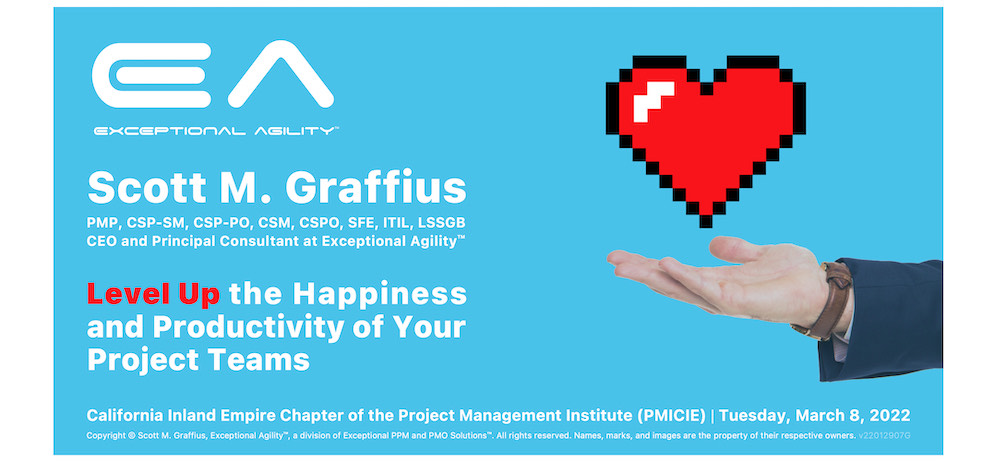
Scott M. Graffius will deliver a talk on project team development and leadership, “Level Up the Happiness and Productivity of Your Project Teams,” at an event of the California Inland Empire Chapter of the Project Management Institute (PMICIE). The session will be held on Tuesday, March 8, 2022, from 6:00-7:30 p.m. Pacific Time. Register at https://pmicie.org/events/calendar/future-meetings/march-8-2022-scott-m-graffius-level-up-the-happiness-and-productivity-of-your-project-teams.

About "Level Up the Happiness and Productivity of Your Project Teams"
Description
Want happier and more productive teams? Among other things, it takes great leadership. And proven strategies can provide a real edge! Enter Bruce Tuckman's phases of team development — a model that’s stood the test of time because it remains highly relevant and beneficial. If you are a leader (or aspire to be one), a member of a team (or may be in one in the future), or are just looking to develop your skills, this talk (based on Bruce Tuckman's model, but with a fresh angle: 0% theory, 100% real-world-based) will give you a practical framework with actionable tips for working in and leading teams of all types successfully. You'll learn about the five phases — Forming, Storming, Norming, Performing, and Adjourning — including detailed descriptions of each along with proven strategies for addressing challenges or issues which may occur along the way. You'll understand how to use the model to your advantage by effectively navigating all of the phases with speed and agility, from team set-up to the after-party! Which helps advance the teams’ happiness, productivity, and success.
The presentation draws on the speaker’s first-hand, real-world experience, with guidance supported by research, recommendations, and coverage from the Project Management Institute, Google, Microsoft, IEEE, MIT, Software Engineering Institute, Harvard Business Review, and many others.
Benefits/Key Learning Objectives
This talk will help attendees develop and enhance the contributions they make to their organizations by being able to:
- Understand the five stages of team development: Forming, Storming, Norming, Performing, and Adjourning.
- Learn the characteristics of each phase.
- Apply proven strategies to help handle challenges or issues experienced by teams. By doing so, they’ll advance the teams' (and their own) success.

About Scott M. Graffius

Scott M. Graffius, PMP, CSP-SM, CSP-PO, CSM, CSPO, SFE, ITIL, LSSGB is an agile project management practitioner, consultant, multi award-winning author, and international speaker. He has generated over $1.75 billion of business value in aggregate for the organizations he has served. Graffius is the founder, CEO, and principal consultant at Exceptional PPM and PMO Solutions™ and subsidiary Exceptional Agility™. His expertise spans project, program, portfolio, and PMO leadership inclusive of agile, traditional, and hybrid approaches. Content from his books (Agile Scrum and Agile Transformation), workshops, speaking engagements, and more have been featured and used by businesses, professional associations, governments, and universities including Microsoft, Oracle, Cisco, Gartner, Deloitte, Project Management Institute, IEEE, SANS Institute, U.S. Soccer Federation, English Institute of Sport, Ford, Qantas, Atlassian, Wrike, Bayer, National Academy of Sciences, United States Department of Energy, United States Army, New Zealand Ministry of Education, Amsterdam Public Health Research Institute, Tufts University, Texas A&M University, Warsaw University of Technology, University of Waterloo, National University of Ireland Galway, Zurich University of Applied Sciences, and others. Graffius has spoken at 59 conferences and other events around the world, including Armenia, Australia, Brazil, Canada, Czech Republic, Finland, France, Germany, Greece, Hungary, India, Ireland, Lithuania, Luxembourg, Netherlands, New Zealand, Sweden, United Arab Emirates, United Kingdom, and the United States. Thinkers360 named Graffius a global top thought leader and influencer in four domains: Agile, Change Management, Digital Transformation, and GovTech.
His full bio is available here.
Connect with Scott on:


About Agile Scrum: Your Quick Start Guide with Step-by-Step Instructions

Shifting customer needs are common in today's marketplace. Businesses must be adaptive and responsive to change while delivering an exceptional customer experience to be competitive.
There are a variety of frameworks supporting the development of products and services, and most approaches fall into one of two broad categories: traditional or agile. Traditional practices such as waterfall engage sequential development, while agile involves iterative and incremental deliverables. Organizations are increasingly embracing agile to manage projects, and best meet their business needs of rapid response to change, fast delivery speed, and more.
With clear and easy to follow step-by-step instructions, Scott M. Graffius's award-winning Agile Scrum: Your Quick Start Guide with Step-by-Step Instructions helps the reader:
- Implement and use the most popular agile framework―Scrum;
- Deliver products in short cycles with rapid adaptation to change, fast time-to-market, and continuous improvement; and
- Support innovation and drive competitive advantage.
Hailed by Literary Titan as “the book highlights the versatility of Scrum beautifully.”
Winner of 17 first place awards.
Agile Scrum: Your Quick Start Guide with Step-by-Step Instructions is available in paperback and ebook/Kindle in the United States and around the world. Some links by country follow.
- 🇧🇷 Brazil
- 🇨🇦 Canada
- 🇨🇿 Czech Republic
- 🇩🇰 Denmark
- 🇫🇮 Finland
- 🇫🇷 France
- 🇩🇪 Germany
- 🇬🇷 Greece
- 🇭🇺 Hungary
- 🇮🇳 India
- 🇮🇪 Ireland
- 🇮🇱 Israel
- 🇮🇹 Italy
- 🇯🇵 Japan
- 🇱🇺 Luxembourg
- 🇲🇽 Mexico
- 🇳🇱 Netherlands
- 🇳🇿 New Zealand
- 🇳🇴 Norway
- 🇪🇸 Spain
- 🇸🇪 Sweden
- 🇨🇭 Switzerland
- 🇦🇪 UAE
- 🇬🇧 United Kingdom
- 🇺🇸 United States

About Agile Transformation: A Brief Story of How an Entertainment Company Developed New Capabilities and Unlocked Business Agility to Thrive in an Era of Rapid Change

Thriving in today's marketplace frequently depends on making a transformation to become more agile. Those successful in the transition enjoy faster delivery speed and ROI, higher satisfaction, continuous improvement, and additional benefits.
Based on actual events, Agile Transformation: A Brief Story of How an Entertainment Company Developed New Capabilities and Unlocked Business Agility to Thrive in an Era of Rapid Change provides a quick (60-90 minute) read about a successful agile transformation at a multinational entertainment and media company, told from the author's perspective as an agile coach.
The award-winning book by Scott M. Graffius is available in paperback and ebook/Kindle in the United States and around the world. Some links by country follow.
- 🇦🇺 Australia
- 🇦🇹 Austria
- 🇧🇷 Brazil
- 🇨🇦 Canada
- 🇨🇿 Czech Republic
- 🇩🇰 Denmark
- 🇫🇮 Finland
- 🇫🇷 France
- 🇩🇪 Germany
- 🇬🇷 Greece
- 🇮🇳 India
- 🇮🇪 Ireland
- 🇯🇵 Japan
- 🇱🇺 Luxembourg
- 🇲🇽 Mexico
- 🇳🇱 Netherlands
- 🇳🇿 New Zealand
- 🇪🇸 Spain
- 🇸🇪 Sweden
- 🇨🇭 Switzerland
- 🇦🇪 United Arab Emirates
- 🇬🇧 United Kingdom
- 🇺🇸 United States

About the California Inland Empire Chapter of the Project Management Institute
Chartered by the Project Management Institute (PMI) in 2002, the PMI California Inland Empire Chapter (PMICIE) is committed to the advancement of the project management profession and is focused on enhancing the growth of its members through networking, training, and professional development opportunities. The PMICIE’s mission, vision, and core values follow.
Mission
The PMICIE’s mission is to connect with its community to:
- Recognize the value of project management.
- Advance the practice of project management.
- Deliver successful project results.
- Improve their professional and personal lives.
Vision
The PMICIE’s vision is to be recognized in the California Inland Empire area as a dynamic organization dedicated to serving its communities through the advancement of the project management profession.
Core Values
The PMICIE’s core values provide continuity and a moral compass, communicating its key beliefs and guiding its behavior:
- Trust and Integrity
- Collaboration
- Accountability
- Commitment
- Excellence
- Engagement
- Creativity and Innovation
To learn more about the PMICIE, visit https://pmicie.org.

About the Project Management Institute
The Project Management Institute (PMI) is the world's leading professional association for a growing community of millions of project professionals and change-makers worldwide. As the leading authority on project management, the PMI empowers people to make ideas a reality. Through global advocacy, networking, collaboration, research, and education, the PMI helps prepare organizations and individuals to work smarter in a dynamic and rapidly changing world.
Building on a prominent legacy dating to 1969, the PMI is a “for-purpose” organization working in nearly every country around the world to advance careers, strengthen organizational success, and enable change-makers with new skills and ways of working to maximize their impact. The PMI provides global standards, certifications, online courses, thought leadership, tools, digital publications, communities, and more.
To learn more about the PMI, visit https://www.pmi.org/.

The short link for this article is: https://bit.ly/blg-up
The event covered by this article appears in the Public Speaker section of the website, here
© Copyright 2022 Scott M. Graffius. All rights reserved. This material may not be published, broadcast, rewritten or redistributed without the express written permission of Scott M. Graffius.

Scott M. Graffius Speaking at Microsoft #TeamsCommunityDay 2022
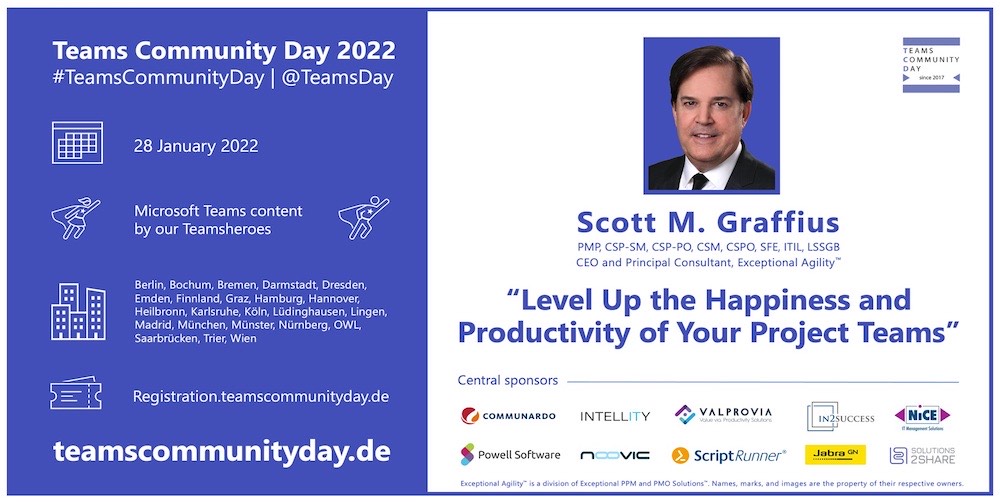
Scott M. Graffius will deliver a talk on project team development and leadership, “Level Up the Happiness and Productivity of Your Project Teams,” at Microsoft #TeamsCommunityDay. Created in 2017, Teams Community Day is a free community-driven annual conference providing talks and workshops in German and English from experts around the world. The 2022 event will take place online and in-person on January 28th from 22 locations: Berlin, Bochum, Bremen, Cologne, Dresden, Emden, Graz, Hamburg, Hanover, Heilbronn, Karlsruhe, Lingen, London, Lüdinghausen, Madrid, Munich, Münster, Nürnberg, OWL (Paderborn, Bielefeld, Gütersloh, Herford, and Lippstadt), Saarbrücken, Trier-Föhren, and Vienna. To register for the event, visit https://teamscommunityday.de/en/registration-2022/.

About "Level Up the Happiness and Productivity of Your Project Teams"
Description
Want happier and more productive teams? Among other things, it takes great leadership. And proven strategies can provide a real edge! Enter Bruce Tuckman's phases of team development — a model that’s stood the test of time because it remains highly relevant and beneficial. If you are a leader (or aspire to be one), a member of a team (or may be in one in the future), or are just looking to develop your skills, this talk (based on Bruce Tuckman's model, but with a fresh angle: 0% theory, 100% real-world-based) will give you a practical framework with actionable tips for working in and leading teams of all types successfully. You'll learn about the five phases — Forming, Storming, Norming, Performing, and Adjourning — including detailed descriptions of each along with proven strategies for addressing challenges or issues which may occur along the way. You'll understand how to use the model to your advantage by effectively navigating all of the phases with speed and agility, from team set-up to the after-party! Which helps advance the teams’ happiness, productivity, and success.
The presentation draws on the speaker’s first-hand, real-world experience, with guidance supported by research, recommendations, and coverage from Microsoft, Google, IEEE, MIT, Project Management Institute, Software Engineering Institute, Harvard Business Review, and many others.
Benefits/Key Learning Objectives
This talk will help attendees develop and enhance the contributions they make to their organizations by being able to:
- Understand the five stages of team development: Forming, Storming, Norming, Performing, and Adjourning.
- Learn the characteristics of each phase.
- Apply proven strategies to help handle challenges or issues experienced by teams. By doing so, they’ll advance the teams' (and their own) success.


About Scott M. Graffius

Scott M. Graffius, PMP, CSP-SM, CSP-PO, CSM, CSPO, SFE, ITIL, LSSGB is an agile project management practitioner, consultant, award-winning author, and international speaker. He has generated over 1.75 billion dollars of business value in aggregate for the organizations he has served. Graffius is the founder, CEO, and principal consultant at Exceptional PPM and PMO Solutions™ and subsidiary Exceptional Agility™, based in Los Angeles, California. His expertise spans project, program, portfolio, and PMO leadership inclusive of agile, traditional, and hybrid approaches. Content from his books (Agile Scrum and Agile Transformation), workshops, speaking engagements, and more have been featured and used by businesses, governments, and universities including Gartner, Microsoft, Deloitte, Oracle, Cisco, Ford, Qantas, Atlassian, Bayer, the National Academy of Sciences, the United States Department of Energy, the United States Army, Project Management Institute, the IEEE, the New Zealand Ministry of Education, Tufts University, Texas A&M University, Virginia Tech, Penn State, Warsaw University of Technology, University of Waterloo, Loughborough University London, and others. Graffius has spoken at 58 conferences and other events around the world, including Armenia, Australia, Brazil, Canada, Czech Republic, Finland, France, Germany, Greece, India, Ireland, Lithuania, Luxembourg, Netherlands, New Zealand, Sweden, United Kingdom, and the United States. Thinkers360 named Graffius a global top thought leader and influencer in four domains: Agile, Change Management, Digital Transformation, and GovTech.
His full bio is available here.
Connect with Scott on:


About Agile Scrum: Your Quick Start Guide with Step-by-Step Instructions

Shifting customer needs are common in today's marketplace. Businesses must be adaptive and responsive to change while delivering an exceptional customer experience to be competitive.
There are a variety of frameworks supporting the development of products and services, and most approaches fall into one of two broad categories: traditional or agile. Traditional practices such as waterfall engage sequential development, while agile involves iterative and incremental deliverables. Organizations are increasingly embracing agile to manage projects, and best meet their business needs of rapid response to change, fast delivery speed, and more.
With clear and easy to follow step-by-step instructions, Scott M. Graffius's award-winning Agile Scrum: Your Quick Start Guide with Step-by-Step Instructions helps the reader:
- Implement and use the most popular agile framework―Scrum;
- Deliver products in short cycles with rapid adaptation to change, fast time-to-market, and continuous improvement; and
- Support innovation and drive competitive advantage.
Hailed by Literary Titan as “the book highlights the versatility of Scrum beautifully.”
Winner of 17 first place awards.
Agile Scrum: Your Quick Start Guide with Step-by-Step Instructions is available in paperback and ebook/Kindle in the United States and around the world. Some links by country follow.
- 🇧🇷 Brazil
- 🇨🇦 Canada
- 🇨🇿 Czech Republic
- 🇩🇰 Denmark
- 🇫🇮 Finland
- 🇫🇷 France
- 🇩🇪 Germany
- 🇬🇷 Greece
- 🇭🇺 Hungary
- 🇮🇳 India
- 🇮🇪 Ireland
- 🇮🇱 Israel
- 🇮🇹 Italy
- 🇯🇵 Japan
- 🇱🇺 Luxembourg
- 🇲🇽 Mexico
- 🇳🇱 Netherlands
- 🇳🇿 New Zealand
- 🇳🇴 Norway
- 🇪🇸 Spain
- 🇸🇪 Sweden
- 🇨🇭 Switzerland
- 🇦🇪 UAE
- 🇬🇧 United Kingdom
- 🇺🇸 United States

About Agile Transformation: A Brief Story of How an Entertainment Company Developed New Capabilities and Unlocked Business Agility to Thrive in an Era of Rapid Change

Thriving in today's marketplace frequently depends on making a transformation to become more agile. Those successful in the transition enjoy faster delivery speed and ROI, higher satisfaction, continuous improvement, and additional benefits.
Based on actual events, Agile Transformation: A Brief Story of How an Entertainment Company Developed New Capabilities and Unlocked Business Agility to Thrive in an Era of Rapid Change provides a quick (60-90 minute) read about a successful agile transformation at a multinational entertainment and media company, told from the author's perspective as an agile coach.
The award-winning book by Scott M. Graffius is available in paperback and ebook/Kindle in the United States and around the world. Some links by country follow.
- 🇦🇺 Australia
- 🇦🇹 Austria
- 🇧🇷 Brazil
- 🇨🇦 Canada
- 🇨🇿 Czech Republic
- 🇩🇰 Denmark
- 🇫🇮 Finland
- 🇫🇷 France
- 🇩🇪 Germany
- 🇬🇷 Greece
- 🇮🇳 India
- 🇮🇪 Ireland
- 🇯🇵 Japan
- 🇱🇺 Luxembourg
- 🇲🇽 Mexico
- 🇳🇱 Netherlands
- 🇳🇿 New Zealand
- 🇪🇸 Spain
- 🇸🇪 Sweden
- 🇨🇭 Switzerland
- 🇦🇪 United Arab Emirates
- 🇬🇧 United Kingdom
- 🇺🇸 United States

About Microsoft #TeamsCommunityDay
Created in 2017, Teams Community Day is a free community-driven annual conference providing talks and workshops in German and English from experts around the world.
The 2022 event will take place online and in-person on January 28th from 22 locations: Berlin, Bochum, Bremen, Cologne, Dresden, Emden, Graz, Hamburg, Hanover, Heilbronn, Karlsruhe, Lingen, London, Lüdinghausen, Madrid, Munich, Münster, Nürnberg, OWL (Paderborn, Bielefeld, Gütersloh, Herford, and Lippstadt), Saarbrücken, Trier-Föhren, and Vienna.
To learn more, visit https://teamscommunityday.de.

The short link for this article is: https://bit.ly/tcd2022
The short link for a related post on LinkedIn is: https://bit.ly/link-tcd
The event covered by this article appears in the Public Speaker section of the website, here
© Copyright 2021 Scott M. Graffius. All rights reserved. This material may not be published, broadcast, rewritten or redistributed without the express written permission of Scott M. Graffius.

Scott M. Graffius Delivered 40 Talks and Workshops Across 17 Countries in 2021
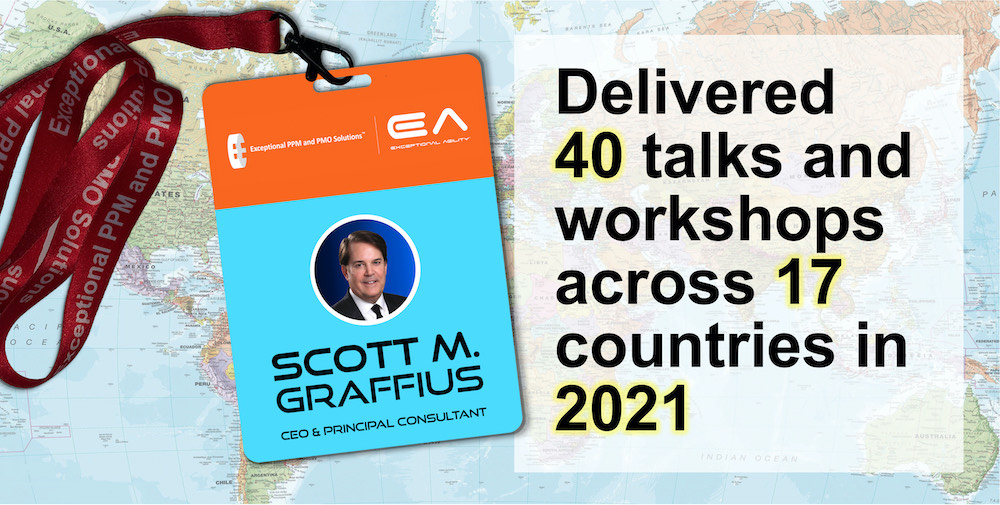
In 2021, Scott M. Graffius delivered 40 dynamic and engaging talks and workshops across 17 countries. His sessions spanned leadership, technical project management (inclusive of agile, waterfall, and hybrid approaches to project, program, portfolio, and PMO management), and strategic and business management. He incorporated everyday language and vibrant custom visuals to make complex topics clear and understandable, and he provided audiences with practical information they can use. His engagements were highly rated by attendees and event organizers alike.
Here's an abridged list his 40 sessions in 2021 (most recent shown first):
- 🇺🇸 | Private event
- 🇺🇸 | Private event
- 🇺🇸 | DevOps Experience 2021 Conference
- 🇦🇲 | Frug'Agile Conference Armenia 2021
- 🇺🇸 | Private event
- 🇺🇸 | IEEE Day 2021
- 🇧🇷 | Private event
- 🇬🇧 | BSides Newcastle England 2021 InfoSec Conference
- 🇺🇸 | Private event
- 🇧🇷 | Agile Trends Gov Conference 2021
- 🇺🇸 | Private event
- 🇭🇰 | Private event
- 🇺🇸 | Florida Suncoast Chapter of the Project Management Institute
- 🇺🇸 | Private event
- 🇺🇸 | Central Virginia Chapter of the Project Management Institute
- 🇸🇪 | Private event
- 🇱🇹 | DevOps Pro Europe 2021 Conference
- 🇺🇸 | Southwest Virginia Chapter of the Project Management Institute
- 🇬🇧 | Private event
- 🇱🇺 | Luxembourg Chapter of the Project Management Institute
- 🇬🇧 | Private event
- 🇺🇸 | Monterey Bay Chapter of the Project Management Institute
- 🇦🇺 | Private event
- 🇳🇿 | New Zealand Chapter of the Project Management Institute
- 🇮🇪 | Private event
- 🇺🇸 | Southern Nevada Chapter of the Project Management Institute
- 🇺🇸 | California Institute of Advanced Management
- 🇦🇺 | Private event
- 🇬🇧 | Scottish Summit 2021
- 🇫🇮 | Finland Chapter of the Project Management Institute
- 🇨🇦 | ConFoo Developer Conference 2021
- 🇺🇸 | Private event
- 🇨🇿 | DevConf.CZ 2021 Conference
- 🇺🇸 | Private event
- 🇺🇸 | California Inland Empire Chapter of Project Management Institute
- 🇺🇸 | Private event
- 🇩🇪 | Private event
- 🇺🇸 | Alaska Chapter of the Project Management Institute
- 🇺🇸 | North Alabama Chapter of Project Management Institute
- 🇳🇱 | Netherlands Chapter of the Project Management Institute
Visit here for detailed listings, videos (where available), testimonials, and more.

About Scott M. Graffius

Scott M. Graffius, PMP, CSP-SM, CSP-PO, CSM, CSPO, SFE, ITIL, LSSGB is an agile project management practitioner, consultant, multi award-winning author, and international speaker. He has generated over 1.75 billion dollars of business value in aggregate for the organizations he has served. His expertise spans project, program, portfolio, and PMO leadership inclusive of agile, traditional, and hybrid approaches. Content from Graffius's books, workshops, speaking engagements, and more have been featured and used by businesses, professional associations, governments, and universities including Microsoft, Oracle, Cisco, Gartner, Deloitte, Project Management Institute, IEEE, SANS Institute, Ford, Qantas, Atlassian, Wrike, Bayer, National Academy of Sciences, United States Department of Energy, United States Army, New Zealand Ministry of Education, Amsterdam Public Health Research Institute, Tufts University, Texas A&M University, Virginia Tech, Penn State, Warsaw University of Technology, University of Waterloo, National University of Ireland Galway, Loughborough University London, Zurich University of Applied Sciences, and others. Thinkers360 named Graffius a global top thought leader and influencer in four domains: Agile, Change Management, Digital Transformation, and GovTech.
Graffius is the founder, CEO, and principal consultant at Exceptional PPM and PMO Solutions™ and subsidiary Exceptional Agility™, based in Los Angeles, California. The professional services firm provides client organizations with advisory, training, speaking, embedded talent, and facilitative consulting services to help them advance their agile project, program, portfolio, and PMO management capabilities to best realize their strategic objectives and business initiatives, making them more competitive and valuable. The company confidently backs its services with a Delighted Client Guarantee™.
A fantastic agile transformation experience and result with a client organization in the entertainment industry was the inspiration for Graffius’s first book, Agile Scrum: Your Quick Start Guide with Step-by-Step Instructions (ISBN-13: 9781533370242). It helps technical and non-technical teams develop and deliver products in short cycles with rapid adaptation to change, fast time-to-market, and continuous improvement—which supports innovation and drives competitive advantage. The book garnered 17 first place awards from national and international competitions. His second title, Agile Transformation: A Brief Story of How an Entertainment Company Developed New Capabilities and Unlocked Business Agility to Thrive in an Era of Rapid Change (ISBN-13: 9781072447962), was named one of the best Scrum books of all time by BookAuthority. Graffius and his works have been featured by media outlets and publications including Yahoo Finance, Computer Weekly, MobileAppDaily, Innovation Management, the PM World Journal, NASSCOM, Software Quality Management, Nimble Ways, Business Application Monitoring, Learning Solutions, Innovation Ecosystem Metrics, DZone, Innovation Project Management (by Dr. Harold Kerzner), TopDevs, NHD Podcast, and others.
Graffius is a former vice president of project management with a publicly traded provider of diverse consumer products and services over the Internet. Before that, he ran and supervised the delivery of projects and programs in public and private organizations with businesses ranging from e-commerce to advanced technology products and services, retail, manufacturing, entertainment, and more. He has experience with consumer, business, reseller, government, and international markets, as well as experience spanning 20 countries.
Graffius has a bachelor's degree in Psychology with a focus in Human Factors. He holds eight professional certifications: Certified Scrum Professional - ScrumMaster (CSP-SM), Certified Scrum Professional - Product Owner (CSP-PO), Certified ScrumMaster (CSM), Certified Scrum Product Owner (CSPO), Scrum Foundations Educator (SFE), Project Management Professional (PMP), Lean Six Sigma Green Belt (LSSGB), and IT Service Management Foundation (ITIL). He is a member of the Scrum Alliance, the Project Management Institute (PMI), and the Institute of Electrical and Electronics Engineers (IEEE).
He has been actively involved with the Project Management Institute (PMI) in the development of professional standards. He was a member of the team which produced the Practice Standard for Work Breakdown Structures—Second Edition. Graffius was a contributor and reviewer of A Guide to the Project Management Body of Knowledge—Sixth Edition, The Standard for Program Management—Fourth Edition, and The Practice Standard for Project Estimating—Second Edition. He was also a subject matter expert reviewer of content for the PMI EMEA Congress 2019, and he served as a member of the review team for the Scrum Alliance’s Global Scrum Gathering—New York City 2020.
Graffius delivers dynamic and engaging talks and workshops at public and private/corporate events. His engagements include 59 in-person and online conferences and other events around the world, including Armenia, Australia, Brazil, Canada, Czech Republic, Finland, France, Germany, Greece, Hungary, India, Ireland, Lithuania, Luxembourg, Netherlands, New Zealand, Sweden, United Arab Emirates, United Kingdom, and the United States. Graffius delights audiences with sessions on technology leadership and project, program, portfolio, and PMO management inclusive of agile, waterfall, and hybrid approaches. He uses everyday language and vibrant custom visuals to make complex topics clear, and he provides audiences with practical information they can use. For details, visit the public speaker section of his website here.
He resides in Los Angeles, California.
His full bio is available here.
Connect with Scott on:


About Agile Scrum: Your Quick Start Guide with Step-by-Step Instructions

Shifting customer needs are common in today's marketplace. Businesses must be adaptive and responsive to change while delivering an exceptional customer experience to be competitive.
There are a variety of frameworks supporting the development of products and services, and most approaches fall into one of two broad categories: traditional or agile. Traditional practices such as waterfall engage sequential development, while agile involves iterative and incremental deliverables. Organizations are increasingly embracing agile to manage projects, and best meet their business needs of rapid response to change, fast delivery speed, and more.
With clear and easy to follow step-by-step instructions, Scott M. Graffius's award-winning Agile Scrum: Your Quick Start Guide with Step-by-Step Instructions helps the reader:
- Implement and use the most popular agile framework―Scrum;
- Deliver products in short cycles with rapid adaptation to change, fast time-to-market, and continuous improvement; and
- Support innovation and drive competitive advantage.
Hailed by Literary Titan as “the book highlights the versatility of Scrum beautifully.”
Winner of 17 first place awards.
Agile Scrum: Your Quick Start Guide with Step-by-Step Instructions is available in paperback and ebook/Kindle in the United States and around the world. Some links by country follow.
- 🇧🇷 Brazil
- 🇨🇦 Canada
- 🇨🇿 Czech Republic
- 🇩🇰 Denmark
- 🇫🇮 Finland
- 🇫🇷 France
- 🇩🇪 Germany
- 🇬🇷 Greece
- 🇭🇺 Hungary
- 🇮🇳 India
- 🇮🇪 Ireland
- 🇮🇱 Israel
- 🇮🇹 Italy
- 🇯🇵 Japan
- 🇱🇺 Luxembourg
- 🇲🇽 Mexico
- 🇳🇱 Netherlands
- 🇳🇿 New Zealand
- 🇳🇴 Norway
- 🇪🇸 Spain
- 🇸🇪 Sweden
- 🇨🇭 Switzerland
- 🇦🇪 UAE
- 🇬🇧 United Kingdom
- 🇺🇸 United States

About Agile Transformation: A Brief Story of How an Entertainment Company Developed New Capabilities and Unlocked Business Agility to Thrive in an Era of Rapid Change

Thriving in today's marketplace frequently depends on making a transformation to become more agile. Those successful in the transition enjoy faster delivery speed and ROI, higher satisfaction, continuous improvement, and additional benefits.
Based on actual events, Agile Transformation: A Brief Story of How an Entertainment Company Developed New Capabilities and Unlocked Business Agility to Thrive in an Era of Rapid Change provides a quick (60-90 minute) read about a successful agile transformation at a multinational entertainment and media company, told from the author's perspective as an agile coach.
The award-winning book by Scott M. Graffius is available in paperback and ebook/Kindle in the United States and around the world. Some links by country follow.
- 🇦🇺 Australia
- 🇦🇹 Austria
- 🇧🇷 Brazil
- 🇨🇦 Canada
- 🇨🇿 Czech Republic
- 🇩🇰 Denmark
- 🇫🇮 Finland
- 🇫🇷 France
- 🇩🇪 Germany
- 🇬🇷 Greece
- 🇮🇳 India
- 🇮🇪 Ireland
- 🇯🇵 Japan
- 🇱🇺 Luxembourg
- 🇲🇽 Mexico
- 🇳🇱 Netherlands
- 🇳🇿 New Zealand
- 🇪🇸 Spain
- 🇸🇪 Sweden
- 🇨🇭 Switzerland
- 🇦🇪 United Arab Emirates
- 🇬🇧 United Kingdom
- 🇺🇸 United States

The short link for this article is: https://bit.ly/40-in-2021
The short link for a related post on LinkedIn is: https://bit.ly/21-in
© Copyright 2021 Scott M. Graffius. All rights reserved. This material may not be published, broadcast, rewritten or redistributed without the express written permission of Scott M. Graffius.

Use the Phases of Team Development (Based on Bruce W. Tuckman's Model of Forming, Storming, Norming, Performing, and Adjourning) to Help Teams Grow and Advance: 2022 Update
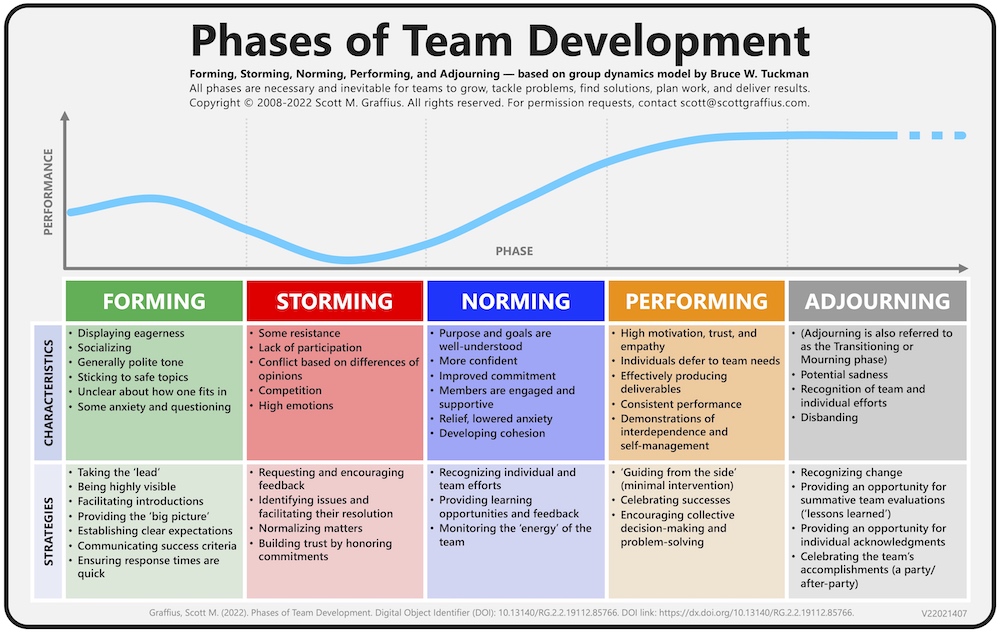
High Resolution Files of Visual: See Permission Request Information section

If there are any supplements or updates to this article after the date of publication, they will appear in the Post-Publication Notes section at the end of this article.

2022 Update
Want happier and more productive teams? Among other things, it takes great leadership. And proven strategies can provide a real edge! That’s where the groundbreaking work by Bruce W. Tuckman — Ph.D. in Psychology from Princeton — comes in.
Tuckman conducted extensive research on group dynamics, and he published a related model in 1965. At that time, the model included four phases: forming, storming, norming, and performing. However, Dr. Tuckman subsequently determined that adjourning was so important that he, with Mary Ann Jensen, updated his model in 1977 to add adjourning as the fifth phase. According to Tuckman, all five phases — Forming, Storming, Norming, Performing, and Adjourning — are necessary for teams to grow, tackle problems, find solutions, plan work, and deliver results.
Tuckman’s model has stood the test of time because it remains highly relevant and beneficial. Since his work was published, it has been supported by additional peer-reviewed research. And it has received recommendations and coverage from leading organizations including Google, Harvard Business Review, IEEE, MIT, Fast Company, NASA, Microsoft, TNW, Project Management Institute, Scrum Alliance, Scrum.org, Gartner, CIO, RAND Corporation, Software Engineering Institute, University of Edinburgh, Cisco, KPMG, Warsaw University of Technology, Software Engineering Institute, DevOps Institute, American Express, SANS Institute, Zurich University, SAP, ViacomCBS, Oxford University, American Management Association, AT&T, University of Southern California, IBM, and many others.
Agile project management practitioner, consultant, award-winning author, international speaker, thought leader, and influencer Scott M. Graffius developed a related custom illustration, Phases of Team Development. It highlights the performance level, characteristics, and proven strategies for each of the five phases. Project Managers, Scrum Masters, Agile Coaches, DevOps Leads, and other professionals can apply the information to help handle challenges or issues experienced by teams. By doing so, they’ll advance the teams' happiness, productivity, and success.
Graffius updates the content periodically. He released an updated version of the visual on February 14, 2022. This article features the newest version of the Phases of Team Development illustration. Read on for details including information on permission requests and downloadable high-resolution versions of the image.

Five Phases of Team Development
1. Forming
Characteristics of Forming include displaying eagerness, socializing, generally polite tone, sticking to safe topics, unclear about how one fits in, and some anxiety and questioning.
Strategies for this phase include taking the ‘lead,’ being highly visible, facilitating introductions, providing the ‘big picture,’ establishing clear expectations, communicating success criteria, and ensuring response times are quick.
2. Storming
Traits of Storming include some resistance, lack of participation, conflict based on differences of opinions, competition, and high emotions.
Strategies for this phase include requesting and encouraging feedback, identifying issues and facilitating their resolution, normalizing matters, and building trust by honoring commitments.
3. Norming
Features of Norming include purpose and goals are well-understood, more confident, improved commitment, members are engaged and supportive, relief (lowered anxiety), and developing cohesion.
Strategies for this phase include recognizing individual and team efforts, providing learning opportunities and feedback, and monitoring the ‘energy’ of the team.
4. Performing
Characteristics of Performing include high motivation, trust, and empathy; individuals defer to team needs; effectively producing deliverables; consistent performance; and demonstrations of interdependence and self-management.
Strategies for this phase include ‘guiding from the side’ (minimal intervention), celebrating successes, and encouraging collective decision-making and problem-solving.
5. Adjourning
Typical traits of Adjourning (also referred to as Transitioning or Mourning) include potential sadness, recognition of team and individual efforts, and disbanding.
Strategies for this phase include recognizing change, providing an opportunity for summative team evaluations ('lessons learned'), providing an opportunity for individual acknowledgments, and celebrating the team’s accomplishments — which may involve a party and possibly an after-party.

As shown, performance fluctuates as teams move through the phases. Review the characteristics to help identify the team's current phase, then apply the corresponding proven strategies to help them advance.

Permission Request Information
To request permission to use the 'Phases of Team Development' visual, contact Scott M. Graffius. If approved, high resolution JPG and PNG image files will be provided, subject to terms and conditions.

Bibliography
Select (partial) list of publications
- Alford, J. (2019, April 11). Our Co-Production Journey: From Sandpits to Bird Boxes. London, United Kingdom: Imperial College London.
- Bennett, M., Gadlin, H., & Marchand, C. (2018). Collaboration Team Science: Field Guide. Rockville, MD: National Institutes of Health.
- Couture, N. (2016, October 27). A Note About Teams. CIO. Boston, MA: International Data Group (IDG).
- Daly, L. (2002). Identify Your Project Management Team’s Level of Development and Facilitate It to Success. Paper presented at Project Management Institute Annual Seminars and Symposium, San Antonio, TX. Newtown Square, PA: Project Management Institute.
- Deloitte (2017). Digital Era Technology Operating Models, Volume 2. New York, NY: Deloitte Touche Tohmatsu Limited.
- Finkelstein, S. (2017, October 29). Why Companies Should Hire Teams, Not Individuals. The Wall Street Journal. New York, NY: The Wall Street Journal.
- Forbes (2018, April 23). How to Fast-Track Any Team to Success. Forbes. New York, NY: Forbes.
- Forbes (2012, October 27). How the iPad Mini is Defining Tim Cook’s Apple. Forbes. New York, NY: Forbes.
- Glover, P. (2012, March 13). Team Conflict: Why It’s a Good Thing. Fast Company. New York, NY: Mansueto Ventures.
- Graffius, Scott M. (2021). Phases of Team Development. Los Angeles, CA: Scott M. Graffius. Digital Object Identifier (DOI): 10.13140/RG.2.2.22040.42246.
- Jovanovic, M., Mesquida, A., Radaković, N., & Mas, A. (2016). Agile Retrospective Games for Different Team Development Phases. Journal of Universal Computer Science, 22: 1489-1508.
- Kane, G. C. (2014, October 7). Why Your Company is Probably Measuring Social Media Wrong. MIT Sloan Management Review. Cambridge, MA: MIT Sloan Management Review.
- KPMG (2017). The Digital Fund, Season 2. Amstelveen, Netherlands: KPMG International.
- Madden, D. (2019, May 19). The Four Stages of Building a Great Team – and the One Where Things Usually Go Wrong. Inc. Magazine. New York, NY: Inc. Magazine.
- Makar, A. (2011, July 13). Lessons Learned in Norming and Performing Team Development Phases. Louisville, KY: TechRepublic.
- Martinuzzi, B. (2012, June 8). Six Tips Guaranteed to Reduce Workplace Frustrations. New York, NY: American Express Company.
- Microsoft (2019, June 15). Is the Latest Technology the Key to Your Team’s Success, or is There Something Else? Microsoft Developer Support. Accessed at: https://devblogs.microsoft.com/premier-developer/is-the-latest-technology-the-key-to-your-teams-success-or-is-there-something-else. Redmond, WA: Microsoft.
- Mocko, G., & Linnerud, B. (2016). Measuring the Effects of Goal Alignment on Innovative Engineering Design Projects. International Journal of Engineering Education, 32: 55-63.
- Romanelli, M. (2019, September 11). Teamwork Accelerated. PM Times. Newmarket, Ontario, Canada: Macgregor Communications.
- Riggs, A. (2020, October 15). Why I Start All My Video Meetings with Collaborative Games (Spoiler: It’s Not Boredom). Amsterdam, the Netherlands: The Next Web (TNW).
- Rowley, D., & Lange, M. (2007). Forming to Performing: The Evolution of an Agile Team. IEEE Computer Society Proceedings. Agile 2007, 1: 408-414.
- Scrum Alliance (2020). Learning Objectives Examples. Denver, CO: Scrum Alliance.
- Sakpal, M. (2020, March 3. Learn How to Debunk These Five Restructuring Myths. Stamford, CT: Gartner, Inc.
- Stern, S. (2018, September 26). Is Your Team Working the Rory Underwood Way? Financial Times. London, United Kingdom: The Financial Times, a Nikkei Company.
- Telford, R. (2013, June 4). This is Where It Gets Interesting. Armonk, NY: International Business Machines (IBM) Corporation.
- Tuckman, B. W. (1965). Developmental Sequence in Small Groups. Psychological Bulletin, 63: 384-399.
- Tuckman, B. W., & Jensen, M. A. C. (1977). Stages of Small-Group Development Revisited. Group and Organizational Studies, 2 (4): 419-427.
- United States Army (2015). Innovative Learning: A Key to National Security. Washington, DC: United States Army.


About Scott M. Graffius

Scott M. Graffius, PMP, CSP-SM, CSP-PO, CSM, CSPO, SFE, ITIL, LSSGB is an agile project management practitioner, consultant, multi award-winning author, and international speaker. He has generated over 1.75 billion dollars of business value in aggregate for the organizations he has served. Graffius is the CEO and Principal Consultant at Exceptional PPM and PMO Solutions™ and subsidiary Exceptional Agility™. His expertise spans project, program, portfolio, and PMO leadership inclusive of agile, traditional, and hybrid approaches. Content from his books, workshops, speaking engagements, and more have been featured and used by businesses, professional associations, governments, and universities including Microsoft, Oracle, Cisco, Gartner, Deloitte, Project Management Institute, IEEE, SANS Institute, U.S. Soccer Federation, English Institute of Sport, Ford, Qantas, Atlassian, Wrike, Bayer, National Academy of Sciences, United States Department of Energy, United States Army, New Zealand Ministry of Education, Amsterdam Public Health Research Institute, Tufts University, Texas A&M University, Warsaw University of Technology, University of Waterloo, National University of Ireland Galway, Zurich University of Applied Sciences, and others. Graffius has spoken at 67 conferences and other events around the world, including Armenia, Australia, Brazil, Canada, Czech Republic, Finland, France, Germany, Greece, Hungary, India, Ireland, Lithuania, Luxembourg, Netherlands, New Zealand, Sweden, United Arab Emirates, United Kingdom, and the United States. Thinkers360 named Graffius a global top thought leader and influencer in four domains: Agile, Change Management, Digital Transformation, and GovTech.
His full bio is available here.
Connect with Scott on:


About Agile Scrum: Your Quick Start Guide with Step-by-Step Instructions

Shifting customer needs are common in today's marketplace. Businesses must be adaptive and responsive to change while delivering an exceptional customer experience to be competitive.
There are a variety of frameworks supporting the development of products and services, and most approaches fall into one of two broad categories: traditional or agile. Traditional practices such as waterfall engage sequential development, while agile involves iterative and incremental deliverables. Organizations are increasingly embracing agile to manage projects, and best meet their business needs of rapid response to change, fast delivery speed, and more.
With clear and easy to follow step-by-step instructions, Scott M. Graffius's award-winning Agile Scrum: Your Quick Start Guide with Step-by-Step Instructions helps the reader:
- Implement and use the most popular agile framework―Scrum;
- Deliver products in short cycles with rapid adaptation to change, fast time-to-market, and continuous improvement; and
- Support innovation and drive competitive advantage.
Hailed by Literary Titan as “the book highlights the versatility of Scrum beautifully.”
Winner of 17 first place awards.
Agile Scrum: Your Quick Start Guide with Step-by-Step Instructions is available in paperback and ebook/Kindle in the United States and around the world. Some links by country follow.
- 🇧🇷 Brazil
- 🇨🇦 Canada
- 🇨🇿 Czech Republic
- 🇩🇰 Denmark
- 🇫🇮 Finland
- 🇫🇷 France
- 🇩🇪 Germany
- 🇬🇷 Greece
- 🇭🇺 Hungary
- 🇮🇳 India
- 🇮🇪 Ireland
- 🇮🇱 Israel
- 🇮🇹 Italy
- 🇯🇵 Japan
- 🇱🇺 Luxembourg
- 🇲🇽 Mexico
- 🇳🇱 Netherlands
- 🇳🇿 New Zealand
- 🇳🇴 Norway
- 🇪🇸 Spain
- 🇸🇪 Sweden
- 🇨🇭 Switzerland
- 🇦🇪 UAE
- 🇬🇧 United Kingdom
- 🇺🇸 United States

About Agile Transformation: A Brief Story of How an Entertainment Company Developed New Capabilities and Unlocked Business Agility to Thrive in an Era of Rapid Change

Thriving in today's marketplace frequently depends on making a transformation to become more agile. Those successful in the transition enjoy faster delivery speed and ROI, higher satisfaction, continuous improvement, and additional benefits.
Based on actual events, Agile Transformation: A Brief Story of How an Entertainment Company Developed New Capabilities and Unlocked Business Agility to Thrive in an Era of Rapid Change provides a quick (60-90 minute) read about a successful agile transformation at a multinational entertainment and media company, told from the author's perspective as an agile coach.
The award-winning book by Scott M. Graffius is available in paperback and ebook/Kindle in the United States and around the world. Some links by country follow.
- 🇦🇺 Australia
- 🇦🇹 Austria
- 🇧🇷 Brazil
- 🇨🇦 Canada
- 🇨🇿 Czech Republic
- 🇩🇰 Denmark
- 🇫🇮 Finland
- 🇫🇷 France
- 🇩🇪 Germany
- 🇬🇷 Greece
- 🇮🇳 India
- 🇮🇪 Ireland
- 🇯🇵 Japan
- 🇱🇺 Luxembourg
- 🇲🇽 Mexico
- 🇳🇱 Netherlands
- 🇳🇿 New Zealand
- 🇪🇸 Spain
- 🇸🇪 Sweden
- 🇨🇭 Switzerland
- 🇦🇪 United Arab Emirates
- 🇬🇧 United Kingdom
- 🇺🇸 United States

Post-Publication Notes
Update on 7 January 2025
Scott M. Graffius periodically updates his 'Phases of Team Development' work. The most current edition is here.

© Copyright 2022 Scott M. Graffius. All rights reserved. This material may not be published, broadcast, rewritten or redistributed without the express written permission of Scott M. Graffius.

Scott M. Graffius Speaking at Microsoft 365 Virtual Marathon 2022
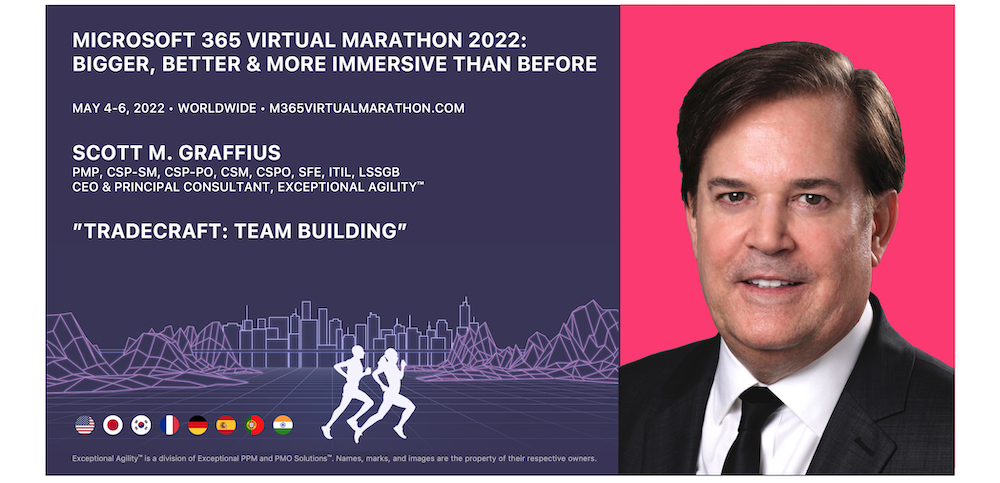
Click here to download this article as a PDF.
Scott M. Graffius will be speaking at one of the largest Microsoft events in the world – the Microsoft 365 Virtual Marathon 2022. It’s a 60-hour conference which will span from May 4-6, and it will feature talks from thought leaders around the world. Sessions will be presented in English, French, German, Japanese, Korean, Portuguese, and Spanish. Graffius's talk is “Tradecraft: Team Building.” To lean more and register for the event (which Microsoft has made free of charge!), visit the website for the conference here: https://www.m365virtualmarathon.com.

About "Tradecraft: Team Building"
Description
If you're a technology leader (or aspire to be one), a member of a tech team (or may be in one in the future), or are just looking to level up your leadership skills, this talk (based on Bruce Tuckman's model, but with an entirely fresh angle: 0% theory, 100% real-world-based) will give you a practical framework with actionable tips for working in and leading teams successfully.
You'll learn about the five phases—Forming, Storming, Norming, Performing, and Adjourning—including detailed descriptions of each along with proven strategies for addressing challenges or issues which may occur along the way. You'll understand how to use the model to your advantage by effectively navigating all of the phases with speed and agility, from team set-up to the after-party! By doing so, you’ll advance the teams' happiness, productivity, and success.
The session draws on the speaker's first-hand, real-world experience—with guidance supported by research, recommendations, and coverage from Microsoft, Google, Software Engineering Institute, MIT, IEEE, and many others.

About Scott M. Graffius

Scott M. Graffius, PMP, CSP-SM, CSP-PO, CSM, CSPO, SFE, ITIL, LSSGB is an agile project management practitioner, consultant, multi award-winning author, and international speaker. He has generated over $1.75 billion of business value in aggregate for the organizations he has served. Graffius is the founder, CEO, and principal consultant at Exceptional PPM and PMO Solutions™ and subsidiary Exceptional Agility™. His expertise spans project, program, portfolio, and PMO leadership inclusive of agile, traditional, and hybrid approaches. Content from his books (Agile Scrum and Agile Transformation), workshops, speaking engagements, and more have been featured and used by businesses, professional associations, governments, and universities including Microsoft, Oracle, Cisco, Gartner, Deloitte, Project Management Institute, IEEE, SANS Institute, U.S. Soccer Federation, English Institute of Sport, Ford, Qantas, Atlassian, Wrike, Bayer, National Academy of Sciences, United States Department of Energy, United States Army, New Zealand Ministry of Education, Amsterdam Public Health Research Institute, Tufts University, Texas A&M University, Warsaw University of Technology, University of Waterloo, National University of Ireland Galway, Zurich University of Applied Sciences, and others. Graffius has spoken at 67 conferences and other events around the world, including Armenia, Australia, Brazil, Canada, Czech Republic, Finland, France, Germany, Greece, Hungary, India, Ireland, Lithuania, Luxembourg, Netherlands, New Zealand, Sweden, United Arab Emirates, United Kingdom, and the United States. Thinkers360 named Graffius a global top thought leader and influencer in four domains: Agile, Change Management, Digital Transformation, and GovTech.
His full bio is available here.
Connect with Scott on:


About Agile Scrum: Your Quick Start Guide with Step-by-Step Instructions

Shifting customer needs are common in today's marketplace. Businesses must be adaptive and responsive to change while delivering an exceptional customer experience to be competitive.
There are a variety of frameworks supporting the development of products and services, and most approaches fall into one of two broad categories: traditional or agile. Traditional practices such as waterfall engage sequential development, while agile involves iterative and incremental deliverables. Organizations are increasingly embracing agile to manage projects, and best meet their business needs of rapid response to change, fast delivery speed, and more.
With clear and easy to follow step-by-step instructions, Scott M. Graffius's award-winning Agile Scrum: Your Quick Start Guide with Step-by-Step Instructions helps the reader:
- Implement and use the most popular agile framework―Scrum;
- Deliver products in short cycles with rapid adaptation to change, fast time-to-market, and continuous improvement; and
- Support innovation and drive competitive advantage.
Hailed by Literary Titan as “the book highlights the versatility of Scrum beautifully.”
Winner of 17 first place awards.
Agile Scrum: Your Quick Start Guide with Step-by-Step Instructions is available in paperback and ebook/Kindle in the United States and around the world. Some links by country follow.
- 🇧🇷 Brazil
- 🇨🇦 Canada
- 🇨🇿 Czech Republic
- 🇩🇰 Denmark
- 🇫🇮 Finland
- 🇫🇷 France
- 🇩🇪 Germany
- 🇬🇷 Greece
- 🇭🇺 Hungary
- 🇮🇳 India
- 🇮🇪 Ireland
- 🇮🇱 Israel
- 🇮🇹 Italy
- 🇯🇵 Japan
- 🇱🇺 Luxembourg
- 🇲🇽 Mexico
- 🇳🇱 Netherlands
- 🇳🇿 New Zealand
- 🇳🇴 Norway
- 🇪🇸 Spain
- 🇸🇪 Sweden
- 🇨🇭 Switzerland
- 🇦🇪 UAE
- 🇬🇧 United Kingdom
- 🇺🇸 United States

About Agile Transformation: A Brief Story of How an Entertainment Company Developed New Capabilities and Unlocked Business Agility to Thrive in an Era of Rapid Change

Thriving in today's marketplace frequently depends on making a transformation to become more agile. Those successful in the transition enjoy faster delivery speed and ROI, higher satisfaction, continuous improvement, and additional benefits.
Based on actual events, Agile Transformation: A Brief Story of How an Entertainment Company Developed New Capabilities and Unlocked Business Agility to Thrive in an Era of Rapid Change provides a quick (60-90 minute) read about a successful agile transformation at a multinational entertainment and media company, told from the author's perspective as an agile coach.
The award-winning book by Scott M. Graffius is available in paperback and ebook/Kindle in the United States and around the world. Some links by country follow.
- 🇦🇺 Australia
- 🇦🇹 Austria
- 🇧🇷 Brazil
- 🇨🇦 Canada
- 🇨🇿 Czech Republic
- 🇩🇰 Denmark
- 🇫🇮 Finland
- 🇫🇷 France
- 🇩🇪 Germany
- 🇬🇷 Greece
- 🇮🇳 India
- 🇮🇪 Ireland
- 🇯🇵 Japan
- 🇱🇺 Luxembourg
- 🇲🇽 Mexico
- 🇳🇱 Netherlands
- 🇳🇿 New Zealand
- 🇪🇸 Spain
- 🇸🇪 Sweden
- 🇨🇭 Switzerland
- 🇦🇪 United Arab Emirates
- 🇬🇧 United Kingdom
- 🇺🇸 United States

About Microsoft
Microsoft (Nasdaq “MSFT” @microsoft) enables digital transformation for the era of an intelligent cloud and an intelligent edge. Its mission is to empower every person and every organization on the planet to achieve more. To learn more, visit https://www.microsoft.com.

The short link for this article is: https://bit.ly/mvm-smg
The short link for a related post on LinkedIn is: https://bit.ly/m365vm-in
The short link for a related post in Instagram is: https://bit.ly/m365vm-ig
The event covered by this article appears in the Public Speaker section of the website
© Copyright 2022 Scott M. Graffius. All rights reserved. This material may not be published, broadcast, rewritten or redistributed without the express written permission of Scott M. Graffius.

'Phases of Team Development' by Scott M. Graffius Featured by Hasso Plattner Institute
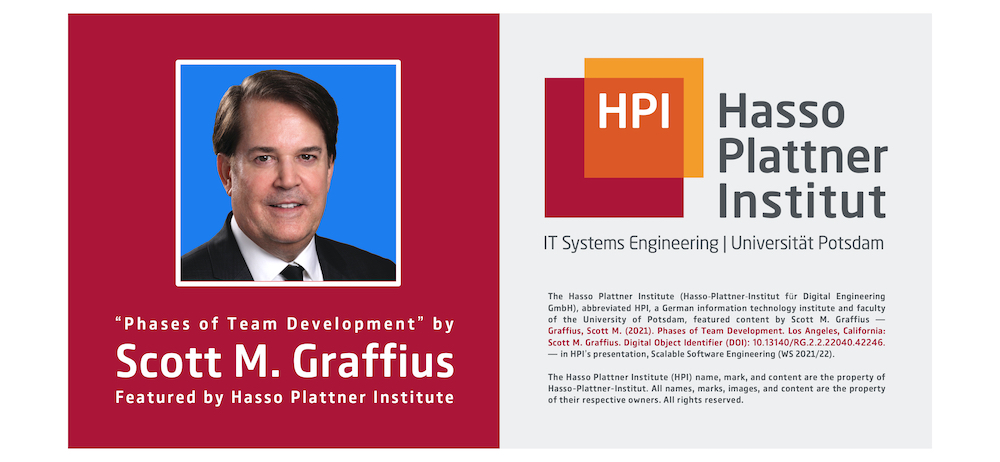
Click here to download this article as a PDF.
The Hasso Plattner Institute (Hasso-Plattner-Institut für Digital Engineering GmbH), abbreviated HPI, a German information technology institute and faculty of the University of Potsdam, featured content by Scott M. Graffius — Graffius, Scott M. (2021). Phases of Team Development. Los Angeles, California: Scott M. Graffius. Digital Object Identifier (DOI): 10.13140/RG.2.2.22040.42246. — in HPI’s presentation, Scalable Software Engineering (WS 2021/22).
The now-current 2022 version of the Phases of Team Development visual is here.

About Scott M. Graffius

Scott M. Graffius, PMP, CSP-SM, CSP-PO, CSM, CSPO, SFE, ITIL, LSSGB is an agile project management practitioner, consultant, multi award-winning author, and international keynote speaker. He has generated over $1.75 billion of business value in aggregate for the organizations he has served. Graffius is the CEO and Principal Consultant at Exceptional PPM and PMO Solutions™ and subsidiary Exceptional Agility™. Content from his books (Agile Scrum: Your Quick Start Guide with Step-by-Step Instructions and Agile Transformation: A Brief Story of How an Entertainment Company Developed New Capabilities and Unlocked Business Agility to Thrive in an Era of Rapid Change), workshops, speaking engagements, and more have been featured and used by businesses, professional associations, governments, and universities. Examples include Microsoft, Oracle, Broadcom, Cisco, Gartner, Deloitte, EY, Project Management Institute, IEEE, SANS Institute, U.S. Soccer Federation, English Institute of Sport, Ford, Qantas, Atlassian, Wrike, National Academy of Sciences, United States Department of Energy, United States Army, United States National Park Service, New Zealand Ministry of Education, Amsterdam Public Health Research Institute, Tufts University, Texas A&M University, Warsaw University of Technology, Zurich University of Applied Sciences, and others. Graffius has delighted audiences with talks and workshops on technology leadership and agile project, program, portfolio, and PMO management at 82 conferences and other events across 24 countries.
His full bio is available here.
Connect with Scott on:


About Agile Scrum: Your Quick Start Guide with Step-by-Step Instructions

Shifting customer needs are common in today's marketplace. Businesses must be adaptive and responsive to change while delivering an exceptional customer experience to be competitive.
There are a variety of frameworks supporting the development of products and services, and most approaches fall into one of two broad categories: traditional or agile. Traditional practices such as waterfall engage sequential development, while agile involves iterative and incremental deliverables. Organizations are increasingly embracing agile to manage projects, and best meet their business needs of rapid response to change, fast delivery speed, and more.
With clear and easy to follow step-by-step instructions, Scott M. Graffius's award-winning Agile Scrum: Your Quick Start Guide with Step-by-Step Instructions helps the reader:
- Implement and use the most popular agile framework―Scrum;
- Deliver products in short cycles with rapid adaptation to change, fast time-to-market, and continuous improvement; and
- Support innovation and drive competitive advantage.
Hailed by Literary Titan as “the book highlights the versatility of Scrum beautifully.”
Winner of 17 first place awards.
Agile Scrum: Your Quick Start Guide with Step-by-Step Instructions is available in paperback and ebook/Kindle in the United States and around the world. Some links by country follow.
- 🇧🇷 Brazil
- 🇨🇦 Canada
- 🇨🇿 Czech Republic
- 🇩🇰 Denmark
- 🇫🇮 Finland
- 🇫🇷 France
- 🇩🇪 Germany
- 🇬🇷 Greece
- 🇭🇺 Hungary
- 🇮🇳 India
- 🇮🇪 Ireland
- 🇮🇱 Israel
- 🇮🇹 Italy
- 🇯🇵 Japan
- 🇱🇺 Luxembourg
- 🇲🇽 Mexico
- 🇳🇱 Netherlands
- 🇳🇿 New Zealand
- 🇳🇴 Norway
- 🇪🇸 Spain
- 🇸🇪 Sweden
- 🇨🇭 Switzerland
- 🇦🇪 UAE
- 🇬🇧 United Kingdom
- 🇺🇸 United States

About Agile Transformation: A Brief Story of How an Entertainment Company Developed New Capabilities and Unlocked Business Agility to Thrive in an Era of Rapid Change

Thriving in today's marketplace frequently depends on making a transformation to become more agile. Those successful in the transition enjoy faster delivery speed and ROI, higher satisfaction, continuous improvement, and additional benefits.
Based on actual events, Agile Transformation: A Brief Story of How an Entertainment Company Developed New Capabilities and Unlocked Business Agility to Thrive in an Era of Rapid Change provides a quick (60-90 minute) read about a successful agile transformation at a multinational entertainment and media company, told from the author's perspective as an agile coach.
The award-winning book by Scott M. Graffius is available in paperback and ebook/Kindle in the United States and around the world. Some links by country follow.
- 🇦🇺 Australia
- 🇦🇹 Austria
- 🇧🇷 Brazil
- 🇨🇦 Canada
- 🇨🇿 Czech Republic
- 🇩🇰 Denmark
- 🇫🇮 Finland
- 🇫🇷 France
- 🇩🇪 Germany
- 🇬🇷 Greece
- 🇮🇳 India
- 🇮🇪 Ireland
- 🇯🇵 Japan
- 🇱🇺 Luxembourg
- 🇲🇽 Mexico
- 🇳🇱 Netherlands
- 🇳🇿 New Zealand
- 🇪🇸 Spain
- 🇸🇪 Sweden
- 🇨🇭 Switzerland
- 🇦🇪 United Arab Emirates
- 🇬🇧 United Kingdom
- 🇺🇸 United States

The short URL for this article is: https://bit.ly/hpi-2022
© Copyright 2022 Scott M. Graffius. All rights reserved. This material may not be published, broadcast, rewritten or redistributed without the express written permission of Scott M. Graffius.

Use the Phases of Team Development (Based on Bruce W. Tuckman's Model of Forming, Storming, Norming, Performing, and Adjourning) to Help Teams Grow and Advance: 2023 Update
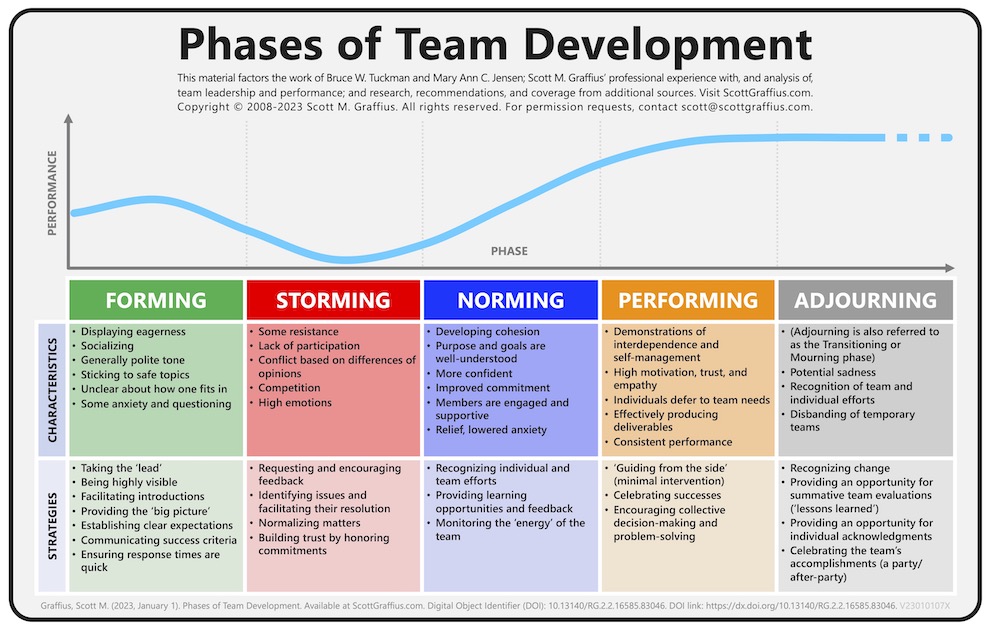
High Resolution Files of Visual: See Permission Request Information section

If there are any supplements or updates to this article after the date of publication, they will appear in the Post-Publication Notes section at the end of this article.

2023 Update
In 2008, Scott M. Graffius started developing material on advancing teams’ happiness, productivity, and success. His respective Phases of Team Development content factors the work of Dr. Bruce W. Tuckman and Mary Ann C. Jensen; Graffius's experience, observation, and analysis; and research, recommendations, and coverage from additional sources (examples are listed below).
The Phases of Team Development highlights the performance level, characteristics, and proven strategies for each of the five phases: Forming, Storming, Norming, Performing, and Adjourning. Project Managers, Scrum Masters, Agile Coaches, DevOps Leads, and other leaders can apply the information to help handle challenges or issues experienced by teams. By doing so, they’ll advance the teams' (and their own) happiness, productivity, and success.
This article and the accompanying visual provides the updated 2023 version of the Phases of Team Development.

Five Phases of Team Development
1. Forming
Characteristics of Forming include displaying eagerness, socializing, generally polite tone, sticking to safe topics, unclear about how one fits in, and some anxiety and questioning.
Strategies for this phase include taking the ‘lead,’ being highly visible, facilitating introductions, providing the ‘big picture,’ establishing clear expectations, communicating success criteria, and ensuring response times are quick.
2. Storming
Traits of Storming include some resistance, lack of participation, conflict based on differences of opinions, competition, and high emotions.
Strategies for this phase include requesting and encouraging feedback, identifying issues and facilitating their resolution, normalizing matters, and building trust by honoring commitments.
3. Norming
Features of Norming include purpose and goals are well-understood, more confident, improved commitment, members are engaged and supportive, relief (lowered anxiety), and developing cohesion.
Strategies for this phase include recognizing individual and team efforts, providing learning opportunities and feedback, and monitoring the ‘energy’ of the team.
4. Performing
Characteristics of Performing include high motivation, trust, and empathy; individuals defer to team needs; effectively producing deliverables; consistent performance; and demonstrations of interdependence and self-management.
Strategies for this phase include ‘guiding from the side’ (minimal intervention), celebrating successes, and encouraging collective decision-making and problem-solving.
5. Adjourning
Typical traits of Adjourning (also referred to as Transitioning or Mourning) include potential sadness, recognition of team and individual efforts, and disbanding.
Strategies for this phase include recognizing change, providing an opportunity for summative team evaluations ('lessons learned'), providing an opportunity for individual acknowledgments, and celebrating the team’s accomplishments — which may involve a party and possibly an after-party.


References / Sources
The Phases of Team Development by Scott M. Graffius factors the work of Dr. Bruce W. Tuckman and Mary Ann C. Jensen; Graffius's experience, observation, and analysis; and research, recommendations, and coverage from additional sources such as Google, Harvard Business Review, IEEE, MIT, Fast Company, NASA, Microsoft, TNW, Project Management Institute, Scrum Alliance, Scrum.org, Gartner, CIO, RAND Corporation, Software Engineering Institute, University of Edinburgh, Cisco, KPMG, Warsaw University of Technology, Software Engineering Institute, DevOps Institute, American Express, SANS Institute, Zurich University, SAP, ViacomCBS, Oxford University, American Management Association, AT&T, University of Southern California, IBM, and many others.
Select (partial) bibliography:
- Alford, J. (2019, April 11). Our Co-Production Journey: From Sandpits to Bird Boxes. London, United Kingdom: Imperial College London.
- Bennett, M., Gadlin, H., & Marchand, C. (2018). Collaboration Team Science: Field Guide. Rockville, MD: National Institutes of Health.
- Couture, N. (2016, October 27). A Note About Teams. CIO. Boston, MA: International Data Group (IDG).
- Daly, L. (2002). Identify Your Project Management Team’s Level of Development and Facilitate It to Success. Paper presented at Project Management Institute Annual Seminars and Symposium, San Antonio, TX. Newtown Square, PA: Project Management Institute.
- Deloitte (2017). Digital Era Technology Operating Models, Volume 2. New York, NY: Deloitte Touche Tohmatsu Limited.
- Finkelstein, S. (2017, October 29). Why Companies Should Hire Teams, Not Individuals. The Wall Street Journal. New York, NY: The Wall Street Journal.
- Forbes (2018, April 23). How to Fast-Track Any Team to Success. Forbes. New York, NY: Forbes.
- Forbes (2012, October 27). How the iPad Mini is Defining Tim Cook’s Apple. Forbes. New York, NY: Forbes.
- Glover, P. (2012, March 13). Team Conflict: Why It’s a Good Thing. Fast Company. New York, NY: Mansueto Ventures.
- Graffius, Scott M. (2021). Phases of Team Development. Los Angeles, CA: Scott M. Graffius. Digital Object Identifier (DOI): 10.13140/RG.2.2.22040.42246.
- Jovanovic, M., Mesquida, A., Radaković, N., & Mas, A. (2016). Agile Retrospective Games for Different Team Development Phases. Journal of Universal Computer Science, 22: 1489-1508.
- Kane, G. C. (2014, October 7). Why Your Company is Probably Measuring Social Media Wrong. MIT Sloan Management Review. Cambridge, MA: MIT Sloan Management Review.
- KPMG (2017). The Digital Fund, Season 2. Amstelveen, Netherlands: KPMG International.
- Madden, D. (2019, May 19). The Four Stages of Building a Great Team – and the One Where Things Usually Go Wrong. Inc. Magazine. New York, NY: Inc. Magazine.
- Makar, A. (2011, July 13). Lessons Learned in Norming and Performing Team Development Phases. Louisville, KY: TechRepublic.
- Martinuzzi, B. (2012, June 8). Six Tips Guaranteed to Reduce Workplace Frustrations. New York, NY: American Express Company.
- Microsoft (2019, June 15). Is the Latest Technology the Key to Your Team’s Success, or is There Something Else? Microsoft Developer Support. Accessed at: https://devblogs.microsoft.com/premier-developer/is-the-latest-technology-the-key-to-your-teams-success-or-is-there-something-else. Redmond, WA: Microsoft.
- Mocko, G., & Linnerud, B. (2016). Measuring the Effects of Goal Alignment on Innovative Engineering Design Projects. International Journal of Engineering Education, 32: 55-63.
- Romanelli, M. (2019, September 11). Teamwork Accelerated. PM Times. Newmarket, Ontario, Canada: Macgregor Communications.
- Riggs, A. (2020, October 15). Why I Start All My Video Meetings with Collaborative Games (Spoiler: It’s Not Boredom). Amsterdam, the Netherlands: The Next Web (TNW).
- Rowley, D., & Lange, M. (2007). Forming to Performing: The Evolution of an Agile Team. IEEE Computer Society Proceedings. Agile 2007, 1: 408-414.
- Scrum Alliance (2020). Learning Objectives Examples. Denver, CO: Scrum Alliance.
- Sakpal, M. (2020, March 3. Learn How to Debunk These Five Restructuring Myths. Stamford, CT: Gartner, Inc.
- Stern, S. (2018, September 26). Is Your Team Working the Rory Underwood Way? Financial Times. London, United Kingdom: The Financial Times, a Nikkei Company.
- Telford, R. (2013, June 4). This is Where It Gets Interesting. Armonk, NY: International Business Machines (IBM) Corporation.
- Tuckman, B. W. (1965). Developmental Sequence in Small Groups. Psychological Bulletin, 63: 384-399.
- Tuckman, B. W., & Jensen, M. A. C. (1977). Stages of Small-Group Development Revisited. Group and Organizational Studies, 2 (4): 419-427.
- United States Army (2015). Innovative Learning: A Key to National Security. Washington, DC: United States Army.


How to Cite This Article
Graffius, Scott M. (2023, January 9). Use the Phases of Team Development (Based on Bruce W. Tuckman's Model of Forming, Storming, Norming, Performing, and Adjourning) to Help Teams Grow and Advance: 2023 Update. Available at: https://scottgraffius.com. Digital Object Identifier (DOI): 10.13140/RG.2.2.10720.35846. DOI link: https://dx.doi.org/10.13140/RG.2.2.10720.35846.


Request Permission
This material is © copyright 2023 Scott M. Graffius. All rights reserved. It may not be published, broadcast, rewritten or redistributed without the express written permission of Scott M. Graffius.
To request permission to use the Phases of Team Development content, contact Scott M. Graffius.
If a request is approved, terms and conditions will be provided along with—if applicable—downloadable high resolution versions of the Phases of Team Development image in JPG and PNG formats.



About Scott M. Graffius

Scott M. Graffius, PMP, CSP-SM, CSP-PO, CSM, CSPO, SFE, ITIL, LSSGB is an agile project management practitioner, consultant, multi award-winning author, and highly sought-after international keynote speaker. He has generated over $1.75 billion of business value in aggregate for the organizations he has served. Graffius is the CEO and Principal Consultant at Exceptional PPM and PMO Solutions™ and subsidiary Exceptional Agility™. Content from his books, talks, workshops, and more have been featured and used by businesses, professional associations, governments, and universities. Select examples include Microsoft, Oracle, Broadcom, Cisco, Gartner, Project Management Institute, IEEE, U.S. Soccer Federation, Qantas, National Academy of Sciences, U.S. Department of Energy, U.S. National Park Service, New Zealand Ministry of Education, Yale University, Warsaw University of Technology, and others. Graffius has delighted audiences with dynamic and engaging talks and workshops on agile, project management, and technology leadership at 82 conferences and other events across 24 countries.
His full bio is available here.
Connect with Scott on:
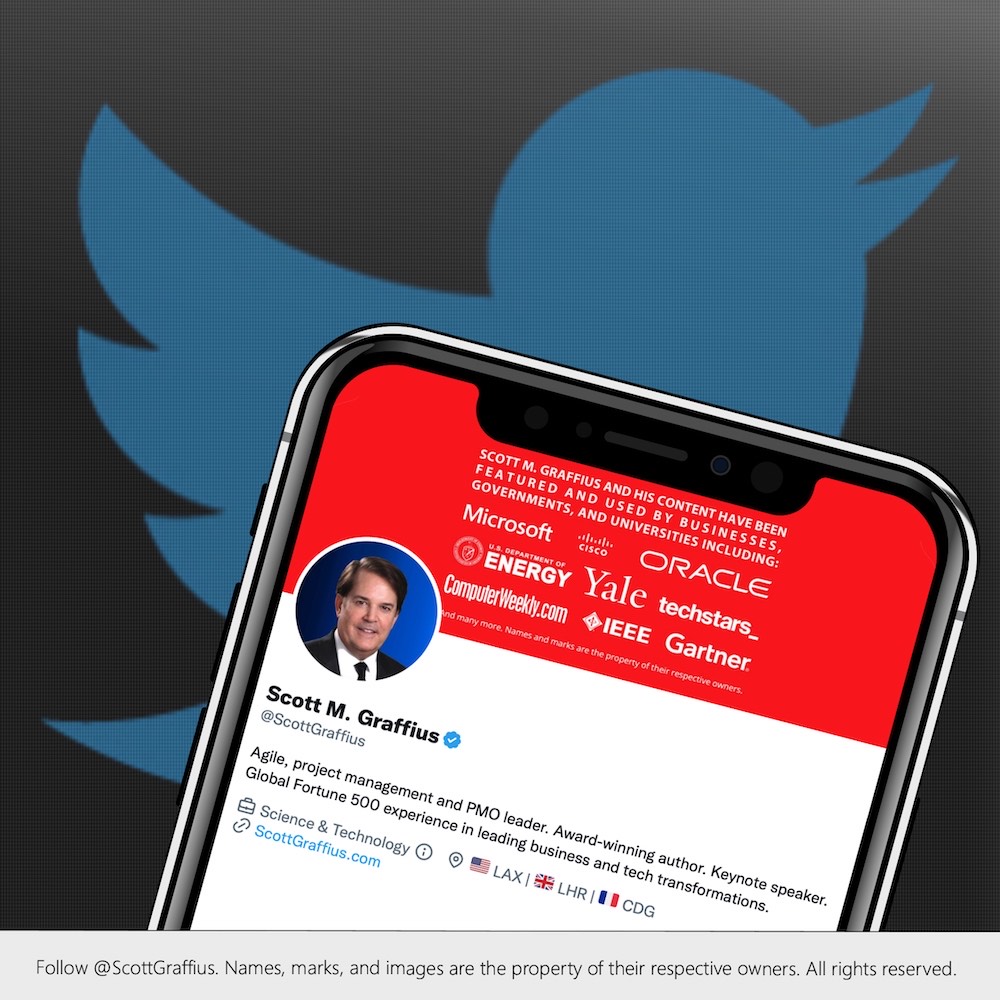

About Agile Scrum: Your Quick Start Guide with Step-by-Step Instructions

Shifting customer needs are common in today's marketplace. Businesses must be adaptive and responsive to change while delivering an exceptional customer experience to be competitive.
There are a variety of frameworks supporting the development of products and services, and most approaches fall into one of two broad categories: traditional or agile. Traditional practices such as waterfall engage sequential development, while agile involves iterative and incremental deliverables. Organizations are increasingly embracing agile to manage projects, and best meet their business needs of rapid response to change, fast delivery speed, and more.
With clear and easy to follow step-by-step instructions, Scott M. Graffius's award-winning Agile Scrum: Your Quick Start Guide with Step-by-Step Instructions helps the reader:
- Implement and use the most popular agile framework―Scrum;
- Deliver products in short cycles with rapid adaptation to change, fast time-to-market, and continuous improvement; and
- Support innovation and drive competitive advantage.
Hailed by Literary Titan as “the book highlights the versatility of Scrum beautifully.”
Winner of 17 first place awards.
Agile Scrum: Your Quick Start Guide with Step-by-Step Instructions is available in paperback and ebook/Kindle in the United States and around the world. Some links by country follow.
- 🇧🇷 Brazil
- 🇨🇦 Canada
- 🇨🇿 Czech Republic
- 🇩🇰 Denmark
- 🇫🇮 Finland
- 🇫🇷 France
- 🇩🇪 Germany
- 🇬🇷 Greece
- 🇭🇺 Hungary
- 🇮🇳 India
- 🇮🇪 Ireland
- 🇮🇱 Israel
- 🇮🇹 Italy
- 🇯🇵 Japan
- 🇱🇺 Luxembourg
- 🇲🇽 Mexico
- 🇳🇱 Netherlands
- 🇳🇿 New Zealand
- 🇳🇴 Norway
- 🇪🇸 Spain
- 🇸🇪 Sweden
- 🇨🇭 Switzerland
- 🇦🇪 UAE
- 🇬🇧 United Kingdom
- 🇺🇸 United States

About Agile Transformation: A Brief Story of How an Entertainment Company Developed New Capabilities and Unlocked Business Agility to Thrive in an Era of Rapid Change

Thriving in today's marketplace frequently depends on making a transformation to become more agile. Those successful in the transition enjoy faster delivery speed and ROI, higher satisfaction, continuous improvement, and additional benefits.
Based on actual events, Agile Transformation: A Brief Story of How an Entertainment Company Developed New Capabilities and Unlocked Business Agility to Thrive in an Era of Rapid Change provides a quick (60-90 minute) read about a successful agile transformation at a multinational entertainment and media company, told from the author's perspective as an agile coach.
The award-winning book by Scott M. Graffius is available in paperback and ebook/Kindle in the United States and around the world. Some links by country follow.
- 🇦🇺 Australia
- 🇦🇹 Austria
- 🇧🇷 Brazil
- 🇨🇦 Canada
- 🇨🇿 Czech Republic
- 🇩🇰 Denmark
- 🇫🇮 Finland
- 🇫🇷 France
- 🇩🇪 Germany
- 🇬🇷 Greece
- 🇮🇳 India
- 🇮🇪 Ireland
- 🇯🇵 Japan
- 🇱🇺 Luxembourg
- 🇲🇽 Mexico
- 🇳🇱 Netherlands
- 🇳🇿 New Zealand
- 🇪🇸 Spain
- 🇸🇪 Sweden
- 🇨🇭 Switzerland
- 🇦🇪 United Arab Emirates
- 🇬🇧 United Kingdom
- 🇺🇸 United States


Post-Publication Notes
Update on 7 January 2025
Scott M. Graffius periodically updates his 'Phases of Team Development' work. The most current edition is here.

© Copyright 2023 Scott M. Graffius. All rights reserved. This material may not be published, broadcast, rewritten or redistributed without the express written permission of Scott M. Graffius.

AI is a Team Sport: A Confluence of Diverse Technical and Soft Skills are Crucial for Success

Select here to download this article as a PDF.
This article covers the significance of well-rounded AI teams, including how both soft and technical skills are critical and fuel success. It’s informed by Graffius' work on AI projects as well as research and coverage from DARPA, Exceptional Agility, IBM, IEEE, Intel, MIT, Microsoft, Nvidia, Samsung, Software Engineering Institute, Stanford University, United States Artificial Intelligence Institute, and others (all listed in the bibliography section of this article).

Introduction
Artificial Intelligence (AI) has emerged as a transformative force across a growing number of industries, revolutionizing how we live, work, and interact. From autonomous vehicles and virtual assistants to personalized recommendations and medical diagnoses, AI systems have become integral to our daily lives. Behind these cutting-edge, life-changing solutions are AI teams that possess a combination of soft skills—also known as core skills, interpersonal skills, people skills, power skills, transferable skills, or transversal skills—and technical expertise.
This article highlights the synergy between soft skills and technical skills in the world of AI. While technical skills provide the general foundation for AI development, it’s the soft skills that elevate AI projects to new heights. From effective communication and critical thinking to leadership and teamwork, soft skills play a pivotal role in translating technical knowledge and capabilities into real-world applications.
The thesis of this article is that the successful development and application of AI requires a combination of soft skills and technical expertise. Technical competencies alone are not enough. Rather, it’s the combination and integration of soft and technical skills that truly unlocks the power of AI.
Next, this article focuses on the importance of soft skills in the AI landscape, highlighting how they complement and enhance technical abilities. The collaboration between these skill sets drives AI innovation.

Understanding Soft Skills in AI Teams
In the realm of AI, technical expertise often takes center stage. However, soft skills advance the successful outcomes of AI projects, as they facilitate effective communication, foster collaboration, and promote critical thinking. Soft skills are powerful facilitators of success.
Soft skills encompass a range of interpersonal and cognitive abilities that enable teams to work harmoniously, adapt to evolving challenges, and solve complex problems. In the AI landscape, where multidisciplinary teams come together to create innovative solutions, these soft skills are essential.
Effective communication stands at the forefront of soft skills in AI. AI teams must articulate complex technical concepts in a manner that is understandable to diverse stakeholders, including non-technical staff and internal or external customers/users. Clear communication promotes collaboration and ensures alignment of purpose and objectives throughout the AI development lifecycle.
Soft skills such as problem-solving and critical thinking are vital as well. AI teams frequently encounter multifaceted challenges, and it is through these soft skills that teams can identify potential bottlenecks, navigate complexities, and devise innovative solutions. By leveraging critical thinking, AI team members can evaluate different approaches, consider ethical implications, and make informed decisions that shape the development and application of AI systems.
Leadership and teamwork skills are also paramount. AI projects involve team members from diverse backgrounds, including data scientists, engineers, domain experts, designers, and others. Effective leadership enables the coordination of efforts and guides the project towards success. Similarly, teamwork skills foster an environment of trust and respect, promoting synergy among team members and enhancing overall productivity.
Recognizing the importance of soft skills in AI is crucial for fostering a balanced and effective team dynamic. It ensures that AI teams possess the interpersonal and cognitive abilities necessary to bring AI projects to fruition. The integration of soft skills alongside technical expertise sets the stage for a cohesive team capable of tackling complex AI challenges with agility and innovation.
The role of technical skills—including how they intersect with soft skills to create a powerful combination that drives success—are covered next.
The Role of Technical Skills in AI Teams
Technical skills provide the tools and knowledge required to design, build, and implement AI systems. This section explores the role that technical skills play in AI and their specific applications in various stages of AI projects.
- Programming Languages and Algorithms: Proficiency in programming languages such as Python, Java, or R is essential. These languages enable team members to write efficient code, manipulate and analyze data, and implement machine learning algorithms. Understanding algorithms, from classic ones like linear regression to cutting-edge deep learning models, empowers AI professionals to leverage mathematical principles and statistical techniques to train and optimize AI systems.
- Data Analysis and Management: AI relies on data, making data analysis and management skills crucial. AI team members need to be adept at collecting, cleaning, and preprocessing data, ensuring its quality and relevance. They must possess the knowledge of statistical methods, data visualization techniques, and data engineering practices to extract insights from complex datasets and prepare them for AI model training.
- Machine Learning and Neural Networks: Technical skills in machine learning are at the heart of AI systems. Understanding machine learning algorithms, such as decision trees, support vector machines, or convolutional neural networks, enables AI team members to create models that can learn from data and make intelligent predictions or decisions. Expertise in neural networks and deep learning architectures equips professionals with the ability to develop complex models capable of handling tasks like image recognition, natural language processing, and reinforcement learning.
- AI Frameworks and Tools: Proficiency in AI frameworks and tools (such as TensorFlow, Keras, PyTorch, Caffe, Scikit-learn, and others) are essential for building AI systems efficiently. These frameworks provide pre-built modules, libraries, and APIs that simplify the implementation of AI algorithms and models. Technical skills in utilizing these tools effectively enable AI team members to accelerate the development process, streamline model training, and optimize system performance.
- Domain Knowledge and Application-Specific Skills: Technical skills also encompass domain knowledge and application-specific expertise. Understanding the nuances of the industry or problem domain in which AI is being applied allows professionals to tailor AI solutions to meet specific requirements. For example, healthcare-focused AI projects may require knowledge of medical terminologies and regulatory considerations, while AI solutions for financial services may demand expertise in risk assessment and fraud detection.
Technical skills are essential for AI projects. They enable team members to translate concepts, theories, and algorithms into practical applications. However, technical skills alone are not sufficient for success. The collaborative nature of AI development and the need for a well-rounded AI team—including the synergy between technical skills and soft skills—is covered next.
The Power of Synergy: Soft Skills and Technical Skills in AI Teams
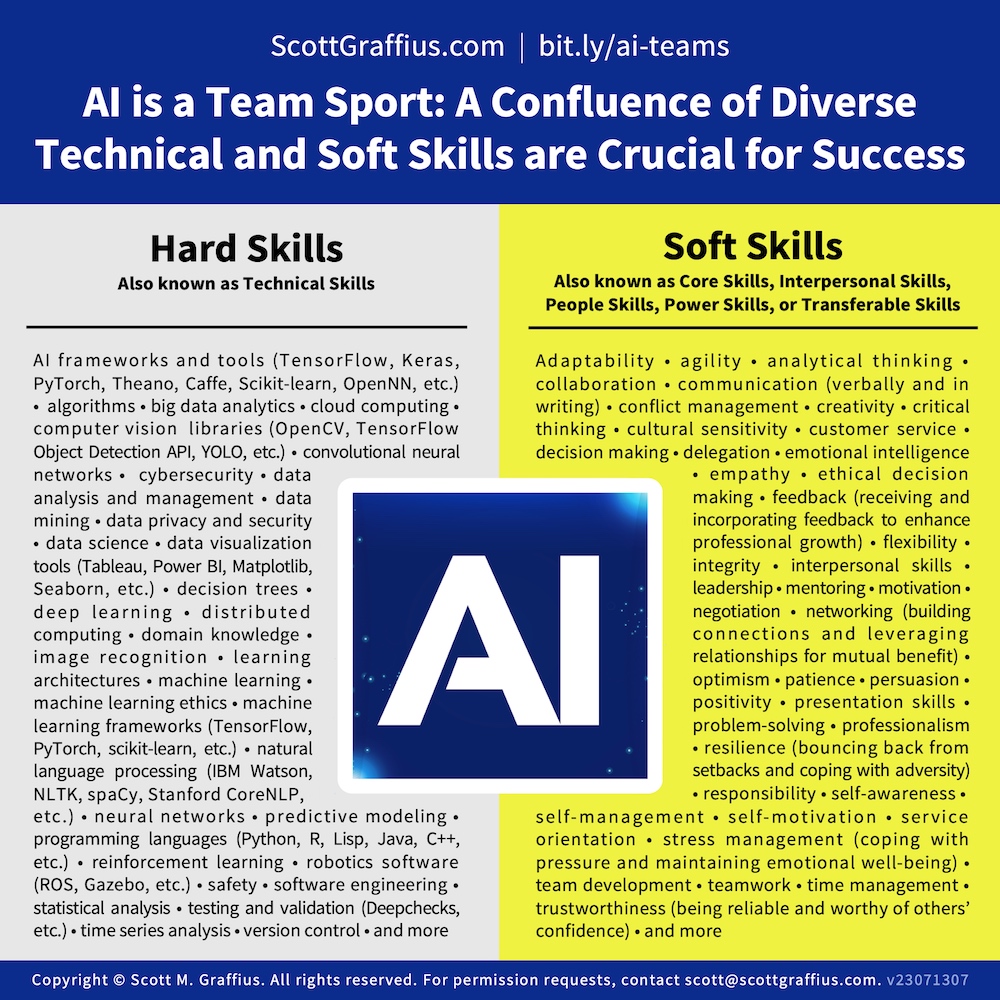
The convergence of technical and soft skills is where true innovation and breakthroughs occur. The successful development and application of AI systems rely not only on technical expertise but also on the harmonious integration of soft skills. Here’s some examples of the power of synergy between these skill sets, including how they work together to drive AI advancement:
- Effective Communication and Technical Expertise: Communication bridges the gap between AI professionals and others who may not possess technical backgrounds. AI experts with strong communication skills can articulate complex technical concepts in plain English, ensuring that everyone involved understands the goals, challenges, and progress of the project. By effectively conveying ideas, AI professionals foster collaboration, gather valuable insights, and create a shared vision for AI initiatives.
- Collaboration and Problem-Solving: Collaboration is at the core of AI development, and soft skills such as teamwork, empathy, and active listening facilitate effective collaboration among diverse team members. AI teams with strong collaboration skills can effectively pool their technical expertise, brainstorm ideas, and solve complex problems together. By leveraging their collective intelligence and diverse perspectives, AI teams can overcome challenges, refine AI models, and optimize the performance of AI solutions.
- Critical Thinking and Technical Innovation: Critical thinking, coupled with technical expertise, leads to innovative AI solutions. AI professionals with strong critical thinking skills can evaluate different approaches, challenge assumptions, and identify potential shortcomings or biases in AI models. They can think creatively to address issues such as data biases or fairness concerns, ensuring that AI systems are developed responsibly and ethically.
- Leadership and Team Empowerment: Effective leadership in AI projects involves establishing and maintaining a collaborative and inclusive environment, empowering team members, and harnessing their full potential. AI leaders with exceptional interpersonal abilities can inspire and motivate their team, foster a culture of continuous learning, and provide guidance in navigating complex technical challenges. They encourage interdisciplinary collaboration, respect diverse perspectives, and drive the team towards achieving AI objectives.
The synergy between soft skills and technical skills is the catalyst that drives AI projects towards success. It enables AI teams to go beyond technical expertise and develop AI systems that address real-world problems effectively. By embracing a holistic approach that values both soft skills and technical skills, organizations can foster an environment where AI thrives, resulting in innovative solutions that have a positive impact on society.
Strategies for developing and nurturing soft skills are covered next.
Developing and Advancing Soft Skills in AI Teams
AI teams need soft skills to be successful. Organizations and teams should prioritize the development and advancement of these skills. Here are some strategies to enhance soft skills and foster a well-rounded AI workforce:
- Training Programs and Workshops: Implement specialized training programs and workshops focused on enhancing soft skills. Offer courses in effective communication, leadership (including how to navigate the phases of team development), problem-solving, critical thinking, and collaboration. These programs can provide AI professionals with the necessary tools and techniques to effectively apply soft skills in their work.
- Interdisciplinary Collaboration and Knowledge Sharing: Encourage interdisciplinary collaboration by creating opportunities for AI team members to work alongside experts from diverse fields such as psychology, design, ethics, and business. This collaboration allows for cross-pollination of ideas, encourages different perspectives, and broadens the skill set of AI teams. Foster a culture of knowledge sharing, where professionals can learn from each other and leverage their collective experiences and expertise.
- Real-World Project Engagement: Provide AI team members with opportunities to work on (other) real-world projects, allowing them to apply their soft skills in practical scenarios. Engaging in projects that involve interaction with clients, end-users, and stakeholders helps AI team members develop effective communication, problem-solving, and teamwork skills.
- Continuous Learning and Professional Development: Encourage AI team members to engage in continuous learning and professional development activities. This can include attending conferences, participating in webinars, reading industry publications, and pursuing certifications in relevant areas. Promote a growth mindset among AI team members, emphasizing the importance of lifelong learning and staying current with the latest developments in both technical and soft skills domains.
- Mentorship and Coaching: Establish mentorship and coaching programs where experienced AI professionals guide and support individuals with less experience. Mentors can provide valuable insights, share their experiences, and offer guidance on developing skills. Regular feedback and coaching sessions help AI professionals identify areas for improvement and provide targeted development opportunities.
By implementing these strategies, organizations can cultivate a workforce that excels not only in technical skills but also in the essential soft skills required for AI success. Nurturing well-rounded AI professionals creates a collaborative and adaptive environment, where AI teams can effectively address complex challenges, drive innovation, and deliver impactful solutions.
The next section wraps up this exploration.
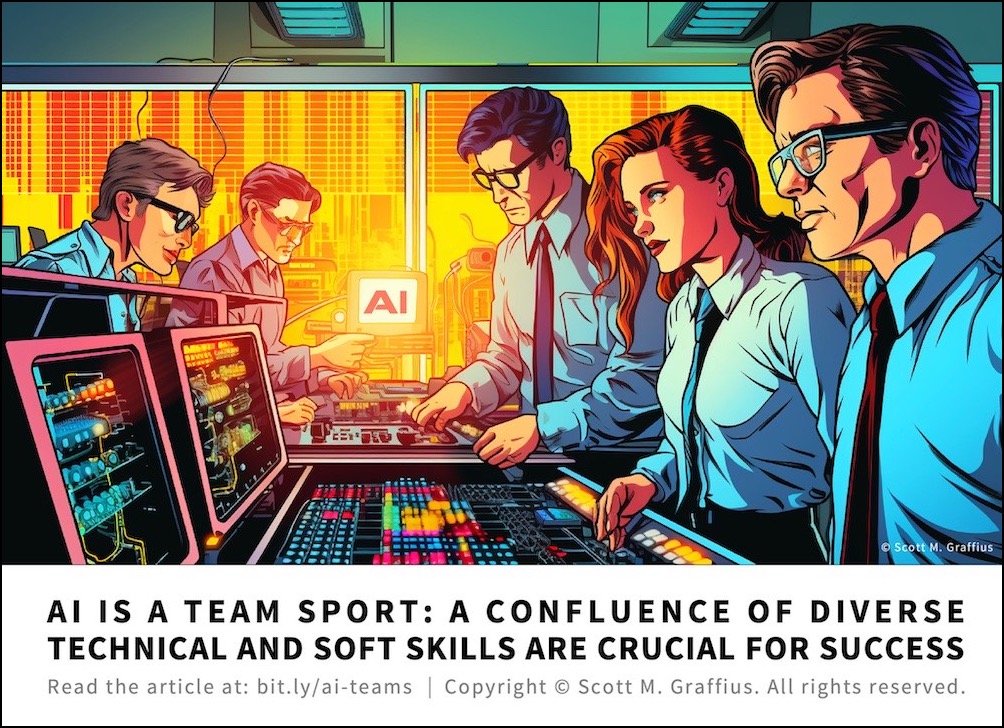

Conclusion
The successful development and application of AI systems rely on the synergy between soft skills and technical skills. While technical expertise forms the foundation, it's the integration of soft skills that elevates AI projects to new heights. Effective communication, collaboration, critical thinking, and leadership are among the key soft skills that enable AI teams to excel.
This article explored the significance of soft skills in AI, emphasizing their role in fostering effective teamwork, problem-solving, and innovation. It also acknowledged the indispensable role of technical skills in AI development, including programming languages, algorithms, data analysis, domain knowledge, and more.
Organizations can create well-rounded AI teams with a holistic set of abilities by embracing the power of synergy between soft skills and technical skills. AI team members with strong soft skills can effectively communicate their ideas, collaborate seamlessly, think critically, and provide leadership that empowers their teams.
To advance soft skills among AI professionals, organizations should invest in training programs, promote interdisciplinary collaboration, encourage continuous learning, and foster mentorship and coaching relationships. These efforts will help AI professionals develop the interpersonal and cognitive abilities necessary to thrive in the dynamic and collaborative AI landscape.
AI is a team sport that thrives on the confluence of soft skills and technical skills. By recognizing and embracing this synergy, organizations can unlock the full potential of AI, delivering innovative solutions that address real-world challenges and have a positive impact on the world.

References/Sources
All of the supplied links were functional when this article was published.
- Accenture (2023, March 30). Accenture Technology Vision 2023: Generative AI to Usher in a Bold New Future for Business, Merging Physical and Digital Worlds. Available at: https://newsroom.accenture.com/news/accenture-technology-vision-2023-generative-ai-to-usher-in-a-bold-new-future-for-business-merging-physical-and-digital-worlds.htm.
- Alsever, Jennifer (2020, January 20). Medicine by Machine: Is A.I. the Cure for the World’s Ailing Drug Industry? Fortune. Available at: https://fortune.com/longform/ai-artificial-intelligence-medicine-healthcare-pharmaceutical-industry.
- Anthropic (2023, March 14). Introducing Claude. Available at: https://www.anthropic.com/news/introducing-claude.
- Berlin School of Business and Innovation (2022, September 22). How Do Technical Abilities Combined with Leadership Skills Fuel Career Growth? Available at: https://www.berlinsbi.com/blog/career-advice/how-do-technical-abilities-combined-with-leadership-skills-fuel-career-growth.
- Bhatti, Shawaiz, Demir, Mustafa, Cooke, Nancy J., & Johnson, Craig J. (2021). Assessing Communication and Trust in an AI Teammate in a Dynamic Task Environment. In: 2021 IEEE 2nd International Conference on Human-Machine Systems (ICHMS): 1–6. DOI: 10.1109/ICHMS53169.2021.9582626.
- Brooks, David (2023, February 2). In the Age of A.I., Major in Being Human. The New York Times. Available at: https://www.nytimes.com/2023/02/02/opinion/ai-human-education.html.
- C3.ai (n.d.). Best Practices in Prototyping: Cross-Functional Teams. Available at: https://c3.ai/introduction-what-is-machine-learning/cross-functional-teams/.
- Crampton, Natasha (2021, January 19). The Building Blocks of Microsoft’s Responsible AI Program. Microsoft. Available at: https://blogs.microsoft.com/on-the-issues/2021/01/19/microsoft-responsible-ai-program.
- Dolev, Niva, & Itzkovich, Yariv (2020). In the AI Era, Soft Skills are the New Hard Skills. In: Artificial Intelligence and Its Impact on Business, pp. 55-77. Charlotte, NC: Information Age Publishing.
- Dzombak, Rachel, & Palat, Jay (2021, August 30). 5 Ways to Start Growing an AI-Ready Workforce. Pittsburgh, PA: Software Engineering Institute, Carnegie Mellon University.
- Elliott, Joshua (n.d.). Artificial Social Intelligence for Successful Teams (ASIST). Arlington, VA: Defense Advanced Research Projects Agency (DARPA).
- Exceptional Agility (2023, April 10). What's the Future of Agile? Available at: https://exceptionalagility.com/blog/files/the-future.html.
- Fountaine, Tim, McCarthy, Brian, & Saleh, Tamim (2019). Building the AI-Powered Organization. Harvard Business Review, 97 (4): 62–73.
- Gartner (2020, December 15). How to Staff Your AI Team. Available at: https://www.gartner.com/smarterwithgartner/how-to-staff-your-ai-team.
- Gong, Michelle; and Zhernov, Anton (2019, November 18). Advanced Machine Learning Helps Play Store Users Discover Personalised Apps. Google DeepMind. Available at: https://deepmind.google/discover/blog/advanced-machine-learning-helps-play-store-users-discover-personalised-apps/.
- Gorman, Austin (2023, April 27). How to Strengthen Your Soft Skills for AI and the Future of Work. Fast Company. Available at: https://www.fastcompany.com/90887540/how-to-strengthen-your-soft-skills-for-ai-and-the-future-of-work.
- GovExec Events (2020, July 1). Human Machine Team: The Intersection of Diverse Skill Sets [Video]. Defense One. Available at: https://www.youtube.com/watch?v=93wbNLKpbxg&t=1s.
- Graffius, Scott M. (2023, May 1). Fueling the Development of Innovative and Life-Changing AI Solutions [Presentation]. Talk delivered to an audience of Technology professionals (including Data Scientists, Machine Learning Engineers, Data Engineers, AI Researchers, Project Managers, Business Analysts, UX Designers, Software Developers, Cloud Architects, Data Privacy and Security Specialists, and others involved or interested in AI) at a private event in Mountain View, California, United States. Digital Object Identifier (DOI): 10.13140/RG.2.2.27956.73601. DOI link: https://dx.doi.org/10.13140/RG.2.2.27956.73601.
- Graffius, Scott M. (2023, April 26). The Science of High-Performance Teams [Presentation]. Talk delivered at the DevOps Institute’s SKILup Day 2023 Conference. Digital Object Identifier (DOI): 10.13140/RG.2.2.15888.28169. DOI link: https://dx.doi.org/10.13140/RG.2.2.15888.28169.
- Graffius, Scott M. (2023, January 9). Use the Phases of Team Development (Based on Bruce W. Tuckman's Model of Forming, Storming, Norming, Performing, and Adjourning) to Help Teams Grow and Advance: 2023 Update. Available at: https://scottgraffius.com. Digital Object Identifier (DOI): 10.13140/RG.2.2.10720.35846. DOI link: https://dx.doi.org/10.13140/RG.2.2.10720.35846.
- Graffius, Scott M. (2022, May 13). Want Happier and More Productive DevOps Teams? [Presentation]. Talk delivered at DevOpsDays Geneva, Switzerland 2022 Conference. Digital Object Identifier (DOI): 10.13140/RG.2.2.22252.85127. DOI link: https://dx.doi.org/10.13140/RG.2.2.22252.85127.
- Graffius, Scott M. (2021, October 5). Navigate the Phases of Team Development with Speed and Agility for Happier and More Productive Teams [Presentation]. Talk delivered at the Institute of Electrical and Electronics Engineers IEEE Day 2021 Conference. Digital Object Identifier (DOI): 10.13140/RG.2.2.20055.19365. DOI link: https://dx.doi.org/10.13140/RG.2.2.20055.19365.
- Graffius, Scott M. (2021, February 20). But First, the Team! [Presentation]. Talk delivered at the Brno, Czech Republic DevConf.CZ 2021 Conference. Digital Object Identifier (DOI): 10.13140/RG.2.2.29016.72964. DOI link: https://dx.doi.org/10.13140/RG.2.2.29016.72964.
- Gupta, Arun (2022). Non-Technical Skills Eat Technical Skills for Breakfast [Video]. Recording of Arun Gupta, VP and GM of the Open Ecosystem at Intel, speaking at the All Things Open Conference. Available at: https://www.youtube.com/watch?v=WNPxRBhYNU4.
- Humpton, Barbara (n.d.). The Future of Jobs. Siemens. Available at: https://www.siemens.com/us/en/company/press/siemens-stories/ceo-perspective/the-future-of-jobs.html.
- IBM (2019, September 26). Assemble the Team to Support a Data-Driven Project. Available at: https://www.ibm.com/garage/method/practices/culture/assemble-team-for-data-driven-project.
- IBM (2019). Everyday Ethics for Artificial Intelligence. Available at: https://www.ibm.com/watson/assets/duo/pdf/everydayethics.pdf.
- Institute of Electrical and Electronics Engineers (IEEE) (2021, November 8). The IEEE Global Initiative on Ethics of Autonomous and Intelligent Systems. Available at: https://standards.ieee.org/industry-connections/ec/autonomous-systems.html.
- Kenan Institute (2023, February 20). The Must-Have Skills in the Era of Artificial Intelligence: How AI’s Democratization Will Impact Workers. Available at: https://kenaninstitute.unc.edu/commentary/the-must-have-skills-in-the-era-of-artificial-intelligence-how-ais-democratization-will-impact-workers.
- Lindzon, Jared (2017, February 28). How AI is Changing the Way Companies are Organized. Fast Company. Available at: https://www.fastcompany.com/3068492/how-ai-is-changing-the-way-companies-are-organized.
- Marr, Bernard (2023, March 20). Beyond The Hype: What You Really Need to Know About AI In 2023. Forbes. Available at: https://www.forbes.com/sites/bernardmarr/2023/03/20/beyond-the-hype-what-you-really-need-to-know-about-ai-in-2023.
- Massachusetts Institute of Technology (MIT) Lincoln Laboratory (2023, January 17). Human-AI Performance Incubator. Available at: https://www.ll.mit.edu/r-d/projects/human-ai-performance-incubator.
- Massachusetts Institute of Technology (MIT) (2021, January). Cognitive Science as a New People Science for the Future of Work. Available at: https://workofthefuture.mit.edu/wp-content/uploads/2021/01/2021-Research-Brief-Polli-Kassir-Dolphin-Baker-Gabrieli.pdf.
- Massachusetts Institute of Technology (MIT) Sloan (2019, October 15). Winning With AI. MIT Sloan Management Review and Boston Consulting Group. Available at: https://sloanreview.mit.edu/projects/winning-with-ai.
- McNeese, Nathan J., Demir, Mustafa, Chiou, Erin K., & Cooke, Nancy J. (2021). Trust and Team Performance in Human–Autonomy Teaming. International Journal of Electronic Commerce, 25 (1): 51–72. DOI: 10.1080/10864415.2021.1846854.
- Mearian, Lucas (2023, February 24). Skills-Based Hiring Continues to Rise as Degree Requirements Fade. Computerworld. Available at: https://www.computerworld.com/article/3689170/skills-based-hiring-continues-to-rise-as-degree-requirements-fade.html.
- Meta (2017, October 11). Inventing the Future. Available at: https://www.meta.com/blog/quest/inventing-the-future/.
- Microsoft (2019, June 15). Is the Latest Technology the Key to Your Team’s Success, or is There Something Else? Available at: https://devblogs.microsoft.com/premier-developer/is-the-latest-technology-the-key-to-your-teams-success-or-is-there-something-else.
- New South Wales Technical and Further Education Commission (TAFE NSW) (2019). Soft vs. Hard Skills: Why Successful Australian Businesses Need Both. Ultimo, New South Wales: TAFE NSW.
- Nvidia (n.d.). Partner Innovation. Available at: https://www.nvidia.com/en-ph/self-driving-cars/partners/.
- O’Dea, Blathnaid (2023, February 17). These are the Top Skills AI and Analytics Professionals Need. Silicon Republic. Available at: https://www.siliconrepublic.com/advice/top-skills-ai-data-analytics-professionals-need.
- Olmstead, Brett (2023, February 15). Driving AI Success by Engaging a Cross-Functional Team. Available at: https://www.datarobot.com/blog/driving-ai-success-by-engaging-a-cross-functional-team/.
- Organization for Economic Cooperation and Development (OECD) (n.d.). OECD Programme on AI in Work, Innovation, Productivity and Skills. Available at: https://oecd.ai/en/work-innovation-productivity-skills/key-themes/skills.
- Oswald, Andrew. J., Proto, Eugenio, & Sgroi, Daniel (2015). Happiness and Productivity. Journal of Labor Economics, 33 (4): 789-822.
- Project Management Institute (2020, March 10). Tomorrow's Teams Today: The Future of Teaming: Creative, Collaborative and Agile. Pulse of the Profession. Available at: https://www.pmi.org/learning/library/pulse-indepth-tomorrows-teams-today-11941.
- PwC (2017). Sizing the Prize: What’s the Real Value of AI for Your Business and How Can You Capitalise? PwC’s Global Artificial Intelligence Study: Exploiting the AI Revolution. Available at: https://www.pwc.com/gx/en/issues/data-and-analytics/publications/artificial-intelligence-study.html.
- Rayside, Derek (Ed.) (2023, March 29). Software Engineering Capstone Design Project Handbook (2023 Edition). Waterloo, Ontario, Canada: University of Waterloo.
- Romsey, Joseph (2020, November 30). 5 Tips to Help Workers Upskill and Adapt to Artificial Intelligence. Society for Human Resource Management (SHRM). Available at: https://www.shrm.org/resourcesandtools/hr-topics/technology/pages/how-hr-can-help-workers-upskill-and-adapt-to-artificial-intelligence-5-tips.aspx.
- Samsung (2017, May 4). Artificial Intelligence and the Role of Workers. Available at: https://insights.samsung.com/2017/05/04/artificial-intelligence-and-the-role-of-workers/.
- Stanford University (2019, September). Gathering Strength, Gathering Storms. Stanford, CA: Stanford University.
- Tredinnick, Luke (2017). Artificial Intelligence and Professional Roles. Business Information Review, 34 (1): 37–41.
- Ungerleider, Neal (2023, January 1). AI and Jobs: The Human Angle. Available at: https://www.sap.com/denmark/insights/viewpoints/ai-jobs-human-angle.html.
- United Nations Educational, Scientific and Cultural Organization (UNESCO) (2021, July 2). AI Ethics: Another Step Closer to the Adoption of UNESCO’s Recommendation. Available at: https://en.unesco.org/news/ai-ethics-another-step-closer-adoption-unescos-recommendation-0.
- United States Artificial Intelligence Institute (USAII) (2022). Factsheet: Fast-Track Your Artificial Intelligence Career in 2023. Stamford, CT: USAII.
- United States Congress Committee on Science, Space, and Technology (2019, September 24). Artificial Intelligence and the Future of Work. Report for the One Hundred Sixteenth Congress. Available at: https://www.congress.gov/116/chrg/CHRG-116hhrg37740/CHRG-116hhrg37740.pdf.
- University of Leeds (2023, March 2). The Top 5 AI Skills You Need to Land a Job in Artificial Intelligence. Available at: https://pg-online.leeds.ac.uk/blogs/5-skills-needed-for-ai.
- World Manufacturing Foundation (2020). 2020 World Manufacturing Report: Manufacturing in the Age of Artificial Intelligence. Available at: https://worldmanufacturing.org/wp-content/uploads/WorldManufacturingForum2020_Report.pdf.

How to Cite This Article
Graffius, Scott M. (2023, May 1). AI is a Team Sport: A Confluence of Diverse Technical and Soft Skills are Crucial for Success. Available at: https://scottgraffius.com/blog/files/successful-ai-teams.html. DOI: 10.13140/RG.2.2.20321.79200.



About Scott M. Graffius
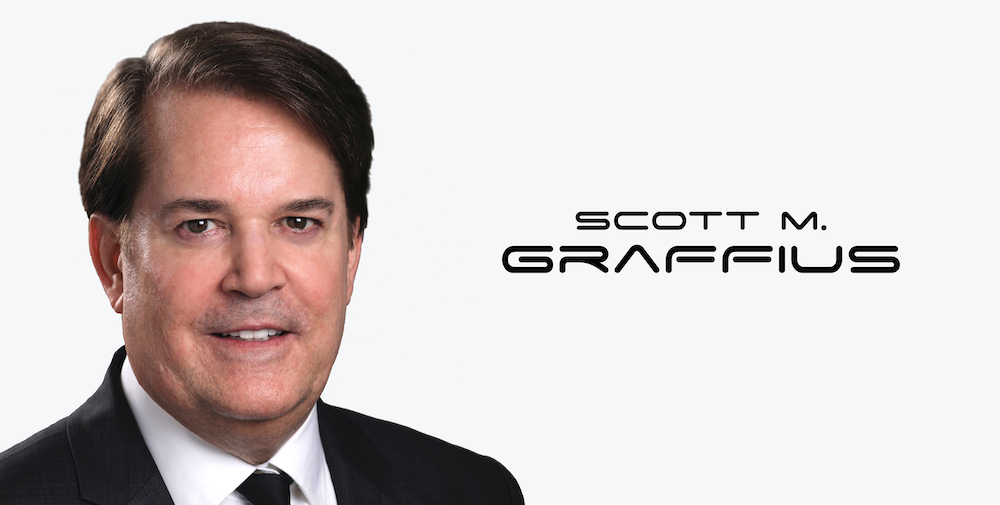
Scott M. Graffius, PMP, SA, CSP-SM, CSP-PO, CSM, CSPO, SFE, ITIL, LSSGB is an agile project management practitioner, consultant, multi-award-winning author, and international keynote speaker. He is the Founder of Exceptional PPM and PMO Solutions™ and subsidiary Exceptional Agility™. He has generated over $1.9 billion of business value in aggregate for Global Fortune 500 businesses and other organizations he has served. Graffius and content from his books, talks, workshops, and more have been featured and used by businesses, professional associations, governments, and universities. Examples include Microsoft, Oracle, Broadcom, Cisco, Gartner, Project Management Institute, IEEE, Qantas, National Academy of Sciences, United States Department of Energy, New Zealand Ministry of Education, Yale University, Tufts University, and others. He has delighted audiences with dynamic and engaging talks and workshops on agile, project management, and technology leadership at 85 conferences and other events across 25 countries.
His full bio is available here.
Connect with Scott on:


About Agile Scrum: Your Quick Start Guide with Step-by-Step Instructions

Shifting customer needs are common in today's marketplace. Businesses must be adaptive and responsive to change while delivering an exceptional customer experience to be competitive.
There are a variety of frameworks supporting the development of products and services, and most approaches fall into one of two broad categories: traditional or agile. Traditional practices such as waterfall engage sequential development, while agile involves iterative and incremental deliverables. Organizations are increasingly embracing agile to manage projects, and best meet their business needs of rapid response to change, fast delivery speed, and more.
With clear and easy to follow instructions, the multi award-winning Agile Scrum: Your Quick Start Guide with Step-by-Step Instructions book by Scott M. Graffius (Chris Hare and Colin Giffen, Technical Editors) helps the reader:
- Implement and use the most popular agile framework―Scrum;
- Deliver products in short cycles with rapid adaptation to change, fast time-to-market, and continuous improvement; and
- Support innovation and drive competitive advantage.
Hailed by Literary Titan as “the book highlights the versatility of Scrum beautifully.”
Winner of 17 first place awards.
Agile Scrum: Your Quick Start Guide with Step-by-Step Instructions is available in paperback and ebook/Kindle in the United States and around the world. Some links by country follow.
- 🇧🇷 Brazil
- 🇨🇦 Canada
- 🇨🇿 Czech Republic
- 🇩🇰 Denmark
- 🇫🇮 Finland
- 🇫🇷 France
- 🇩🇪 Germany
- 🇬🇷 Greece
- 🇭🇺 Hungary
- 🇮🇳 India
- 🇮🇪 Ireland
- 🇮🇱 Israel
- 🇮🇹 Italy
- 🇯🇵 Japan
- 🇱🇺 Luxembourg
- 🇲🇽 Mexico
- 🇳🇱 Netherlands
- 🇳🇿 New Zealand
- 🇳🇴 Norway
- 🇪🇸 Spain
- 🇸🇪 Sweden
- 🇨🇭 Switzerland
- 🇦🇪 UAE
- 🇬🇧 United Kingdom
- 🇺🇸 United States

About Agile Transformation: A Brief Story of How an Entertainment Company Developed New Capabilities and Unlocked Business Agility to Thrive in an Era of Rapid Change

Thriving in today's marketplace frequently depends on making a transformation to become more agile. Those successful in the transition enjoy faster delivery speed and ROI, higher satisfaction, continuous improvement, and additional benefits.
Based on actual events, Agile Transformation: A Brief Story of How an Entertainment Company Developed New Capabilities and Unlocked Business Agility to Thrive in an Era of Rapid Change provides a quick (60-90 minute) read about a successful agile transformation at a multinational entertainment and media company, told from the author's perspective as an agile coach.
The award-winning book by Scott M. Graffius is available in paperback and ebook/Kindle in the United States and around the world. Some links by country follow.
- 🇦🇺 Australia
- 🇦🇹 Austria
- 🇧🇷 Brazil
- 🇨🇦 Canada
- 🇨🇿 Czech Republic
- 🇩🇰 Denmark
- 🇫🇮 Finland
- 🇫🇷 France
- 🇩🇪 Germany
- 🇬🇷 Greece
- 🇮🇳 India
- 🇮🇪 Ireland
- 🇯🇵 Japan
- 🇱🇺 Luxembourg
- 🇲🇽 Mexico
- 🇳🇱 Netherlands
- 🇳🇿 New Zealand
- 🇪🇸 Spain
- 🇸🇪 Sweden
- 🇨🇭 Switzerland
- 🇦🇪 United Arab Emirates
- 🇬🇧 United Kingdom
- 🇺🇸 United States

The short URL for this article is: https://bit.ly/ai-teams
© Copyright 2023 Scott M. Graffius. All rights reserved. This material may not be published, broadcast, rewritten or redistributed without the express written permission of Scott M. Graffius.

Scott M. Graffius Speaking at Quantum Computing Conference
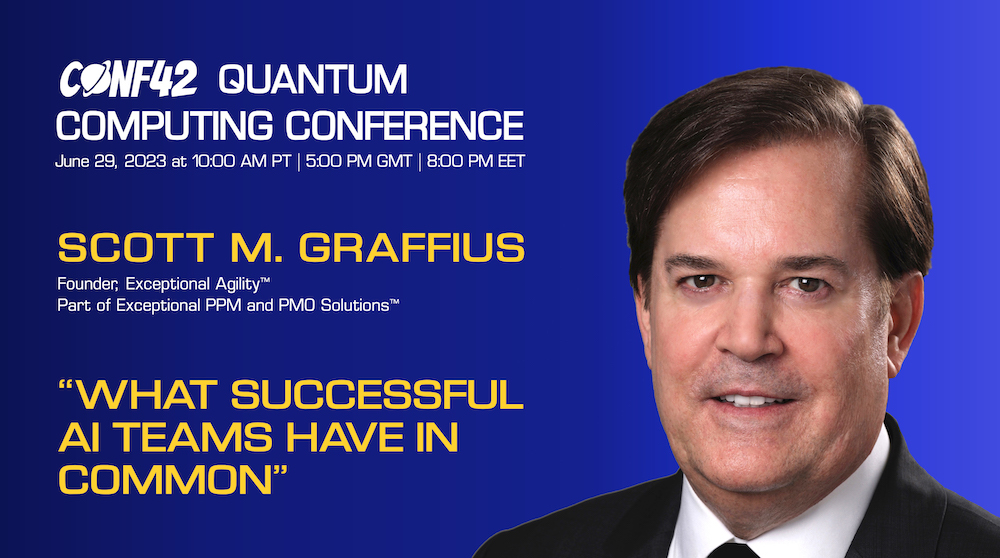
Scott M. Graffius has delivered 86 talks and workshops at conferences and other events across 25 countries. His newest engagement will be at the Conf42 Quantum Computing 2023 Conference, where he'll present “What Successful AI Teams Have in Common.” The talk draws from his work on AI projects as well as research from the Association for the Advancement of Artificial Intelligence, Google, IBM, IEEE, Microsoft, MIT, Software Engineering Institute, United States Artificial Intelligence Institute, and many others.
The conference also includes talks by:
- Daniel Goldsmith,
- Michal Jankowski,
- Trista Pan,
- Myron Giannakis,
- Peter Den Haan,
- Roberto Magnani,
- Sara Marzella, and
- Alberto García García.
Details ↴
📍 Watch the Quantum Computing Conference online
🗓 June 29, 2023 at 10:00 a.m. PT | 5:00 p.m. GMT | 8:00 p.m. EET
🎟 Subscribe to watch at: https://bit.ly/1-signup
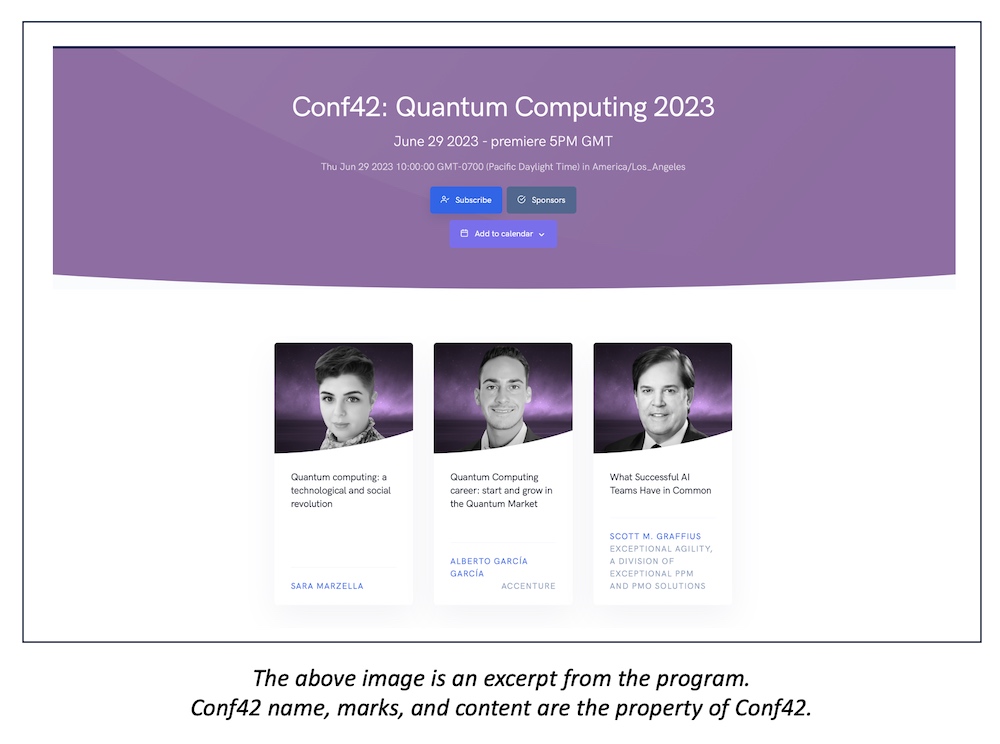



About Scott M. Graffius

Scott M. Graffius, PMP, SA, CSP-SM, CSP-PO, CSM, CSPO, SFE, ITIL, LSSGB is an agile project management practitioner, consultant, multi-award-winning author, and international keynote speaker. He is the Founder of Exceptional PPM and PMO Solutions™ and subsidiary Exceptional Agility™. He has generated over $1.9 billion of business value in aggregate for Global Fortune 500 businesses and other organizations he has served. Graffius and content from his books, talks, workshops, and more have been featured and used by businesses, professional associations, governments, and universities. Examples include Microsoft, Oracle, Broadcom, Cisco, Gartner, Project Management Institute, IEEE, Qantas, National Academy of Sciences, United States Department of Energy, New Zealand Ministry of Education, Yale University, Tufts University, and others. He has delighted audiences with dynamic and engaging talks and workshops on agile, project management, and technology (including AI) leadership at 86 conferences and other events across 25 countries.
His full bio is available here.
Connect with Scott on:


About Agile Scrum: Your Quick Start Guide with Step-by-Step Instructions

Shifting customer needs are common in today's marketplace. Businesses must be adaptive and responsive to change while delivering an exceptional customer experience to be competitive.
There are a variety of frameworks supporting the development of products and services, and most approaches fall into one of two broad categories: traditional or agile. Traditional practices such as waterfall engage sequential development, while agile involves iterative and incremental deliverables. Organizations are increasingly embracing agile to manage projects, and best meet their business needs of rapid response to change, fast delivery speed, and more.
With clear and easy to follow instructions, the multi award-winning Agile Scrum: Your Quick Start Guide with Step-by-Step Instructions book by Scott M. Graffius (Chris Hare and Colin Giffen, Technical Editors) helps the reader:
- Implement and use the most popular agile framework―Scrum;
- Deliver products in short cycles with rapid adaptation to change, fast time-to-market, and continuous improvement; and
- Support innovation and drive competitive advantage.
Hailed by Literary Titan as “the book highlights the versatility of Scrum beautifully.”
Winner of 17 first place awards.
Agile Scrum: Your Quick Start Guide with Step-by-Step Instructions is available in paperback and ebook/Kindle in the United States and around the world. Some links by country follow.
- 🇧🇷 Brazil
- 🇨🇦 Canada
- 🇨🇿 Czech Republic
- 🇩🇰 Denmark
- 🇫🇮 Finland
- 🇫🇷 France
- 🇩🇪 Germany
- 🇬🇷 Greece
- 🇭🇺 Hungary
- 🇮🇳 India
- 🇮🇪 Ireland
- 🇮🇱 Israel
- 🇮🇹 Italy
- 🇯🇵 Japan
- 🇱🇺 Luxembourg
- 🇲🇽 Mexico
- 🇳🇱 Netherlands
- 🇳🇿 New Zealand
- 🇳🇴 Norway
- 🇪🇸 Spain
- 🇸🇪 Sweden
- 🇨🇭 Switzerland
- 🇦🇪 UAE
- 🇬🇧 United Kingdom
- 🇺🇸 United States

About Agile Transformation: A Brief Story of How an Entertainment Company Developed New Capabilities and Unlocked Business Agility to Thrive in an Era of Rapid Change

Thriving in today's marketplace frequently depends on making a transformation to become more agile. Those successful in the transition enjoy faster delivery speed and ROI, higher satisfaction, continuous improvement, and additional benefits.
Based on actual events, Agile Transformation: A Brief Story of How an Entertainment Company Developed New Capabilities and Unlocked Business Agility to Thrive in an Era of Rapid Change provides a quick (60-90 minute) read about a successful agile transformation at a multinational entertainment and media company, told from the author's perspective as an agile coach.
The award-winning book by Scott M. Graffius is available in paperback and ebook/Kindle in the United States and around the world. Some links by country follow.
- 🇦🇺 Australia
- 🇦🇹 Austria
- 🇧🇷 Brazil
- 🇨🇦 Canada
- 🇨🇿 Czech Republic
- 🇩🇰 Denmark
- 🇫🇮 Finland
- 🇫🇷 France
- 🇩🇪 Germany
- 🇬🇷 Greece
- 🇮🇳 India
- 🇮🇪 Ireland
- 🇯🇵 Japan
- 🇱🇺 Luxembourg
- 🇲🇽 Mexico
- 🇳🇱 Netherlands
- 🇳🇿 New Zealand
- 🇪🇸 Spain
- 🇸🇪 Sweden
- 🇨🇭 Switzerland
- 🇦🇪 United Arab Emirates
- 🇬🇧 United Kingdom
- 🇺🇸 United States

The short URL for this article is: https://bit.ly/conf42
© Copyright 2023 Scott M. Graffius. All rights reserved. This material may not be published, broadcast, rewritten or redistributed without the express written permission of Scott M. Graffius.

Successful Video Game Development Teams Leverage an Extensive Range of Hard Skills and Soft Skills
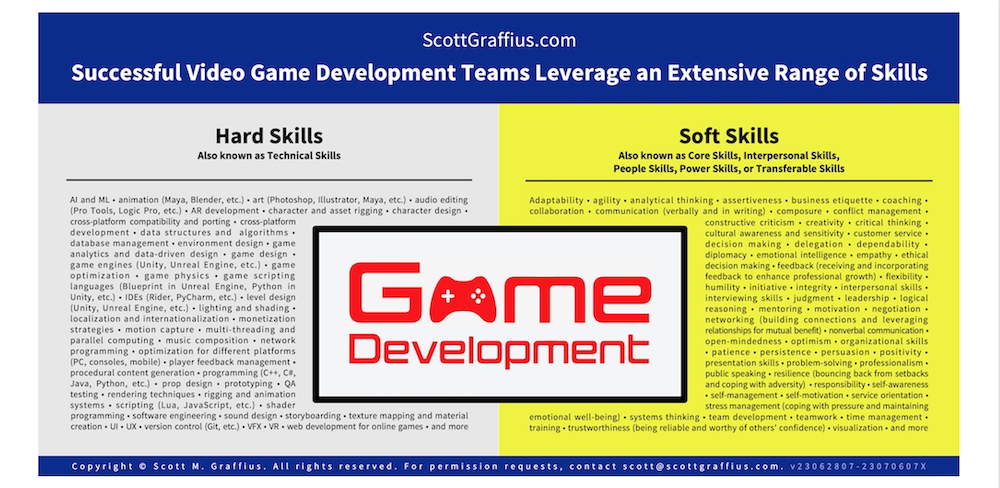
Select here to download a PDF of this article.
Behind every great video game is a team of creative and technical wizards. Creators, storytellers, designers, artists, developers, testers, and others collaborate and leverage a diverse range of hard skills (also known as technical skills) and soft skills (also known as interpersonal skills) to craft an exceptional end-product.
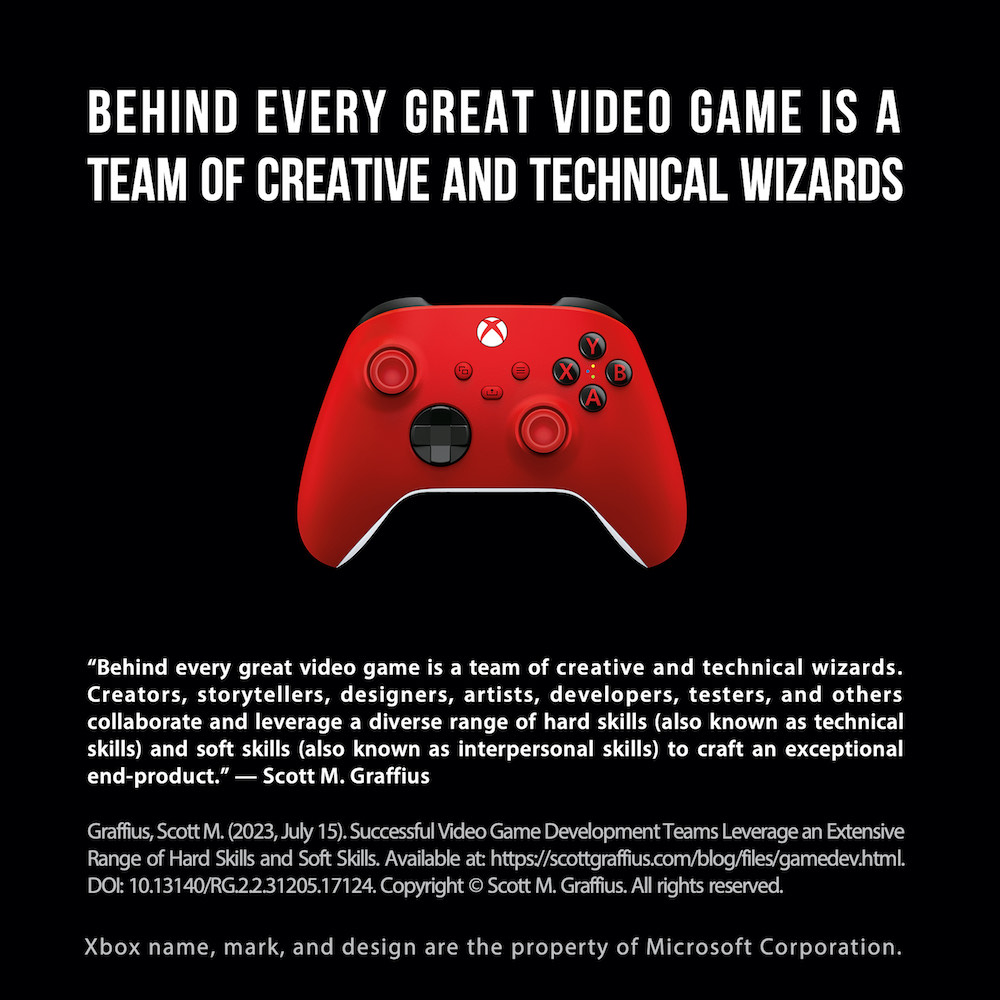
Here's a select listing of hard skills for video game development teams:
- Artificial intelligence (AI) and machine learning (ML)
- Animation (Maya, Blender, etc.)
- Art (Photoshop, Illustrator, Maya, etc.)
- Audio editing (Pro Tools, Logic Pro, etc.)
- Augmented Reality (AR) development
- Character and asset rigging
- Character design
- Cross-platform compatibility and porting
- Cross-platform development
- Data structures and algorithms
- Database management
- Environment design
- Game analytics and data-driven design
- Game design
- Game engines (Unity, Unreal Engine, etc.)
- Game optimization
- Game physics
- Game scripting languages (Blueprint in Unreal Engine, Python in Unity, etc.)
- Integrated development environment (IDE) (Rider, PyCharm, etc.)
- Level design (Unity, Unreal Engine, etc.)
- Lighting and shading
- Localization and internationalization
- Monetization strategies
- Motion capture
- Multi-threading and parallel computing
- Music composition
- Network programming
- Optimization for different platforms (consoles, PCs, mobile, AR, VR, smart TVs, streaming devices)
- Player feedback management
- Procedural content generation
- Programming (C++, C#, Java, Python, etc.)
- Prop design
- Prototyping
- Quality assurance (QA) testing
- Rendering techniques
- Rigging and animation systems
- Scripting (Lua, JavaScript, etc.)
- Shader programming
- Software engineering
- Sound design
- Storyboarding
- Texture mapping and material creation
- User interface (UI)
- User experience (UX)
- Version control (Git, etc.)
- Visual effects (VFX)
- Virtual reality (VR)
- Web development for online games
- and more
And here's a select listing of soft skills for video game development teams:
- Adaptability
- Agility
- Analytical thinking
- Assertiveness
- Business etiquette
- Coaching
- Collaboration
- Communication (verbally and in writing)
- Composure
- Conflict management
- Constructive criticism
- Creativity
- Critical thinking
- Cultural awareness and sensitivity
- Customer service
- Decision making
- Delegation
- Dependability
- Diplomacy
- Emotional intelligence
- Empathy
- Ethical decision making
- Feedback (receiving and incorporating feedback to enhance professional growth)
- Flexibility
- Humility
- Initiative
- Integrity
- Interpersonal skills
- Interviewing skills
- Judgment
- Leadership
- Logical reasoning
- Mentoring
- Motivation
- Negotiation
- Networking (building connections and leveraging relationships for mutual benefit)
- Nonverbal communication
- Open-mindedness
- Optimism
- Organizational skills
- Patience
- Persistence
- Persuasion
- Positivity
- Presentation skills
- Problem-solving
- Professionalism
- Public speaking
- Resilience (bouncing back from setbacks and coping with adversity)
- Responsibility
- Self-awareness
- Self-management
- Self-motivation
- Service orientation
- Stress management (coping with pressure and maintaining emotional well-being)
- Systems thinking
- Team development
- Teamwork
- Time management
- Training
- Trustworthiness (being reliable and worthy of others’ confidence)
- Visualization
- and more
Of the many skills, one — a soft skill — is paramount. Activision Blizzard and other premiere developers and publishers of entertainment experiences identify teamwork as critical for the successful development of video games.
Informed by Scott M. Graffius’s first-hand work with game development teams as well as research and coverage from Activision Blizzard, Gameloft, International Game Developers Association, Microsoft, Rockstar Games, Sony Interactive Entertainment, and others, Graffius delivers a deep-dive on the essential teamwork skill based on the science of high-performing teams to audiences at game development conferences and other events. The information can provide attendees, their teams, and their organization with a competitive advantage!
Invited by conferences, businesses, professional organizations, governments, and universities, Graffius delivers talks and workshops on Agile, project management, and technology leadership — inclusive of AI, GameDev, TeamDev, and more. To date, he's delivered 87 sessions across 25 countries. Visit here for details on his upcoming and prior sessions.

How to Cite This Article
Graffius, Scott M. (2023, July 15). Successful Video Game Development Teams Leverage an Extensive Range of Hard Skills and Soft Skills. Available at: https://scottgraffius.com/blog/files/gamedev.html. DOI: 10.13140/RG.2.2.31205.17124.

Permission Request Information
To request permission to use material from this article, email Scott M. Graffius.



About Scott M. Graffius
Scott M. Graffius, PMP, SA, CSP-SM, CSP-PO, CSM, CSPO, SFE, ITIL, LSSGB is an agile project management practitioner, consultant, multi-award-winning author, and international keynote speaker. He is the Founder of Exceptional PPM and PMO Solutions™ and subsidiary Exceptional Agility™. He has generated over $1.9 billion of business value in aggregate for Global Fortune 500 businesses and other organizations he has served. Graffius and content from his books, talks, workshops, and more have been featured and used by businesses, professional associations, governments, and universities. Examples include Microsoft, Oracle, Broadcom, Cisco, Gartner, Project Management Institute, IEEE, Qantas, National Academy of Sciences, United States Department of Energy, New Zealand Ministry of Education, Yale University, Tufts University, and others. He has delighted audiences with dynamic and engaging talks and workshops on agile, project management, and technology (including AI, GameDev, and more) leadership at 87 conferences and other events across 25 countries.
His full bio is available here.
Connect with Scott on:


About Agile Scrum: Your Quick Start Guide with Step-by-Step Instructions

Shifting customer needs are common in today's marketplace. Businesses must be adaptive and responsive to change while delivering an exceptional customer experience to be competitive.
There are a variety of frameworks supporting the development of products and services, and most approaches fall into one of two broad categories: traditional or agile. Traditional practices such as waterfall engage sequential development, while agile involves iterative and incremental deliverables. Organizations are increasingly embracing agile to manage projects, and best meet their business needs of rapid response to change, fast delivery speed, and more.
With clear and easy to follow instructions, the multi award-winning Agile Scrum: Your Quick Start Guide with Step-by-Step Instructions book by Scott M. Graffius (Chris Hare and Colin Giffen, Technical Editors) helps the reader:
- Implement and use the most popular agile framework―Scrum;
- Deliver products in short cycles with rapid adaptation to change, fast time-to-market, and continuous improvement; and
- Support innovation and drive competitive advantage.
Hailed by Literary Titan as “the book highlights the versatility of Scrum beautifully.”
Winner of 17 first place awards.
Agile Scrum: Your Quick Start Guide with Step-by-Step Instructions is available in paperback and ebook/Kindle in the United States and around the world. Some links by country follow.
- 🇧🇷 Brazil
- 🇨🇦 Canada
- 🇨🇿 Czech Republic
- 🇩🇰 Denmark
- 🇫🇮 Finland
- 🇫🇷 France
- 🇩🇪 Germany
- 🇬🇷 Greece
- 🇭🇺 Hungary
- 🇮🇳 India
- 🇮🇪 Ireland
- 🇮🇱 Israel
- 🇮🇹 Italy
- 🇯🇵 Japan
- 🇱🇺 Luxembourg
- 🇲🇽 Mexico
- 🇳🇱 Netherlands
- 🇳🇿 New Zealand
- 🇳🇴 Norway
- 🇪🇸 Spain
- 🇸🇪 Sweden
- 🇨🇭 Switzerland
- 🇦🇪 UAE
- 🇬🇧 United Kingdom
- 🇺🇸 United States

About Agile Transformation: A Brief Story of How an Entertainment Company Developed New Capabilities and Unlocked Business Agility to Thrive in an Era of Rapid Change

Thriving in today's marketplace frequently depends on making a transformation to become more agile. Those successful in the transition enjoy faster delivery speed and ROI, higher satisfaction, continuous improvement, and additional benefits.
Based on actual events, Agile Transformation: A Brief Story of How an Entertainment Company Developed New Capabilities and Unlocked Business Agility to Thrive in an Era of Rapid Change provides a quick (60-90 minute) read about a successful agile transformation at a multinational entertainment and media company, told from the author's perspective as an agile coach.
The award-winning book by Scott M. Graffius is available in paperback and ebook/Kindle in the United States and around the world. Some links by country follow.
- 🇦🇺 Australia
- 🇦🇹 Austria
- 🇧🇷 Brazil
- 🇨🇦 Canada
- 🇨🇿 Czech Republic
- 🇩🇰 Denmark
- 🇫🇮 Finland
- 🇫🇷 France
- 🇩🇪 Germany
- 🇬🇷 Greece
- 🇮🇳 India
- 🇮🇪 Ireland
- 🇯🇵 Japan
- 🇱🇺 Luxembourg
- 🇲🇽 Mexico
- 🇳🇱 Netherlands
- 🇳🇿 New Zealand
- 🇪🇸 Spain
- 🇸🇪 Sweden
- 🇨🇭 Switzerland
- 🇦🇪 United Arab Emirates
- 🇬🇧 United Kingdom
- 🇺🇸 United States

The short link for this article is: https://bit.ly/gamedev7
© Copyright 2023 Scott M. Graffius. All rights reserved. This material may not be published, broadcast, rewritten or redistributed without the express written permission of Scott M. Graffius.

Research by Scott M. Graffius Referenced in the 'Proceedings of the National Academy of Sciences of the United States of America'
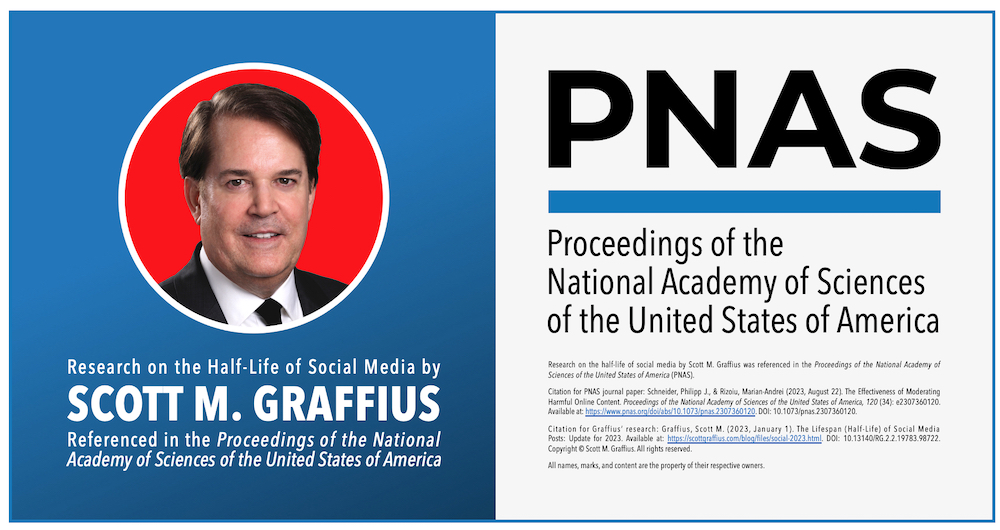
Select here to download a PDF of this article.
The Proceedings of the National Academy of Sciences of the United States of America (PNAS) references Scott M. Graffius' research on the half-life of social media. Highlights follow.
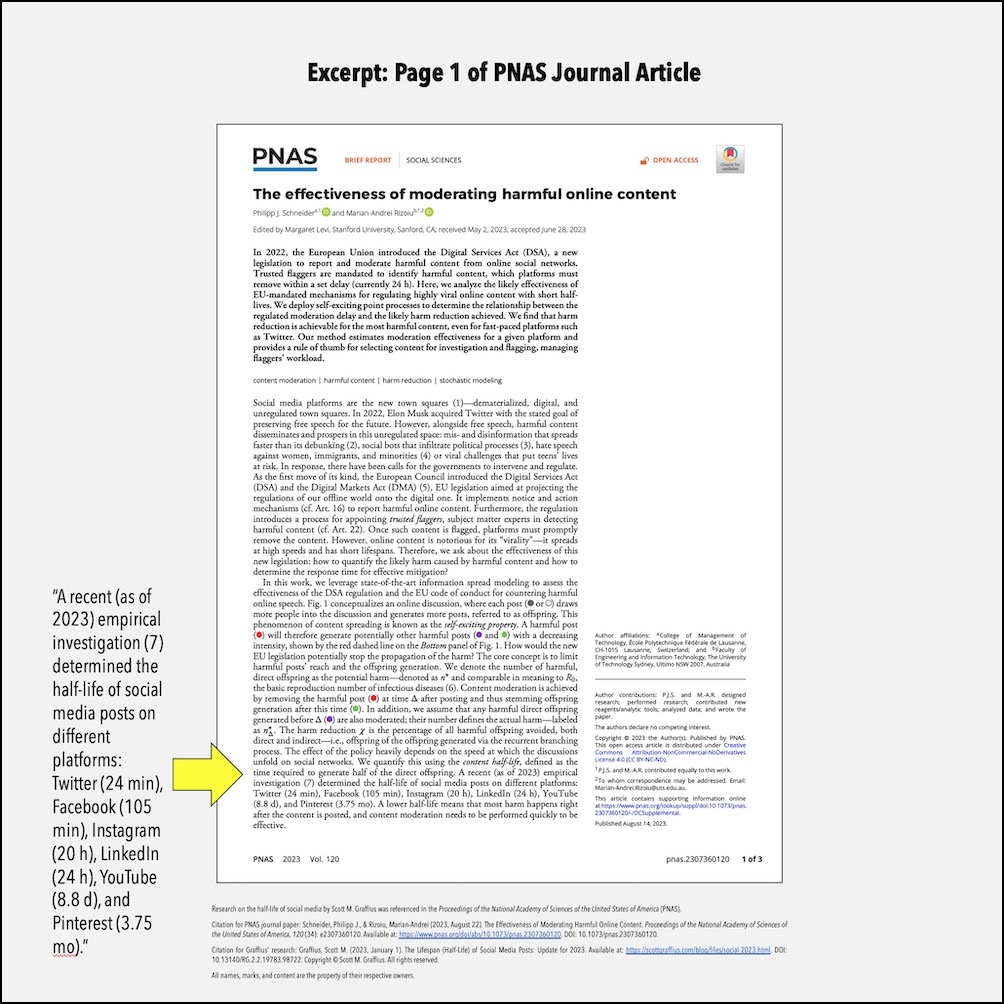
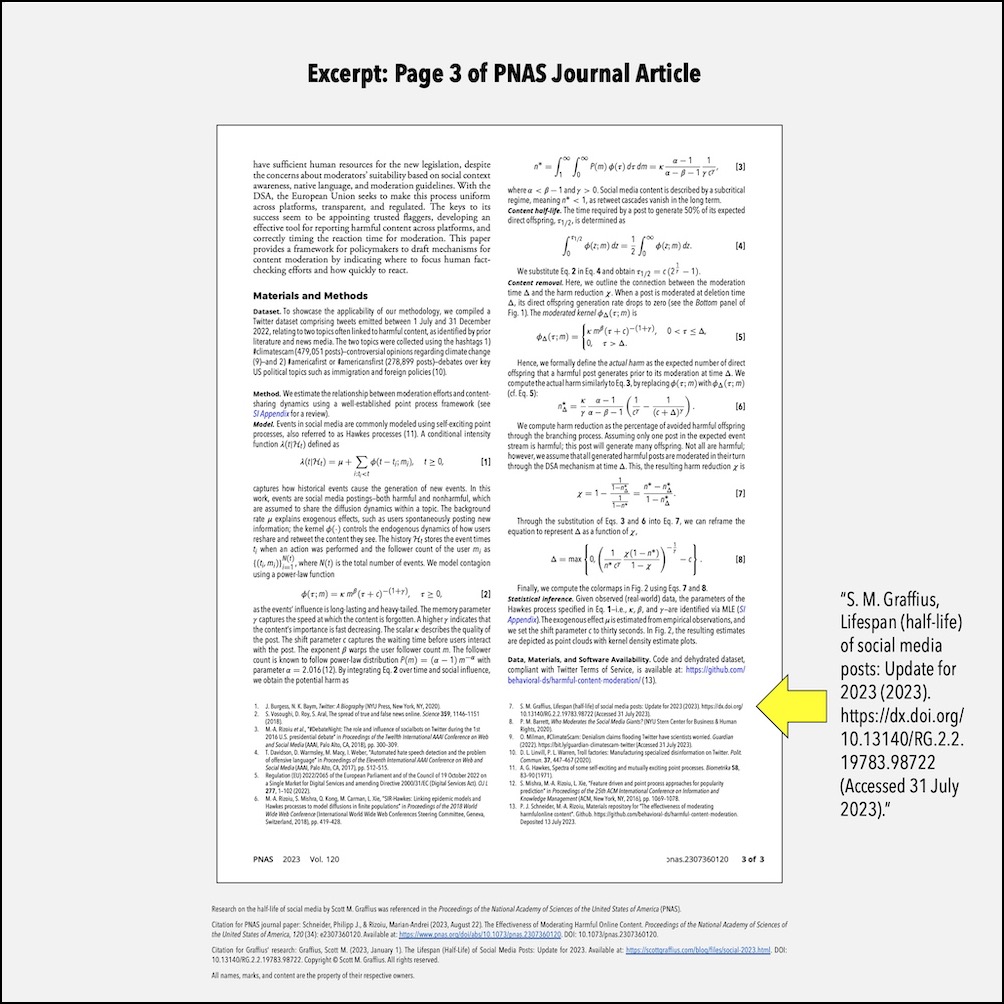
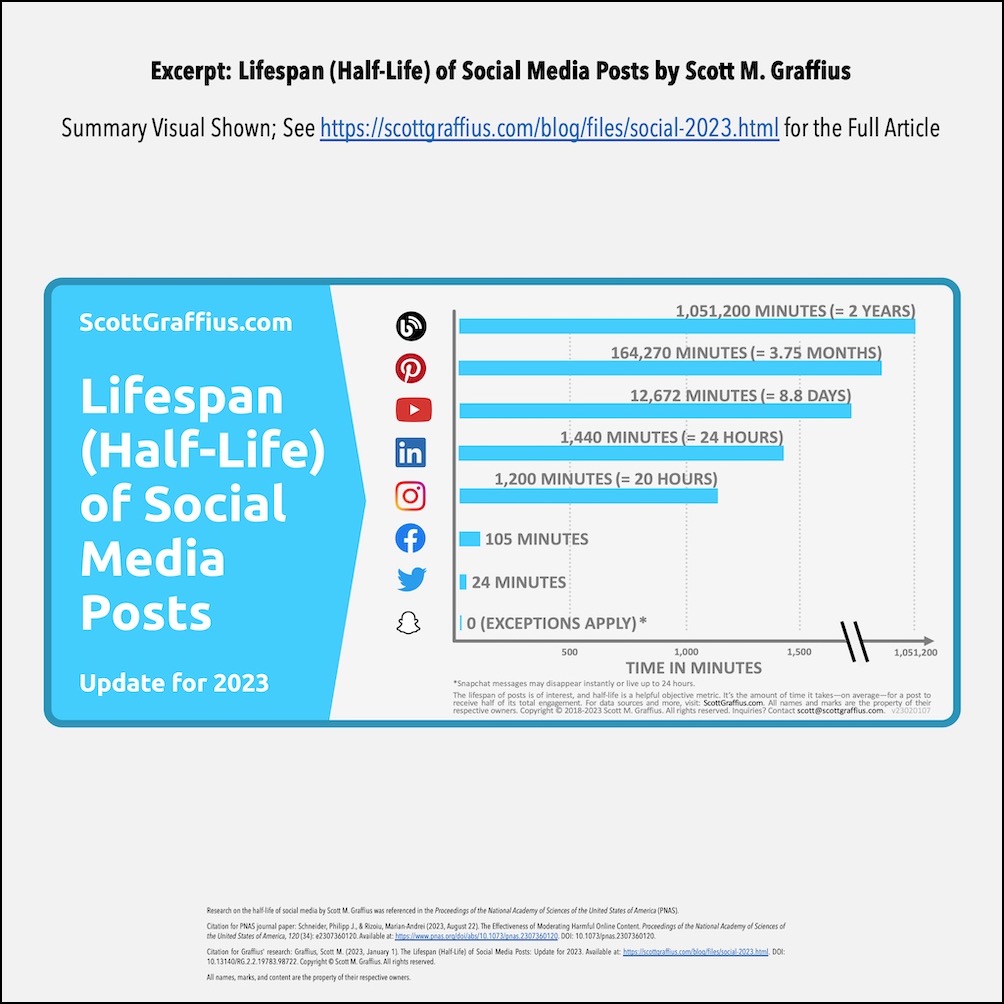
Thanks to the authors of the PNAS journal article:
- Philipp J. Schneider - College of Management of Technology, École Polytechnique Fédérale de Lausanne (EPFL), CH-1015 Lausanne, Switzerland; and
- Marian-Andrei Rizoiu - Faculty of Engineering and Information Technology, The University of Technology Sydney (UTS), Ultimo NSW 2007, Australia.
Citation for PNAS journal article:
Schneider, Philipp J., & Rizoiu, Marian-Andrei (2023, August 22). The Effectiveness of Moderating Harmful Online Content. Proceedings of the National Academy of Sciences of the United States of America, 120 (34): e2307360120. Available at: https://www.pnas.org/doi/abs/10.1073/pnas.2307360120. DOI: 10.1073/pnas.2307360120.
Citation for Graffius’ research:
Graffius, Scott M. (2023, January 1). The Lifespan (Half-Life) of Social Media Posts: Update for 2023. Available at: https://scottgraffius.com/blog/files/social-2023.html. DOI: 10.13140/RG.2.2.19783.98722. Copyright © Scott M. Graffius. All rights reserved.
About the PNAS
The Proceedings of the National Academy of Sciences of the United States of America (PNAS), a peer reviewed journal of the National Academy of Sciences (NAS), is an authoritative source of high-impact, original research that broadly spans the biological, physical, and social sciences. The journal is global in scope and submission is open to researchers worldwide.



About Scott M. Graffius

Scott M. Graffius, PMP, SA, CSP-SM, CSP-PO, CSM, CSPO, SFE, ITIL, LSSGB is an agile project management practitioner, consultant, multi-award-winning author, and international keynote speaker. He is the Founder of Exceptional PPM and PMO Solutions™ and subsidiary Exceptional Agility™. He has generated over $1.9 billion of business value in aggregate for Global Fortune 500 businesses and other organizations he has served. Graffius and content from his books, talks, workshops, and more have been featured and used by businesses, professional associations, governments, and universities. Examples include Microsoft, Oracle, Broadcom, Cisco, Gartner, Project Management Institute, IEEE, Qantas, National Academy of Sciences, United States Department of Energy, New Zealand Ministry of Education, Yale University, Tufts University, and others. He has delighted audiences with dynamic and engaging talks and workshops on agile, project management, and technology (including AI) leadership at 87 conferences and other events across 25 countries.
His full bio is available here.
Connect with Scott on:


About Agile Scrum: Your Quick Start Guide with Step-by-Step Instructions

Shifting customer needs are common in today's marketplace. Businesses must be adaptive and responsive to change while delivering an exceptional customer experience to be competitive.
There are a variety of frameworks supporting the development of products and services, and most approaches fall into one of two broad categories: traditional or agile. Traditional practices such as waterfall engage sequential development, while agile involves iterative and incremental deliverables. Organizations are increasingly embracing agile to manage projects, and best meet their business needs of rapid response to change, fast delivery speed, and more.
With clear and easy to follow instructions, the multi award-winning Agile Scrum: Your Quick Start Guide with Step-by-Step Instructions book by Scott M. Graffius (Chris Hare and Colin Giffen, Technical Editors) helps the reader:
- Implement and use the most popular agile framework―Scrum;
- Deliver products in short cycles with rapid adaptation to change, fast time-to-market, and continuous improvement; and
- Support innovation and drive competitive advantage.
Hailed by Literary Titan as “the book highlights the versatility of Scrum beautifully.”
Winner of 17 first place awards.
Agile Scrum: Your Quick Start Guide with Step-by-Step Instructions is available in paperback and ebook/Kindle in the United States and around the world. Some links by country follow.
- 🇧🇷 Brazil
- 🇨🇦 Canada
- 🇨🇿 Czech Republic
- 🇩🇰 Denmark
- 🇫🇮 Finland
- 🇫🇷 France
- 🇩🇪 Germany
- 🇬🇷 Greece
- 🇭🇺 Hungary
- 🇮🇳 India
- 🇮🇪 Ireland
- 🇮🇱 Israel
- 🇮🇹 Italy
- 🇯🇵 Japan
- 🇱🇺 Luxembourg
- 🇲🇽 Mexico
- 🇳🇱 Netherlands
- 🇳🇿 New Zealand
- 🇳🇴 Norway
- 🇪🇸 Spain
- 🇸🇪 Sweden
- 🇨🇭 Switzerland
- 🇦🇪 UAE
- 🇬🇧 United Kingdom
- 🇺🇸 United States

About Agile Transformation: A Brief Story of How an Entertainment Company Developed New Capabilities and Unlocked Business Agility to Thrive in an Era of Rapid Change

Thriving in today's marketplace frequently depends on making a transformation to become more agile. Those successful in the transition enjoy faster delivery speed and ROI, higher satisfaction, continuous improvement, and additional benefits.
Based on actual events, Agile Transformation: A Brief Story of How an Entertainment Company Developed New Capabilities and Unlocked Business Agility to Thrive in an Era of Rapid Change provides a quick (60-90 minute) read about a successful agile transformation at a multinational entertainment and media company, told from the author's perspective as an agile coach.
The award-winning book by Scott M. Graffius is available in paperback and ebook/Kindle in the United States and around the world. Some links by country follow.
- 🇦🇺 Australia
- 🇦🇹 Austria
- 🇧🇷 Brazil
- 🇨🇦 Canada
- 🇨🇿 Czech Republic
- 🇩🇰 Denmark
- 🇫🇮 Finland
- 🇫🇷 France
- 🇩🇪 Germany
- 🇬🇷 Greece
- 🇮🇳 India
- 🇮🇪 Ireland
- 🇯🇵 Japan
- 🇱🇺 Luxembourg
- 🇲🇽 Mexico
- 🇳🇱 Netherlands
- 🇳🇿 New Zealand
- 🇪🇸 Spain
- 🇸🇪 Sweden
- 🇨🇭 Switzerland
- 🇦🇪 United Arab Emirates
- 🇬🇧 United Kingdom
- 🇺🇸 United States

The short URL for this article is: https://bit.ly/pnas-blog
© Copyright 2023 Scott M. Graffius. All rights reserved. This material may not be published, broadcast, rewritten or redistributed without the express written permission of Scott M. Graffius.

Scott M. Graffius’ Phases of Team Development: 2024 Update
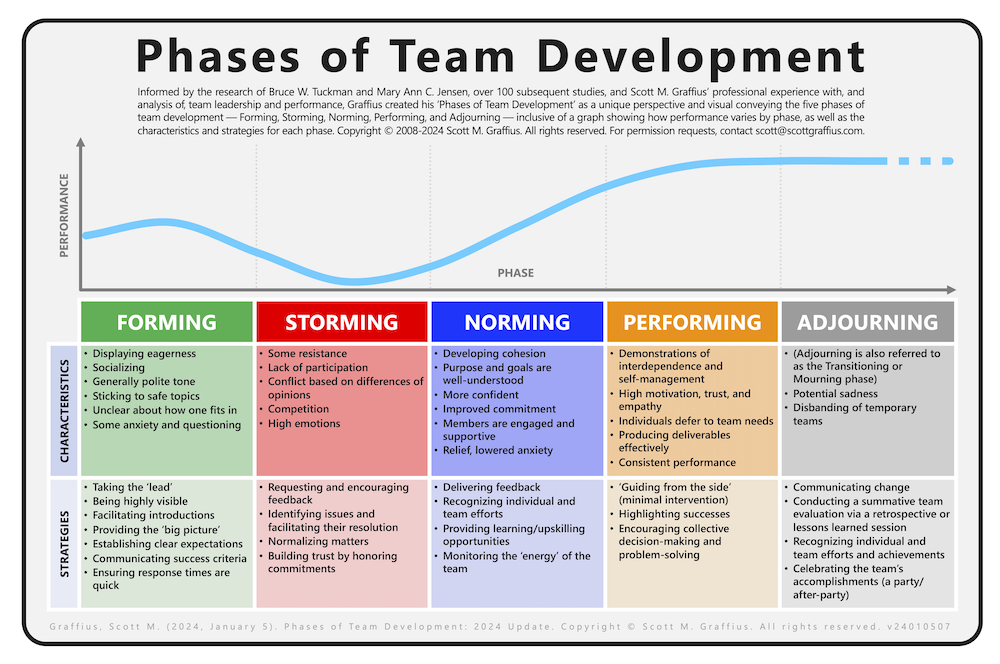
High Resolution Files of Visual: See Permission Request Information section

If there are any supplements or updates to this article after the date of publication, they will appear in the Post-Publication Notes section at the end of this article.


Introduction
Informed by the research of Bruce W. Tuckman and Mary Ann C. Jensen, over 100 subsequent studies, and Scott M. Graffius’ first-hand professional experience with, and analysis of, team leadership and performance, Graffius created his ‘Phases of Team Development’ as a unique perspective and visual conveying the five phases of team development — Forming, Storming, Norming, Performing, and Adjourning — inclusive of a graph showing how performance varies by phase, as well as the characteristics and strategies for each phase.
Project Managers, Scrum Masters, Agile Coaches, DevOps Leads, and other leaders can apply the information to help handle challenges or issues experienced by teams. By doing so, they’ll advance the teams’ (and their own) happiness, productivity, and success.
Graffius initially developed his unique material in 2008, and he periodically refreshes it. This article (including the accompanying visual) provides the 2024 update to his ‘Phases of Team Development’ work.
Graffius’ work has “team development” in the title. Alternative terms — which may be interchangeable in the context of this article — include group development, group dynamics, team agility, team building, team coaching, team collaboration, teamcraft, team dynamics, team leadership, team optimization, team performance, team tradecraft, and teamwork.

Five Phases of Team Development
1. Forming
Characteristics of the Forming phase include displaying eagerness, socializing, generally polite tone, sticking to safe topics, unclear about how one fits in, and some anxiety and questioning.
Strategies for Forming include taking the ‘lead,’ being highly visible, facilitating introductions, providing the ‘big picture,’ establishing clear expectations, communicating success criteria, and ensuring response times are quick.
2. Storming
Traits of the Storming phase include some resistance, lack of participation, conflict based on differences of opinions, competition, and high emotions.
Strategies for Storming include requesting and encouraging feedback, identifying issues and facilitating their resolution, normalizing matters, and building trust by honoring commitments.
3. Norming
Features of the Norming phase include developing cohesion; purpose and goals are well-understood; more confident; improved commitment; members are engaged and supportive; and relief, lowered anxiety.
Strategies for Norming include delivering feedback, recognizing individual and team efforts, providing learning/upskilling opportunities, and monitoring the ‘energy’ of the team.
4. Performing
Characteristics of the Performing phase include demonstrations of interdependence and self-management; high motivation, trust, and empathy; individuals defer to team needs; producing deliverables effectively; and consistent performance.
Strategies for Performing include ‘guiding from the side’ (minimal intervention), highlighting successes, and encouraging collective decision-making and problem-solving.
5. Adjourning
Typical traits of the Adjourning phase (also referred to as the Transitioning or Mourning phase) include potential sadness, and disbanding of temporary teams.
Strategies for Adjourning include communicating change, conducting a summative team evaluation via a retrospective or lessons learned session, recognizing individual and team efforts and achievements, and celebrating the team's accomplishments (a party/after-party).

Conclusion
Project Managers, Scrum Masters, Agile Coaches, DevOps Leads, and other leaders can apply the information in this article and the accompanying visual to help handle challenges or issues experienced by teams. By doing so, they’ll advance the teams’ (and their own) happiness, productivity, and success.
This article provided a brief overview of the five phases of team development. Scott M. Graffius presents dynamic and engaging talks and workshops on this topic and more at conferences and other events (public and private/corporate) around the world. To learn more, visit here. For booking information, please complete a speaker engagement request form or email Scott M. Graffius.
If you're looking for additional information on this article (such as references/sources, citation details, or permission request information), read on.

Graffius’ Research is Widely Cited, Featured, and Used
Businesses, scientists, journalists, professional associations, government agencies, universities, and others around the world have featured and used prior — 2023 and earlier — editions of Scott M. Graffius’ ‘Phases of Team Development’ material. Here are a few examples:
- Academic Cooperation Association
- Adobe
- American Management Association
- Amsterdam Public Health Research Institute
- Bayer
- Boston University
- CodeMonk
- Dagen
- Deimos Aerospace
- Erste Bank
- FSU College of Medicine
- Hasso Plattner Institute (Hasso-Plattner-Institut für Digital Engineering GmbH)
- IEEE
- Innovify
- Life Sciences Trainers & Educators Network (LTEN)
- London South Bank University
- New Zealand Government
- Prima Resource
- Singapore University of Social Sciences
- Technical University of Munich
- Torrens University Australia
- UK Sports Institute
- University of Galway Ireland
- University of Graz Austria
- University of Waterloo
- US National Park Service
- Virginia Tech
- Warsaw University of Technology
- Yale University
- Zittau/Gorlitz University of Applied Sciences
- And many more

References/Sources
Select (partial) bibliography:
- Activision Blizzard (2022, September 9). Tackling the Talent Shortage: Identifying the Skills Critical for Game Development. Available at: https://www.activisionblizzard.com/content/atvi/activisionblizzard/ab-touchui/ab/web/en/newsroom/2022/09/tackling-the-talent-shortage.html.
- Alfateh, Maryam Ali Abu; Messaadia, Mourad; and Ali, Mazen (2023, September). Exploring the Dynamics of Team Formation in Human-Artificial Intelligence Collaboration. In 2023 International Conference on Decision Aid Sciences and Applications (DASA), pp. 384-388, DOI: 10.1109/DASA59624.2023.10286788.
- Alford, J. (2019, April 11). Our Co-Production Journey: From Sandpits to Bird Boxes. London, United Kingdom: Imperial College London.
- Ali, A. J., Fuenzalida, J., Gómez, M., & Williams, M. J. (2021, June). Four Lenses on People Management in the Public Sector: An Evidence Review and Synthesis. Oxford Review of Economic Policy, 37 (2): 335-366.
- Amsterdam Public Health Research Institute (2021). APH Quality Handbook. Amsterdam: Amsterdam Public Health Research Institute.
- Bandai Namco (n.d.). Teamwork Makes the Dream Work. Available at: https://bandainamcomobile.com/news/power-up-your-teamwork-how-bandai-namco-mobile-builds-stronger-teams.
- Bellet, C., De Neve, J., & Ward, G. (2019 October 14). Does Employee Happiness Have an Impact on Productivity? Saïd Business School WP 2019-13. Oxford, UK: Oxford University.
- Bennett, M., Gadlin, H., & Marchand, C. (2018). Collaboration Team Science: Field Guide. Rockville, MD: National Institutes of Health.
- Berlin School of Business and Innovation (2022, September 22). How Do Technical Abilities Combined with Leadership Skills Fuel Career Growth? Available at: https://www.berlinsbi.com/blog/career-advice/how-do-technical-abilities-combined-with-leadership-skills-fuel-career-growth.
- Brief, A. P. & Weiss, H. M. (2022, February). Organizational Behavior: Affect in the Workplace. Annual Review of Psychology, 53 (1): 279-307.
- Cisco (2019). Next-Generation IT Talent Strategies: How CIOs Can Close the Skills Gap and Drive True Business Transformation. Available at: https://www.cisco.com/c/dam/global/en_uk/solutions/executive-perspectives/pdf/ITTalent.pdf.
- Couture, N. (2016, October 27). A Note About Teams. CIO. Boston, MA: International Data Group (IDG).
- Daly, L. (2002). Identify Your Project Management Team’s Level of Development and Facilitate It to Success. Paper presented at Project Management Institute Annual Seminars and Symposium, San Antonio, TX. Newtown Square, PA: Project Management Institute.
- Dechurch, Leslie; & Mesmer-Magnus, Jessica. (2010). The Cognitive Underpinnings of Effective Teamwork: A Meta-Analysis. The Journal of Applied Psychology, 95: 32-53.
- Defense Advanced Research Projects Agency (DARPA) (2023, February 23). Episode 65: A Sprint to Tomorrow, Powered by Teamwork [Podcast]. Available at: https://www.darpa.mil/news-events/2023-02-23a.
- Deloitte (2017). Digital Era Technology Operating Models, Volume 2. New York, NY: Deloitte Touche Tohmatsu Limited.
- DevOps Institute (2021). 2021 Upskilling Enterprise DevOps Skills Report. Boca Raton, FL: DevOps Institute.
- Dickinson, A.; & Stoneman, K. (1989). Individual Performance as a Function of Group Contingencies and Group Size. Journal of Organizational Behavior Management, 10: 131-150.
- Dolev, Niva, & Itzkovich, Yariv (2020). In the AI Era, Soft Skills are the New Hard Skills. In: Artificial Intelligence and Its Impact on Business, pp. 55-77. Charlotte, NC: Information Age Publishing.
- Dzombak, Rachel, & Palat, Jay (2021, August 30). 5 Ways to Start Growing an AI-Ready Workforce. Pittsburgh, PA: Software Engineering Institute, Carnegie Mellon University.
- Elliott, Joshua (n.d.). Artificial Social Intelligence for Successful Teams (ASIST). Arlington, VA: Defense Advanced Research Projects Agency (DARPA).
- Exceptional Agility (2023, January 1). Making Teams More Agile: Strategies and Benefits. Available at: https://exceptionalagility.com/blog/files/teams.html.
- Finkelstein, S. (2017, October 29). Why Companies Should Hire Teams, Not Individuals. The Wall Street Journal. New York, NY: The Wall Street Journal.
- Forbes (2018, April 23). How to Fast-Track Any Team to Success. Forbes. New York, NY: Forbes.
- Forbes (2012, October 27). How the iPad Mini is Defining Tim Cook’s Apple. Forbes. New York, NY: Forbes.
- Gartner (2020, December 15). How to Staff Your AI Team. Available at: https://www.gartner.com/smarterwithgartner/how-to-staff-your-ai-team.
- Glover, P. (2012, March 13). Team Conflict: Why It’s a Good Thing. Fast Company. New York, NY: Mansueto Ventures.
- Gorman, Austin (2023, April 27). How to Strengthen Your Soft Skills for AI and the Future of Work. Fast Company. Available at: https://www.fastcompany.com/90887540/how-to-strengthen-your-soft-skills-for-ai-and-the-future-of-work.
- Graffius, Scott M. (2023, October 13). The Science of High-Performance Game Development Teams [Presentation]. Talk delivered at the W Love Games International Video Game Development Conference 2023 - Helsinki, Finland. Digital Object Identifier (DOI): 10.13140/RG.2.2.28602.16326. DOI link: https://dx.doi.org/10.13140/RG.2.2.28602.16326.
- Graffius, Scott M. (2023, July 15). Successful Video Game Development Teams Leverage an Extensive Range of Hard Skills and Soft Skills. Available at: https://scottgraffius.com/blog/files/gamedev.html. DOI: 10.13140/RG.2.2.31205.17124.
- Graffius, Scott M. (2023, April 26). The Science of High-Performance Teams [Presentation]. Talk delivered at the DevOps Institute’s SKILup Day 2023 Conference. Digital Object Identifier (DOI): 10.13140/RG.2.2.15888.28169. DOI link: https://dx.doi.org/10.13140/RG.2.2.15888.28169.
- Graffius, Scott M. (2023, January 9). Use the Phases of Team Development (Based on Bruce W. Tuckman's Model of Forming, Storming, Norming, Performing, and Adjourning) to Help Teams Grow and Advance: 2023 Update. Available at: https://scottgraffius.com. Digital Object Identifier (DOI): 10.13140/RG.2.2.10720.35846. DOI link: https://dx.doi.org/10.13140/RG.2.2.10720.35846.
- Graffius, Scott M. (2023, June 29). What Successful AI Teams Have in Common [Presentation]. Talk delivered at Conf42 Quantum Computing 2023 Conference. Digital Object Identifier (DOI): 10.13140/RG.2.2.29382.45120. DOI link: https://dx.doi.org/10.13140/RG.2.2.29382.45120.
- Graffius, Scott M. (2023, May 1). Fueling the Development of Innovative and Life-Changing AI Solutions [Presentation]. Talk delivered to an audience of Technology professionals (including Data Scientists, Machine Learning Engineers, Data Engineers, AI Researchers, Project Managers, Business Analysts, UX Designers, Software Developers, Cloud Architects, Data Privacy and Security Specialists, and others involved or interested in AI) at a private event in Mountain View, California, United States. Digital Object Identifier (DOI): 10.13140/RG.2.2.27956.73601. DOI link: https://dx.doi.org/10.13140/RG.2.2.27956.73601.
- Graffius, Scott M. (2022, February 4). Team Development Tradecraft: A Source of Competitive Advantage [Workshop]. Session at private event in Adelaide, Australia. DOI: 10.13140/RG.2.2.14092.80002.
- Graffius, Scott M. (2022, May 13). Want Happier and More Productive DevOps Teams? [Presentation]. Talk delivered at DevOpsDays Geneva, Switzerland 2022 Conference. Digital Object Identifier (DOI): 10.13140/RG.2.2.22252.85127. DOI link: https://dx.doi.org/10.13140/RG.2.2.22252.85127.
- Graffius, Scott M. (2021, February 20). But First, the Team! [Presentation]. Talk delivered at the Brno, Czech Republic DevConf.CZ 2021 Conference. Digital Object Identifier (DOI): 10.13140/RG.2.2.29016.72964. DOI link: https://dx.doi.org/10.13140/RG.2.2.29016.72964.
- Graffius, Scott M. (2021, June 21). DevOps and Team Leadership [Workshop]. Session at private event in Las Vegas, NV. DOI: 10.13140/RG.2.2.15380.22401.
- Graffius, Scott M. (2021, May 13). But First, the Team! [Presentation]. Lecture delivered at DevOps Pro Europe 2021 Conference. Based and simulcast live from Vilnius, Lithuania. DOI: 10.13140/RG.2.2.30524.36481.
- Graffius, Scott M. (2021, November 10). An Error Was Introduced Into the Seventh Edition of 'A Guide to the Project Management Body of Knowledge (PMBOK).’ Los Angeles, CA: Scott M. Graffius.
- Graffius, Scott M. (2021, November 8). Bruce Tuckman’s Model (Forming, Storming, Norming, Performing, and Adjourning) is Highly Relevant and Beneficial, But It Doesn’t Please Everyone. Los Angeles, CA: Scott M. Graffius.
- Graffius, Scott M. (2021, October 5). Navigate the Phases of Team Development with Speed and Agility for Happier and More Productive Teams [Presentation]. Talk delivered at the Institute of Electrical and Electronics Engineers IEEE Day 2021 Conference. Digital Object Identifier (DOI): 10.13140/RG.2.2.20055.19365. DOI link: https://dx.doi.org/10.13140/RG.2.2.20055.19365.
- Graffius, Scott M. (2021). Phases of Team Development. Los Angeles, CA: Scott M. Graffius. Digital Object Identifier (DOI): 10.13140/RG.2.2.22040.42246.
- Graffius, Scott M. (2018, October 18). Agile Scrum Helps Innovators, Disruptors, and Entrepreneurs Develop and Deliver Products at Astounding Speed Which Drives Competitive Advantage [Presentation]. Talk delivered at Techstars Startup Week Conference. DOI: 10.13140/RG.2.2.25009.12647.
- Himmelstein, D. (2018, January 26). Team Cycles and Culture Development. San Jose, CA: Acer, Inc.
- Humphrey, W. S., Chick, T. A., Nichols, W., and Pomeroy-Huff, M. (2010). Software Engineering Institute’s Team Software Process Body of Knowledge. Pittsburgh, PA: Carnegie Mellon University.
- Infinity Ward (n.d.). Infinity Ward. Available at: https://www.infinityward.com.
- International Game Developers Association (IGDA) (n.d.). IGDA Foundation. Available at: https://igda.org/igda-foundation/.
- Jovanovic, M., Mesquida, A., Radaković, N., & Mas, A. (2016). Agile Retrospective Games for Different Team Development Phases. Journal of Universal Computer Science, 22: 1489-1508.
- KPMG (2017). The Digital Fund, Season 2. Amstelveen, Netherlands: KPMG International.
- Leswing, Kif (2023, June 5). Apple’s Practical Approach to A.I.: No Bragging, Just Features. CNBC. Available at: https://www.cnbc.com/2023/06/05/apple-practical-approach-to-ai-no-bragging-just-features.html.
- Life Sciences Trainers and Educators Network (LTEN) (2022). Leveraging a Cross-Functional Training Task Force to Create Training that Doesn’t Suck. LTEN 2022 Conference.
- Madden, D. (2019, May 19). The Four Stages of Building a Great Team – and the One Where Things Usually Go Wrong. Inc. Magazine. New York, NY: Inc. Magazine.
- Makar, A. (2011, July 13). Lessons Learned in Norming and Performing Team Development Phases. Louisville, KY: Tech Republic.
- Martinuzzi, B. (2012, June 8). Six Tips Guaranteed to Reduce Workplace Frustrations. New York, NY: American Express Company.
- Massachusetts Institute of Technology (MIT) (2021, January). Cognitive Science as a New People Science for the Future of Work. Available at: https://workofthefuture.mit.edu/wp-content/uploads/2021/01/2021-Research-Brief-Polli-Kassir-Dolphin-Baker-Gabrieli.pdf.
- Microsoft (2019, June 15). Is the Latest Technology the Key to Your Team’s Success, or is There Something Else? Microsoft Developer Support. Accessed at: https://devblogs.microsoft.com/premier-developer/is-the-latest-technology-the-key-to-your-teams-success-or-is-there-something-else. Redmond, WA: Microsoft.
- Mocko, G., & Linnerud, B. (2016). Measuring the Effects of Goal Alignment on Innovative Engineering Design Projects. International Journal of Engineering Education, 32: 55-63.
- Negrón, A.P.P., Carranza, D.B., Muñoz, M. (2023). Video Game Development Process for Soft Skills Analysis. In: Mejia, J., Muñoz, M., Rocha, Á., Hernández-Nava, V. (eds), New Perspectives in Software Engineering. Proceedings of the 11th International Conference on Software Process Improvement (CIMPS 2022). Lecture Notes in Networks and Systems, vol. 576. New York, NY: Springer.
- Riggs, A. (2020, October 15). Why I Start All My Video Meetings with Collaborative Games (Spoiler: It’s Not Boredom). Amsterdam, the Netherlands: The Next Web (TNW).
- Romanelli, M. (2019, September 11). Teamwork Accelerated. PM Times. Newmarket, Ontario, Canada: Macgregor Communications.
- Rowley, D., & Lange, M. (2007). Forming to Performing: The Evolution of an Agile Team. IEEE Computer Society Proceedings. Agile 2007, 1: 408-414.
- Sakpal, M. (2020, March 3. Learn How to Debunk These Five Restructuring Myths. Stamford, CT: Gartner, Inc.
- Sazali, A. R. B.; Khamarudin, F. B.; & Abdul Alahdad, S. N. B. (2022). Maximising the Zone of Proximal Development Benefits in Group Online Learning. International Journal of Academic Research in Business and Social Sciences, 12 (6): 1476-1496.
- Scaled Agile, Inc. (2023, March 14). Working Successfully in Agile with Remote Team Members. Available at: https://scaledagileframework.com/working-successfully-in-agile-with-remote-team-members/.
- Scrum Alliance (2020). Learning Objectives Examples. Denver, CO: Scrum Alliance.
- Stanford University (2019, September). Gathering Strength, Gathering Storms. Stanford, CA: Stanford University.
- Steiner, Ivan D. (1972). Group Process and Productivity. New York, New York: Academic Press.
- Stern, S. (2018, September 26). Is Your Team Working the Rory Underwood Way? Financial Times. London, United Kingdom: The Financial Times, a Nikkei Company.
- Tamiru, Natasha (2023, June). Team Dynamics: Five Keys to Building Effective Teams. Google. Available at: https://www.thinkwithgoogle.com/intl/en-emea/consumer-insights/consumer-trends/five-dynamics-effective-team.
- Tannenbaum, Robert, & Schmidt, Warren H. (1958). How to Choose a Leadership Pattern. Harvard Business Review, 36: 95- 101.
- Telford, R. (2013, June 4). This is Where It Gets Interesting. Armonk, NY: International Business Machines (IBM) Corporation.
- Thier, Jane (2021, December 8). 'Form, Storm, Norm, Perform’: Twitter’s New CEO Faces a Critical Few Months as He Seeks to Differentiate Himself from Jack Dorsey, Leadership Experts Say. Fortune. Available at: https://fortune.com/2021/12/08/form-storm-norm-perform-twitters-new-ceo-faces-a-critical-few-months-as-he-seeks-to-differentiate-himself-from-jack-dorsey-leadership-experts-say/.
- Tuckman, B. W. (1965). Developmental Sequence in Small Groups. Psychological Bulletin, 63: 384-399.
- Tuckman, B. W., & Jensen, M. A. C. (1977). Stages of Small-Group Development Revisited. Group and Organizational Studies, 2 (4): 419-427.
- United States Army (2015). Innovative Learning: A Key to National Security. Washington, DC: United States Army.
- United States National Park Service (NPS) (2022, Spring). NPS Aviation Safety.
- Wheelan, S. A. (2009). Group Size, Group Development, and Group Productivity. Small-Group Research, 40 (2): 247-262.

How to Cite This Article
Graffius, Scott M. (2024, January 5). Scott M. Graffius’ Phases of Team Development: 2024 Update. Available at: https://scottgraffius.com/blog/files/teams-2024.html. DOI: 10.13140/RG.2.2.28629.40168.

Permission Request Information
To request permission to use the ‘Phases of Team Development’ visual shown at the top of this article or any other material from this publication, email Scott M. Graffius. If your request is approved, Graffius will give you an authorization/license and, if applicable, high-resolution files of the visual.

About Scott M. Graffius

Scott M. Graffius, PMP, SA, CSP-SM, CSP-PO, CSM, CSPO, SFE, ITIL, LSSGB is an agile project management practitioner, consultant, thinker, creator, multi-award-winning author, and international public speaker. Founder and CEO of Exceptional PPM and PMO Solutions™ and subsidiary Exceptional Agility™, he has generated over $1.9 billion for Global Fortune 500 businesses and other organizations he has served. Graffius and content from his books, talks, workshops, and more have been featured and used by Microsoft, Oracle, Broadcom, Cisco, Gartner, Project Management Institute, IEEE, National Academy of Sciences, United States Department of Energy, Yale University, Tufts University, and others. He delights audiences with dynamic and engaging talks and workshops on agile project management, AI, Tech leadership, video game development, strategic alignment, the science of high performance teams, and more. To date, he's presented sessions at 89 conferences and other events across 25 countries.
His full bio is available here.
Connect with Scott on:

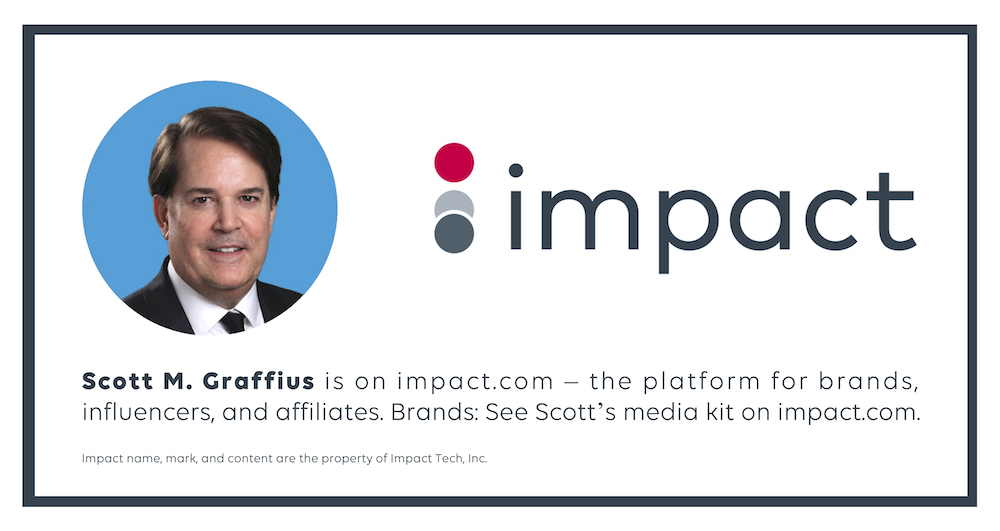

About Agile Scrum: Your Quick Start Guide with Step-by-Step Instructions

Shifting customer needs are common in today's marketplace. Businesses must be adaptive and responsive to change while delivering an exceptional customer experience to be competitive.
There are a variety of frameworks supporting the development of products and services, and most approaches fall into one of two broad categories: traditional or agile. Traditional practices such as waterfall engage sequential development, while agile involves iterative and incremental deliverables. Organizations are increasingly embracing agile to manage projects, and best meet their business needs of rapid response to change, fast delivery speed, and more.
With clear and easy to follow step-by-step instructions, Scott M. Graffius's award-winning Agile Scrum: Your Quick Start Guide with Step-by-Step Instructions helps the reader:
- Implement and use the most popular agile framework―Scrum;
- Deliver products in short cycles with rapid adaptation to change, fast time-to-market, and continuous improvement; and
- Support innovation and drive competitive advantage.
Hailed by Literary Titan as “the book highlights the versatility of Scrum beautifully.”
Winner of 17 first place awards.
Agile Scrum: Your Quick Start Guide with Step-by-Step Instructions is available in paperback and ebook/Kindle in the United States and around the world. Some links by country follow.
- 🇧🇷 Brazil
- 🇨🇦 Canada
- 🇨🇿 Czech Republic
- 🇩🇰 Denmark
- 🇫🇮 Finland
- 🇫🇷 France
- 🇩🇪 Germany
- 🇬🇷 Greece
- 🇭🇺 Hungary
- 🇮🇳 India
- 🇮🇪 Ireland
- 🇮🇱 Israel
- 🇮🇹 Italy
- 🇯🇵 Japan
- 🇱🇺 Luxembourg
- 🇲🇽 Mexico
- 🇳🇱 Netherlands
- 🇳🇿 New Zealand
- 🇳🇴 Norway
- 🇪🇸 Spain
- 🇸🇪 Sweden
- 🇨🇭 Switzerland
- 🇦🇪 UAE
- 🇬🇧 United Kingdom
- 🇺🇸 United States

About Agile Transformation: A Brief Story of How an Entertainment Company Developed New Capabilities and Unlocked Business Agility to Thrive in an Era of Rapid Change

Thriving in today's marketplace frequently depends on making a transformation to become more agile. Those successful in the transition enjoy faster delivery speed and ROI, higher satisfaction, continuous improvement, and additional benefits.
Based on actual events, Agile Transformation: A Brief Story of How an Entertainment Company Developed New Capabilities and Unlocked Business Agility to Thrive in an Era of Rapid Change provides a quick (60-90 minute) read about a successful agile transformation at a multinational entertainment and media company, told from the author's perspective as an agile coach.
The award-winning book by Scott M. Graffius is available in paperback and ebook/Kindle in the United States and around the world. Some links by country follow.
- 🇦🇺 Australia
- 🇦🇹 Austria
- 🇧🇷 Brazil
- 🇨🇦 Canada
- 🇨🇿 Czech Republic
- 🇩🇰 Denmark
- 🇫🇮 Finland
- 🇫🇷 France
- 🇩🇪 Germany
- 🇬🇷 Greece
- 🇮🇳 India
- 🇮🇪 Ireland
- 🇯🇵 Japan
- 🇱🇺 Luxembourg
- 🇲🇽 Mexico
- 🇳🇱 Netherlands
- 🇳🇿 New Zealand
- 🇪🇸 Spain
- 🇸🇪 Sweden
- 🇨🇭 Switzerland
- 🇦🇪 United Arab Emirates
- 🇬🇧 United Kingdom
- 🇺🇸 United States


Post-Publication Notes
Update on 7 January 2025
Scott M. Graffius periodically updates his 'Phases of Team Development' work. The most current edition is here.

© Copyright 2024 Scott M. Graffius. All rights reserved. This material may not be published, broadcast, rewritten or redistributed without the express written permission of Scott M. Graffius.

The Five Most Popular Talks and Workshops
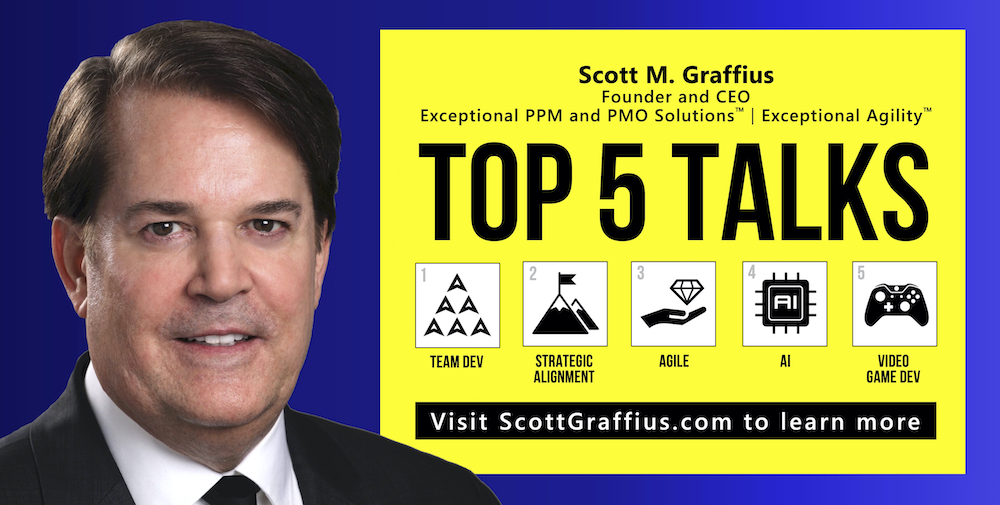
Scott M. Graffius is an Agile project management practitioner, consultant, thinker, creator, award-winning author, and international public speaker. Content from his books, talks, and more have been featured and used by Microsoft, Oracle, Cisco, Project Management Institute, IEEE, National Academy of Sciences, Yale University, Adobe, Torrens University Australia, UK Sports Institute, Amsterdam Public Health Research Institute, Boston University, Bayer, Hasso Plattner Institute, University of Galway Ireland, United States National Park Service, and others.
Conference organizers, businesses, professional associations, government agencies, and universities invite him to speak on topics at the intersection of Agile Project Management, Business, and Technology. To date, Graffius has presented talks and workshops at 89 conferences and other events across 25 countries. He uses everyday language and vibrant custom content to make complex topics clear and understandable, and he provides audiences with practical information they can use. His sessions are highly rated by attendees and organizers alike.
The top five talks and workshop topics are highlighted next.

High Performance Teams
High Performance Teams is first on the list. Scott customizes each session to the audience and other factors, so each one is unique. The following provides a general overview.
- Title: Talks or workshops on High Performance Teams may be called “Navigate the Phases of Team Development with Speed and Agility” or “Want Happier and More Productive Teams?” or another title.
- Description: Help your teams go farther, faster! Perhaps you’re heard about the phases of team development: Forming, Storming, Norming, Performing, and Adjourning. But are you aware of the unique behaviors specific to each phase? What exactly should you do during each phase to help the team (Agile or otherwise) tackle challenges, make progress, and become successful? If you are a leader (or aspire to be one), a member of a team (or may be in one in the future), or are just looking to develop your skills, this talk (with a fresh angle: 0% theory, 100% real-world-based) will give you a practical framework with actionable tips for working in and leading teams successfully. You'll learn about the five phases—Forming, Storming, Norming, Performing, and Adjourning—including detailed descriptions of each along with proven strategies for addressing challenges or issues which may occur along the way. You'll understand how to use the model to your advantage by effectively navigating all of the phases with speed and agility, from team set-up to the after-party! The presentation draws on the speaker’s first-hand, real-world experience, with his guidance supported by additional research, recommendations, and coverage from the Project Management Institute, IEEE, Google, NASA, and others.
- Key learning benefits: This talk will help you develop and enhance the contributions you make to your organization by being able to: (1) Understand the five stages of team development: Forming, Storming, Norming, Performing, and Adjourning. (2) Learn the characteristics of each phase. (3) Apply proven strategies to help handle challenges or issues experienced by the team. By doing so, you'll advance the team's happiness, productivity, and success.
- Information sheet: https://scottgraffius.com/resources/Scott-M-Graffius---Public-Speaker---Example-Session---Team-Development---v24012907.pdf.

Strategic Alignment
Strategic Alignment is second on the list of the top five topics. Scott customizes each session to the audience and other factors, so each one is unique. A general overview follows.
- Title: Talks or workshops on Strategic Alignment may be called “10 Ways to Score and Prioritize Project Proposals Based on Multiple Factors, Including Strategic Alignment” or “10 Ways to Achieve and Sustain Strategic Alignment” or another title.
- Description: How does your organization assess proposals for new projects? Is there a well-defined scoring and prioritization process—based on alignment with the business’ strategic objectives and other key factors—to quickly and easily identify the objective value of each proposal (including how important it is relative to other initiatives)? If the answer is “no,” keep reading. If the answer is “yes,” you are likely to find practical information and examples in this talk to adapt and adopt to improve the process at your organization.
- Key learning benefits: This talk will help you develop and enhance the contributions you make to your organization by being able to: (1) Understand the benefits of scoring and prioritizing project proposals based on strategic alignment and other key factors. (2) Identify selection and prioritization criteria appropriate for your unique organization, leveraging the flexible framework and some or all of the 10 factors presented during the talk. (3) Put the practical, actionable information presented to use. During the session, we will run an example project proposal through the process, step-by-step. And you will receive a summary "cheat sheet" digital download that you can reference as a guide to help implement or improve this process at your organization.
- Information sheet: https://scottgraffius.com/resources/Scott-M-Graffius---Public-Speaker---Example-Session---10-Ways-Strategic-Alignment---v24012907.pdf.

Agile
Agile is third on the list of the top five topics. Scott customizes each session to the audience and other factors, so each one is unique. A general overview follows.
- Title: Talks or workshops on Agile may be called “Are You Realizing All the Benefits from Agile?” or “Agile Scrum Helps Innovators, Disruptors, and Entrepreneurs Develop and Deliver Products at Astounding Speed Which Drives Competitive Advantage” or another title.
- Description: Organizations are increasingly embracing Agile to best meet their shifting business needs and successfully manage projects. Potential business benefits from Agile include faster delivery and ROI, rapid response to change, higher satisfaction, and continuous improvement. All of which supports innovation and helps drive competitive advantage. Are you realizing all of the benefits? This session will cover the full lifecycle of the most popular Agile approach, Scrum. You will be presented with practical information including top factors from successful implementations—based on the speaker's first-hand experience and 116 sources, including the PMI, IEEE, Google, Agile Alliance, and others—you can use to gain more benefits from Agile.
- Key learning benefits: How you will benefit: (1) Gain a high-level understanding of the Scrum framework-from vision through release. (2) Learn the roles, responsibilities, tools, and techniques unique to Scrum. (3) All of which are inclusive of top factors from successful implementations, which you can put to use to help you get more benefits from Agile.
- Information sheet: https://scottgraffius.com/resources/Scott-M-Graffius---Public-Speaker---Example-Session---Agile-Benefits---v24012907.pdf.

AI Development
Successful AI Development is fourth on the list of the top five topics. Scott customizes each session to the audience and other factors, so each one is unique. A general overview follows.
- Title: Talks or workshops on Successful AI Development may be called “What Successful AI Development Teams Have in Common” or “Fueling the Development of Innovative and Life-Changing AI Solutions” or another title.
- Description: Artificial Intelligence has emerged as a transformative force across a growing number of industries, revolutionizing how we live, work, and interact. From improved medical diagnoses to self-driving cars, and more, AI systems have become integral to our daily lives. Behind these cutting-edge, life-changing solutions are AI teams with a combination of skills. This session reveals exactly how the fusion of technical skills and soft skills within AI teams fuels the successful development of innovative and effective solutions. Informed by “In the AI era, soft skills are the new hard skills” (from Artificial Intelligence and Its Impact on Business), “Soft skills are becoming a key focus” (from Computerworld), “Don’t underestimate the power of a team dynamic – your product becomes the result of it” (from Microsoft), and “Competencies like teamwork are crucial” (from MIT), this talk also delivers a deep-dive on essential team development skills based on the science of high-performing teams. Scott’s talk draws from his work with AI development teams as well as research and coverage from the Association for the Advancement of Artificial Intelligence, Google, IBM, IEEE, Microsoft, Software Engineering Institute, and many others. The usable information can provide you, your teams, and your organization with a competitive advantage.
- Key learning benefits: How you will benefit: (1) Understand technical skills and soft skills leveraged by successful AI teams to develop innovative and effective solutions. (2) Understand the essential team development skills based on the science of high-performing teams. (3) Understand specific techniques including how to apply them to advance the happiness, productivity, and success of teams.
- Information sheet: https://scottgraffius.com/resources/Scott-M-Graffius---Public-Speaker---Example-Session---AI---v24012907.pdf.

Video Game Development
Successful Video Game Development is fifth on the list of the top five topics. Scott customizes each session to the audience and other factors, so each one is unique. A general overview follows.
- Title: Talks or workshops on Successful Video Game Development may be called “The Science of High-Performance Video Game Development Teams” or “Level-Up Your Team: Science-Backed Strategies for High-Performance Video Game Development” or another title.
- Description: Behind every great video game is a team of creative and technical wizards. Creators, storytellers, designers, artists, developers, testers, and others collaborate and leverage a diverse range of hard skills (also known as technical skills) and soft skills (also known as interpersonal skills) to craft an exceptional end-product. Of the many skills, one — a soft skill — is paramount. Activision Blizzard and other premiere developers and publishers of entertainment experiences identify teamwork as critical for the successful development of video games. Informed by Scott’s first-hand work with video game development teams as well as research and coverage from Activision Blizzard, Gameloft, International Game Developers Association, Microsoft, Rockstar Games, Sony Interactive Entertainment, Ubisoft, and others, this talk delivers a deep-dive on the essential teamwork skill based on the science of high- performing teams. The information can provide you, your teams, and your organization with a competitive advantage!
- Key learning benefits: How you will benefit: (1) Understand that a confluence of both hard skills and soft skills (notably, teamwork) are crucial. (2) Learn the five phases of team development and recognize the identifiable characteristics of each phase. (3) Learn how to apply strategies to improve teams' efficacy, happiness, and success.
- Information sheet: https://scottgraffius.com/resources/Scott-M-Graffius---Public-Speaker---Example-Session---Video-Game-Development---v24012907.pdf.
Those are the top five topics for talks and workshops.

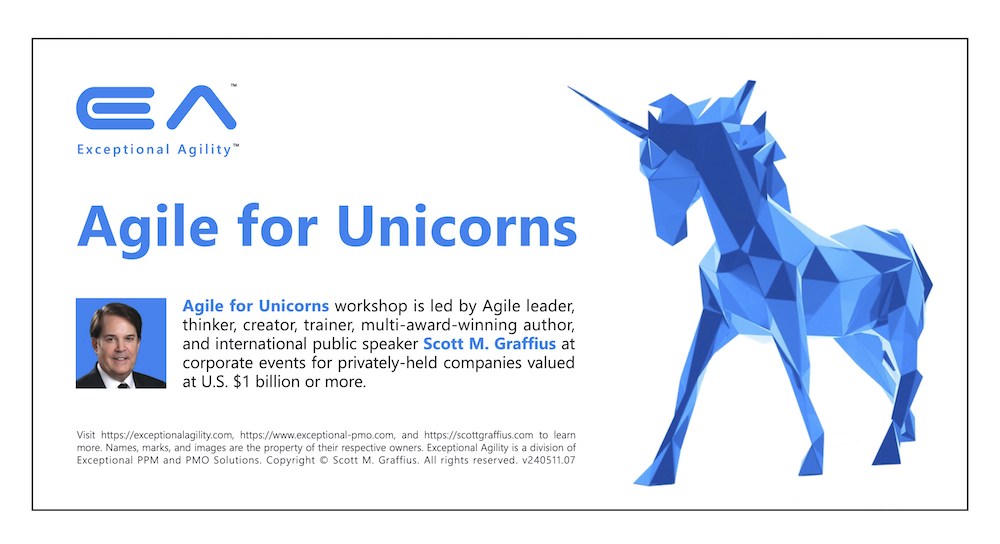
Before concluding this article, we’ll also point out a new topic which is becoming increasingly popular. It’s “Agile for Unicorns.” This session is limited to corporate events for privately-held companies valued at US $1 billion or more. To learn more, check out the information sheet: https://scottgraffius.com/resources/Scott-M-Graffius---Public-Speaker---Example-Session---Agile-for-Unicorns---v24012907.pdf.
Visit Scott’s Public Speaker page for a detailed listing of events, testimonials, and more.
Scott speaks around the world. To book him for your conference or other event, complete a speaker engagement request form or email him.




About Scott M. Graffius

Scott M. Graffius, PMP, SA, CSP-SM, CSP-PO, CSM, CSPO, SFE, ITIL, LSSGB is an agile project management practitioner, consultant, thinker, creator, multi-award-winning author, and international public speaker. Founder and CEO of Exceptional PPM and PMO Solutions™ and subsidiary Exceptional Agility™, he has generated over $1.9 billion for Global Fortune 500 businesses and other organizations he has served. Graffius and content from his books, talks, workshops, and more have been featured and used by Microsoft, Oracle, Broadcom, Cisco, Gartner, Project Management Institute, IEEE, National Academy of Sciences, United States Department of Energy, Yale University, Tufts University, and others. He delights audiences with dynamic and engaging talks and workshops on agile project management, AI, Tech leadership, video game development, strategic alignment, the science of high performance teams, and more. To date, he's presented sessions at 89 conferences and other events across 25 countries.
His full bio is available here.
Connect with Scott on:
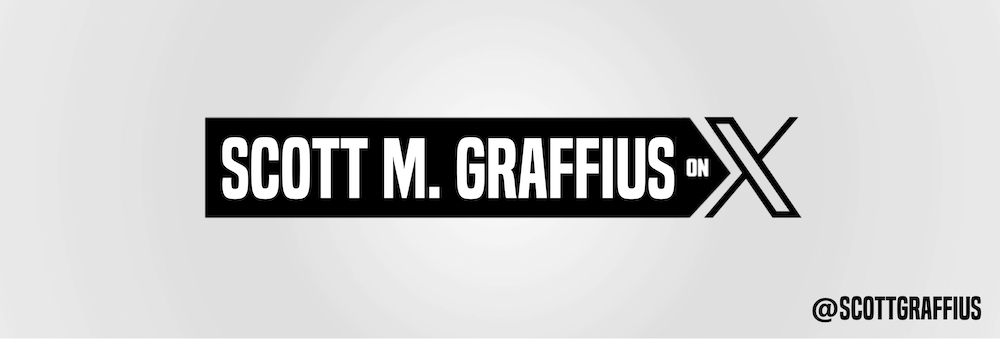


About Agile Scrum: Your Quick Start Guide with Step-by-Step Instructions

Shifting customer needs are common in today's marketplace. Businesses must be adaptive and responsive to change while delivering an exceptional customer experience to be competitive.
There are a variety of frameworks supporting the development of products and services, and most approaches fall into one of two broad categories: traditional or agile. Traditional practices such as waterfall engage sequential development, while agile involves iterative and incremental deliverables. Organizations are increasingly embracing agile to manage projects, and best meet their business needs of rapid response to change, fast delivery speed, and more.
With clear and easy to follow step-by-step instructions, Scott M. Graffius's award-winning Agile Scrum: Your Quick Start Guide with Step-by-Step Instructions helps the reader:
- Implement and use the most popular agile framework―Scrum;
- Deliver products in short cycles with rapid adaptation to change, fast time-to-market, and continuous improvement; and
- Support innovation and drive competitive advantage.
Hailed by Literary Titan as “the book highlights the versatility of Scrum beautifully.”
Winner of 17 first place awards.
Agile Scrum: Your Quick Start Guide with Step-by-Step Instructions is available in paperback and ebook/Kindle in the United States and around the world. Some links by country follow.
- 🇧🇷 Brazil
- 🇨🇦 Canada
- 🇨🇿 Czech Republic
- 🇩🇰 Denmark
- 🇫🇮 Finland
- 🇫🇷 France
- 🇩🇪 Germany
- 🇬🇷 Greece
- 🇭🇺 Hungary
- 🇮🇳 India
- 🇮🇪 Ireland
- 🇮🇱 Israel
- 🇮🇹 Italy
- 🇯🇵 Japan
- 🇱🇺 Luxembourg
- 🇲🇽 Mexico
- 🇳🇱 Netherlands
- 🇳🇿 New Zealand
- 🇳🇴 Norway
- 🇪🇸 Spain
- 🇸🇪 Sweden
- 🇨🇭 Switzerland
- 🇦🇪 UAE
- 🇬🇧 United Kingdom
- 🇺🇸 United States

About Agile Transformation: A Brief Story of How an Entertainment Company Developed New Capabilities and Unlocked Business Agility to Thrive in an Era of Rapid Change

Thriving in today's marketplace frequently depends on making a transformation to become more agile. Those successful in the transition enjoy faster delivery speed and ROI, higher satisfaction, continuous improvement, and additional benefits.
Based on actual events, Agile Transformation: A Brief Story of How an Entertainment Company Developed New Capabilities and Unlocked Business Agility to Thrive in an Era of Rapid Change provides a quick (60-90 minute) read about a successful agile transformation at a multinational entertainment and media company, told from the author's perspective as an agile coach.
The award-winning book by Scott M. Graffius is available in paperback and ebook/Kindle in the United States and around the world. Some links by country follow.
- 🇦🇺 Australia
- 🇦🇹 Austria
- 🇧🇷 Brazil
- 🇨🇦 Canada
- 🇨🇿 Czech Republic
- 🇩🇰 Denmark
- 🇫🇮 Finland
- 🇫🇷 France
- 🇩🇪 Germany
- 🇬🇷 Greece
- 🇮🇳 India
- 🇮🇪 Ireland
- 🇯🇵 Japan
- 🇱🇺 Luxembourg
- 🇲🇽 Mexico
- 🇳🇱 Netherlands
- 🇳🇿 New Zealand
- 🇪🇸 Spain
- 🇸🇪 Sweden
- 🇨🇭 Switzerland
- 🇦🇪 United Arab Emirates
- 🇬🇧 United Kingdom
- 🇺🇸 United States

© Copyright 2024 Scott M. Graffius. All rights reserved. This material may not be published, broadcast, rewritten or redistributed without the express written permission of Scott M. Graffius.

Scott M. Graffius Speaking on Successful AI at DevDays Europe 2024 Conference
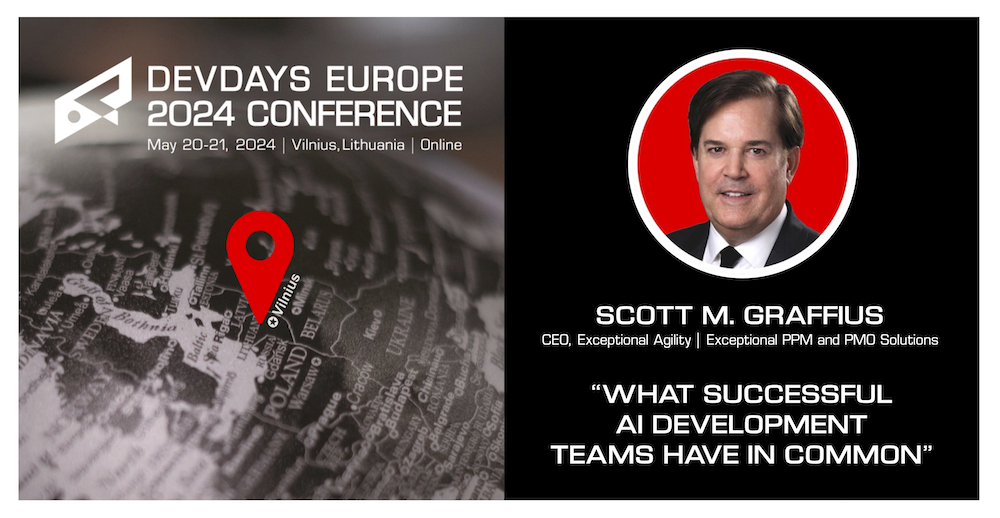
Agile leader, consultant, creator, multi-award-winning author, and international public speaker Scott M. Graffius delights audiences around the world with talks and workshops on AI, Innovation, Agile, Project Management, High Performance Teams, Video Game Development, Tech Leadership, Strategic Alignment, and more. He uses everyday language and vibrant custom visuals to make complex topics clear and understandable, and he provides audiences with practical information they can use. His sessions are highly rated by attendees and organizers alike.
Conference organizers, businesses, professional associations, government agencies, and universities around the world invite Scott to speak. He’s presented 89 talks and workshops at conferences and other events (public and private/corporate) across 25 countries.
Scott's newest engagement will be the DevDays Europe 2024 Conference, where he'll present “What Successful AI Development Teams Have in Common.” His talk draws from his work on AI projects as well as research from DARPA, Google, IBM, IEEE, Microsoft, Nvidia, Oracle, Software Engineering Institute, USAII, and other organizations.
💡 AI
ℹ️ https://bit.ly/dde2024
📍 Vilnius, Lithuania | Online
🗓 Tuesday, 21 May 2024
🕙 10:00 a.m. Eastern European Time
🎟 https://devdays.lt
About the DevDays Europe 2024 Conference
DevDays Europe brings together internationally recognized speakers and developers to encourage excellence and innovation in the software development community. The conference will cover emerging technologies and best practices in the software development industry — regardless of technological platform or language — without commercial hype. It will run from May 20-21, 23-24. Conference sessions will take place in the dynamic ambiance of movie theater halls at the Multikino Ozas (Multikino, Ozo str. 18, Vilnius, Lithuania). Visit https://devdays.lt to learn more.




About Scott M. Graffius

Scott M. Graffius, PMP, SA, CSP-SM, CSP-PO, CSM, CSPO, ITIL, LSSGB is an agile project management practitioner, consultant, thinker, creator, multi-award-winning author, and international public speaker. Founder and CEO of Exceptional PPM and PMO Solutions™ and subsidiary Exceptional Agility™, he has generated over $1.9 billion for Global Fortune 500 businesses and other organizations he has served. Graffius and content from his books, talks, workshops, and more have been featured and used by Microsoft, Oracle, Broadcom, Cisco, Gartner, Project Management Institute, IEEE, National Academy of Sciences, United States Department of Energy, Yale University, Tufts University, and others. He delights audiences with dynamic and engaging talks and workshops on agile project management, AI, Tech leadership, video game development, strategic alignment, the science of high performance teams, and more. To date, he's presented sessions at 89 conferences and other events across 25 countries.
His full bio is available here.
Connect with Scott on:



About Agile Scrum: Your Quick Start Guide with Step-by-Step Instructions

Shifting customer needs are common in today's marketplace. Businesses must be adaptive and responsive to change while delivering an exceptional customer experience to be competitive.
There are a variety of frameworks supporting the development of products and services, and most approaches fall into one of two broad categories: traditional or agile. Traditional practices such as waterfall engage sequential development, while agile involves iterative and incremental deliverables. Organizations are increasingly embracing agile to manage projects, and best meet their business needs of rapid response to change, fast delivery speed, and more.
With clear and easy to follow step-by-step instructions, Scott M. Graffius's award-winning Agile Scrum: Your Quick Start Guide with Step-by-Step Instructions helps the reader:
- Implement and use the most popular agile framework―Scrum;
- Deliver products in short cycles with rapid adaptation to change, fast time-to-market, and continuous improvement; and
- Support innovation and drive competitive advantage.
Hailed by Literary Titan as “the book highlights the versatility of Scrum beautifully.”
Winner of 17 first place awards.
Agile Scrum: Your Quick Start Guide with Step-by-Step Instructions is available in paperback and ebook/Kindle in the United States and around the world. Some links by country follow.
- 🇧🇷 Brazil
- 🇨🇦 Canada
- 🇨🇿 Czech Republic
- 🇩🇰 Denmark
- 🇫🇮 Finland
- 🇫🇷 France
- 🇩🇪 Germany
- 🇬🇷 Greece
- 🇭🇺 Hungary
- 🇮🇳 India
- 🇮🇪 Ireland
- 🇮🇱 Israel
- 🇮🇹 Italy
- 🇯🇵 Japan
- 🇱🇺 Luxembourg
- 🇲🇽 Mexico
- 🇳🇱 Netherlands
- 🇳🇿 New Zealand
- 🇳🇴 Norway
- 🇪🇸 Spain
- 🇸🇪 Sweden
- 🇨🇭 Switzerland
- 🇦🇪 UAE
- 🇬🇧 United Kingdom
- 🇺🇸 United States

About Agile Transformation: A Brief Story of How an Entertainment Company Developed New Capabilities and Unlocked Business Agility to Thrive in an Era of Rapid Change

Thriving in today's marketplace frequently depends on making a transformation to become more agile. Those successful in the transition enjoy faster delivery speed and ROI, higher satisfaction, continuous improvement, and additional benefits.
Based on actual events, Agile Transformation: A Brief Story of How an Entertainment Company Developed New Capabilities and Unlocked Business Agility to Thrive in an Era of Rapid Change provides a quick (60-90 minute) read about a successful agile transformation at a multinational entertainment and media company, told from the author's perspective as an agile coach.
The award-winning book by Scott M. Graffius is available in paperback and ebook/Kindle in the United States and around the world. Some links by country follow.
- 🇦🇺 Australia
- 🇦🇹 Austria
- 🇧🇷 Brazil
- 🇨🇦 Canada
- 🇨🇿 Czech Republic
- 🇩🇰 Denmark
- 🇫🇮 Finland
- 🇫🇷 France
- 🇩🇪 Germany
- 🇬🇷 Greece
- 🇮🇳 India
- 🇮🇪 Ireland
- 🇯🇵 Japan
- 🇱🇺 Luxembourg
- 🇲🇽 Mexico
- 🇳🇱 Netherlands
- 🇳🇿 New Zealand
- 🇪🇸 Spain
- 🇸🇪 Sweden
- 🇨🇭 Switzerland
- 🇦🇪 United Arab Emirates
- 🇬🇧 United Kingdom
- 🇺🇸 United States

Short link for this article: https://bit.ly/dev-ai
DOI: 10.13140/RG.2.2.24313.07529
© Copyright 2024 Scott M. Graffius. All rights reserved. This material may not be published, broadcast, rewritten or redistributed without the express written permission of Scott M. Graffius.

Most Valuable IT Certifications: Update for 2024



In Technology, there's no substitute for experience. However, certifications remain a valuable tool for advancing one's career.
In 2017, Scott M. Graffius started developing and reporting information on the most valuable Information Technology (IT) certifications. As technology advances and marketplace needs evolve over time, the skills and knowledge required to succeed can also change. For that reason, Graffius periodically updates his respective work. This article provides the 2024 update for the most valuable IT certifications.


Certifications can help position people as a valuable asset to their current — and prospective future — employers.
Employers want employees and candidates with up-to-date knowledge and skills, and certifications demonstrate a person’s mastery of the respective subject. Additionally, certifications can advance a person’s marketability and lead to promotions and higher pay.
Graffius compiled and analyzed data from 12 sources — Exceptional Agility, California Institute of Arts and Technology, CIO, CIO Dive, ComputerScience(dot)org, eWeek, Fortune, Global Knowledge, Indeed, PC Magazine, Robert Half, and Skillsoft — to determine the general consensus on the most valuable IT related certifications. Eleven certifications emerged.
Now, on to this list!


1. CompTIA A+
- Certification name: CompTIA A+
- Certification name abbreviation: A+
- Governing organization - name: CompTIA
- Governing organization - website: https://www.comptia.org
- Short description of certification: This is generally considered to be a certification for people who want to start careers in the IT industry. To acquire the CompTIA A+ certification, you must pass two separate tests: Core 1 and Core 2. Core 1 (220-1101) covers mobile devices, networking technology, hardware, virtualization, and cloud computing. Core 2 (220-1102) covers operating systems, security, software, and operational procedures.
- Prerequisites (if any) for certification: None
- Certification exam – cost: Total cost for the two exams varies by location and other factors. The average total combined cost is $492
- Certification exam – delivery (in-person or online): in-person or online
- Certification exam – number of questions: Core 1 exam has 90 questions, Core 2 exam also has 90 questions
- Certification exam – time to complete it: 90 minutes for Core 1 exam, and 90 minutes for Core 2 exam
- Certification exam – minimum pass rate (X% or higher correct required to pass exam): Estimated to be 83% for the Core 1 exam. Estimated to be 86% for the Core 2 exam.
- Certification expiration – does it expire? Yes
- Certification expiration – how long does it last before expiring? 3 years
- Certification renewal cost: $75
Note: Prerequisites, cost (shown in United States Dollar - USD), and other data are subject to change by the governing organization.


2. Cisco Certified Network Associate
- Certification name: Cisco Certified Network Associate
- Certification name abbreviation: CCNA
- Governing organization - name: Cisco
- Governing organization - website: https://www.cisco.com
- Short description of certification: Validates the ability to install, operate, configure, and troubleshoot basic Cisco networking devices and technologies.
- Prerequisites (if any) for certification: No prerequisites. However, Cisco recommends having at least a basic knowledge of networking and at least one year of experience with Cisco products.
- Certification exam – cost: $300
- Certification exam – delivery (in-person or online): In-person or online
- Certification exam – number of questions: Varies, between 50-75 questions
- Certification exam – time to complete it: 120 minutes
- Certification exam – minimum pass rate (X% or higher correct required to pass exam): Estimated to be 80%
- Certification expiration – does it expire? Yes
- Certification expiration – how long does it last before expiring? 3 years
- Certification renewal cost: $150
Note: Prerequisites, cost (shown in United States Dollar - USD), and other data are subject to change by the governing organization.

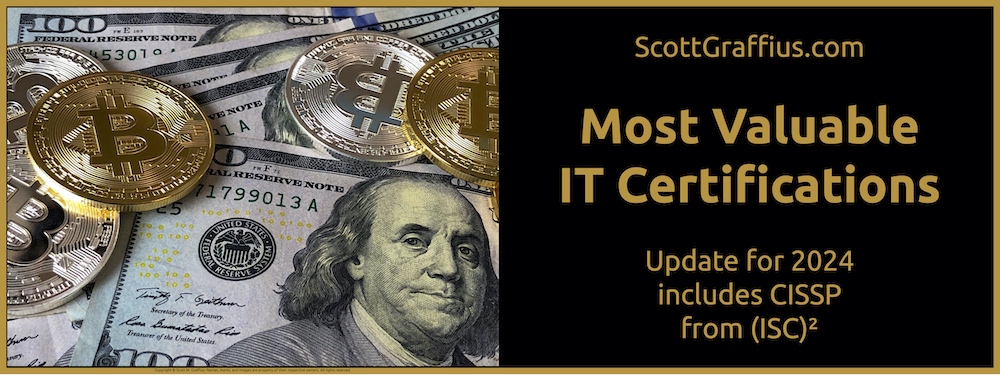
3. Certified Information Systems Security Professional
- Certification name: Certified Information Systems Security Professional
- Certification name abbreviation: CISSP
- Governing organization - name: (ISC)²
- Governing organization - website: https://www.isc2.org
- Short description of certification: The CISSP is a highly respective, vendor-neutral certification that validates a broad understanding of information security and best practices.
- Prerequisites (if any) for certification: At least five years of paid, full time work experience involving two or more (of the eight) domains of the CISSP Common Body of Knowledge (CBK)
- Certification exam - cost: $749, although the cost may vary by location and other factors
- Certification exam - delivery (in-person or online): In-person at a Pearson VUE testing center
- Certification exam - number of questions: Between 125-175 questions
- Certification exam - time to complete it: 4 hours
- Certification exam - minimum pass rate (X% or higher correct required to pass exam): Estimated to be 70%
- Certification expiration - does it expire? Yes
- Certification expiration - how long does it last before expiring? 3 years
- Certification renewal cost: $125
Note: Prerequisites, cost (shown in United States Dollar - USD), and other data are subject to change by the governing organization.

4. Project Management Professional
- Certification name: Project Management Professional
- Certification name abbreviation: PMP
- Governing organization - name: Project Management Institute (PMI)
- Governing organization - website: https://www.pmi.org/
- Short description of certification: PMP certification is a globally recognized and sought-after project management credential that recognizes experienced project managers for successfully leading teams through a project’s life cycle.
- Prerequisites (if any) for certification: A or B. (A) Bachelor's degree (or global equivalent) + 36 months of project management experience + 35 hours of project management education/training. Or (B) Secondary degree (high school diploma, associate’s degree or global equivalent) + 60 months of project management experience + 35 hours of project management education/training.
- Certification exam - cost: $405 for members of the PMI, $575 for those not a member of the PMI
- Certification exam - delivery (in-person or online): In-person
- Certification exam - number of questions: Between 180-200 questions
- Certification exam - time to complete it: 230 minutes
- Certification exam - minimum pass rate (X% or higher correct required to pass exam): Estimated to be 81%
- Certification expiration - does it expire? Yes
- Certification expiration - how long does it last before expiring? 3 years
- Certification renewal cost: $150
Note: Prerequisites, cost (shown in United States Dollar - USD), and other data are subject to change by the governing organization.


5. Certified Ethical Hacker
- Certification name: Certified Ethical Hacker
- Certification name abbreviation: CEH
- Governing organization - name: EC-Council
- Governing organization - website: https://www.eccouncil.org
- Short description of certification: This certification is obtained by demonstrating knowledge of assessing the security of computer systems by looking for vulnerabilities in target systems, using the same knowledge and tools as a malicious hacker, but in a lawful and legitimate manner to assess the security posture of a target system.
- Prerequisites (if any) for certification: Candidates need to have experience in a job related to network security or complete approved training courses before taking the exam
- Certification exam - cost: $1,199, can vary based on registration options and other factors
- Certification exam - delivery (in-person or online): In-person at a Pearson VUE testing center or online proctored
- Certification exam - number of questions: 125
- Certification exam - time to complete it: 4 hours
- Certification exam - minimum pass rate (X% or higher correct required to pass exam): Estimated to be 70%
- Certification expiration - does it expire? Yes
- Certification expiration - how long does it last before expiring? 3 years
- Certification renewal cost: $85
Note: Prerequisites, cost (shown in United States Dollar - USD), and other data are subject to change by the governing organization.


6. AWS Certified Solutions Architect - Associate
- Certification name: AWS Certified Solutions Architect - Associate
- Certification name abbreviation: AWS SA
- Governing organization - name: Amazon Web Services (AWS)
- Governing organization - website: http://aws.amazon.com
- Short description of certification: This certification showcases knowledge and skills in AWS technology, across a wide range of AWS services. The focus is on the design of cost- and performance-optimized solutions, demonstrating a strong understanding of the AWS Well-Architected Framework.
- Prerequisites (if any) for certification: None
- Certification exam - cost: $150
- Certification exam - delivery (in-person or online): In-person or online
- Certification exam - number of questions: 65 questions
- Certification exam - time to complete it: 130 minutes
- Certification exam - minimum pass rate (X% or higher correct required to pass exam): Estimated to be 70%
- Certification expiration - does it expire? Yes
- Certification expiration - how long does it last before expiring? 3 years
- Certification renewal cost: $75
Note: Prerequisites, cost (shown in United States Dollar - USD), and other data are subject to change by the governing organization.

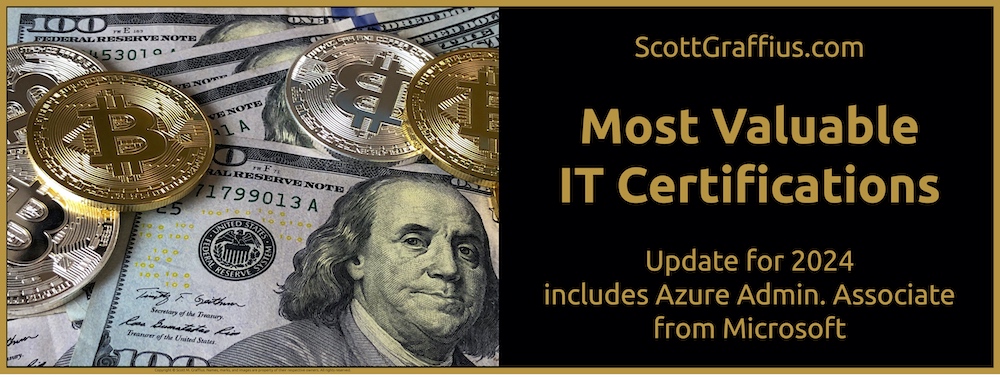
7. Azure Administrator Associate
- Certification name: Azure Administrator Associate
- Certification name abbreviation: There isn't an abbreviation designated. AZ-104 (the corresponding exam code for the certification) is sometimes used as an identifier.
- Governing organization - name: Microsoft
- Governing organization - website: https://learn.microsoft.com
- Short description of certification: Azure Administrator Associate (also referred to as Microsoft Certified: Azure Administrator Associate) certification validates one’s ability to manage Azure subscriptions, implement and secure infrastructure, configure virtual networks, deploy virtual machines, monitor resources, and troubleshoot issues.
- Prerequisites (if any) for certification: None, but Microsoft recommends at least six months of experience administering Azure
- Certification exam - cost: $165
- Certification exam - delivery (in-person or online): In-person or online proctored
- Certification exam - number of questions: Varies, typically between 40-60 questions
- Certification exam - time to complete it: 120 minutes
- Certification exam - minimum pass rate (X% or higher correct required to pass exam): Estimated to be 70%
- Certification expiration - does it expire? Yes
- Certification expiration - how long does it last before expiring? 1 year
- Certification renewal cost: Free renewal
Note: Prerequisites, cost (shown in United States Dollar - USD), and other data are subject to change by the governing organization.


8. ITIL Foundation
- Certification name: ITIL Foundation
- Certification name abbreviation: ITIL
- Governing organization - name: Axelos
- Governing organization - website: https://www.axelos.com
- Short description of certification: Provides a foundation in IT service management (ITSM) best practices. Covers key concepts, service lifecycle, and the benefits of effective ITSM.
- Prerequisites (if any) for certification: None
- Certification exam - cost: $330
- Certification exam - delivery (in-person or online): In-person or online
- Certification exam - number of questions: 40 questions
- Certification exam - time to complete it: 60 minutes
- Certification exam - minimum pass rate (X% or higher correct required to pass exam): Some sources indicate it is 65%, others estimate it to be 70%
- Certification expiration - does it expire? No
- Certification expiration - how long does it last before expiring? Not applicable; certification does not expire
- Certification renewal cost: Not applicable; certification does not expire
Note: Prerequisites, cost (shown in United States Dollar - USD), and other data are subject to change by the governing organization.


9. Google Certified Professional Cloud Architect
- Certification name: Google Certified Professional Cloud Architect
- Certification name abbreviation: GCP Architect
- Governing organization - name: Google
- Governing organization - website: https://cloud.google.com
- Short description of certification: Demonstrates expertise in designing, developing, and managing secure, reliable, scalable, and cost-effective solutions on the Google Cloud Platforms (GCP)
- Prerequisites (if any) for certification: None; familiarity with GCP products and services is recommended
- Certification exam - cost: $200
- Certification exam - delivery (in-person or online): In-person
- Certification exam - number of questions: 50 questions
- Certification exam - time to complete it: 120 minutes
- Certification exam - minimum pass rate (X% or higher correct required to pass exam): Estimated to be 70%
- Certification expiration - does it expire? Yes
- Certification expiration - how long does it last before expiring? 2 years
- Certification renewal cost: $100
Note: Prerequisites, cost (shown in United States Dollar - USD), and other data are subject to change by the governing organization.

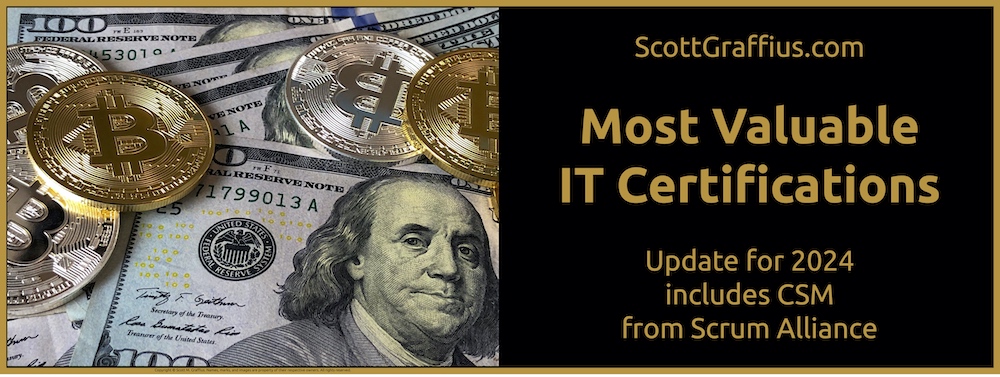
10. Certified ScrumMaster
- Certification name: Certified ScrumMaster
- Certification name abbreviation: CSM
- Governing organization - name: Scrum Alliance
- Governing organization - website: https://www.scrumalliance.org
- Short description of certification: Validates a solid understanding of Scrum including practical ways to apply it on one’s team and organization
- Prerequisites (if any) for certification: Completion of a two-day course by an authorized trainer
- Certification exam - cost: Course (referenced above) includes the cost of the exam. Cost ranges from about $500 to $1,500 depending on the location, delivery format, and other factors
- Certification exam - delivery (in-person or online): Online
- Certification exam - number of questions: 50
- Certification exam - time to complete it: 1 hour
- Certification exam - minimum pass rate (X% or higher correct required to pass exam): Estimated to be 74%
- Certification expiration - does it expire? Yes
- Certification expiration - how long does it last before expiring? 2 years
- Certification renewal cost: $100
Note: Prerequisites, cost (shown in United States Dollar - USD), and other data are subject to change by the governing organization.

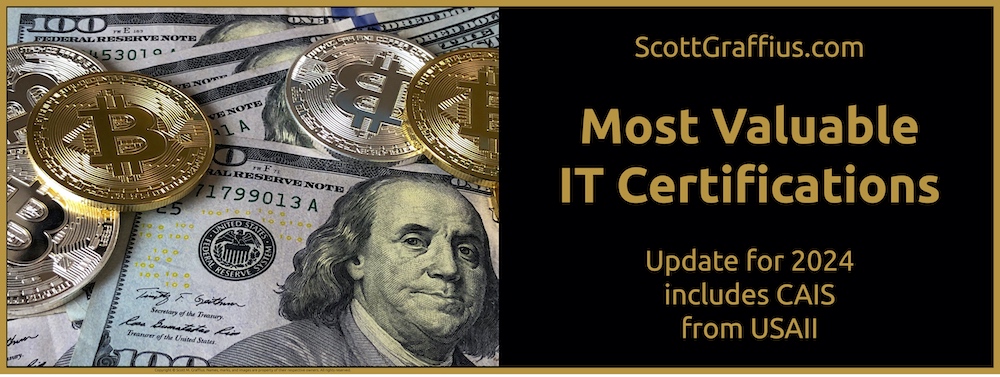
11. Certified Artificial Intelligence Scientist
- Certification name: Certified Artificial Intelligence Scientist
- Certification name abbreviation: CAIS
- Governing organization - name: United States Artificial Intelligence Institute (USAII)
- Governing organization - website: https://www.usaii.org
- Short description of certification: The CAIS is publicized by USAII as the most sophisticated and ground-breaking certification program for senior AI professionals and business leaders to develop the perfect AI solutions and strategy, bringing the right organizational change leading to an absolute business transformation.
- Prerequisites (if any) for certification: One of three eligibility paths and completion of a self-paced course. Path 1: Bachelor's degree (or equivalent) in any academic discipline; and at least five years of experience in Artificial Intelligence, Machine Learning, Data Science, Business Analytics, Business Intelligence, Project Management, or any Programming Languages. Path 2: Bachelor's degree (or equivalent) in any academic discipline; and at least four years of experience in Artificial Intelligence, Machine Learning, Data Science, Business Analytics, Business Intelligence, Engineering, Finance, or Management. Path 3: Certified Artificial Intelligence Consultant (CAIC) (or other equivalent) certification; and at least four years of experience for a candidate who has a Bachelor's degree (or equivalent), or three years of experience for a candidate who has a Master's degree (or equivalent).
- Certification exam - cost: Course (referenced above) includes the cost of the exam. Cost is $894.
- Certification exam - delivery (in-person or online): In-person
- Certification exam - number of questions: 80
- Certification exam - time to complete it: 100 minutes
- Certification exam - minimum pass rate (X% or higher correct required to pass exam): 70%
- Certification expiration - does it expire? Yes
- Certification expiration - how long does it last before expiring? 3 years
- Certification renewal cost: $249
Note: Prerequisites, cost (shown in United States Dollar - USD), and other data are subject to change by the governing organization.


Certifications can provide significant value for professionals looking to enhance their skills and credibility in the marketplace. Employers often prefer to hire certified professionals, and people who invest in professional credentials typically enjoy larger salaries.
Informed by data from multiple sources, this article identified and profiled 11 IT related certifications: CompTIA A+, Cisco Certified Network Associate (CCNA), Certified Information Systems Security Professional (CISSP), Project Management Professional (PMP), Certified Ethical Hacker (CEH), AWS Certified Solutions Architect - Associate (AWS SA), Azure Administrator Associate, ITIL Foundations (ITIL), Google Certified Professional Cloud Architect (GCP Architect), Certified ScrumMaster (CSM), and Certified Artificial Intelligence Scientist (CAIS).
Those interested in securing one or more IT related certifications can leverage the information presented in this article to assist in their decision-making.


References/Sources:
- Exceptional Agility (2024, January 4). Top Agile Certifications: Update for 2024. Available at: https://exceptionalagility.com/blog/files/top-agile-certifications-2024.html.
- California Institute of Arts and Technology (CIAT) (2024, February). 10 In-Demand IT Jobs You Can Get With Tech Certifications. Available at: https://www.ciat.edu/blog/10-in-demand-it-jobs-you-can-get-with-tech-certifications.
- CIO (2024, November 24). The 15 Most Valuable IT Certifications Today. Available at: https://www.cio.com/article/286762/careers-staffing-12-it-certifications-that-deliver-career-advancement.html.
- CIO Dive (2023, November 14). 5 Highest-Paying IT Certifications in 2023. Available at: https://www.ciodive.com/news/top-paying-IT-certifications-project-management-security/699641.
- Computer Science(dot)org. (2023, November 9). Best IT Certifications To Boost Your Computer Science Career. Available at: https://www.computerscience.org/resources/top-it-certifications.
- eWeek (2024, February 8). 30 Top AI Certifications: Hotlist of 2024. Available at: https://www.eweek.com/artificial-intelligence/ai-certifications.
- Fortune (2023, November 14). How Much Can You Make with IT Certifications? Available at: https://fortune.com/education/articles/how-much-can-you-make-with-it-certifications-average-salaries.
- Global Knowledge (2023, April 27). 10 Top-Paying IT Certifications. Available at: https://www.globalknowledge.com/us-en/resources/resource-library/articles/10-top-paying-it-certifications.
- Indeed (2023, December 18). Top 17 IT Certifications in Demand for 2024. Available at: https://www.indeed.com/career-advice/career-development/top-it-certifications.
- PC Magazine (2023, December 1). Level Up Your Career: The Highest-Paying IT Certifications for 2024. Available at: https://www.pcmag.com/news/highest-paying-it-certifications.
- Robert Half (2023, November 27). The 29 Most Valuable IT Certifications. Available at: https://www.roberthalf.com/us/en/insights/career-development/which-it-certifications-are-most-valuable.
- Skillsoft (2024, January 16). The 20 Top-Paying Microsoft Certifications in 2024. Available at: https://www.skillsoft.com/blog/top-paying-microsoft-certifications.


How to Cite This Article
Graffius, Scott M. (2024, March 15). Most Valuable IT Certifications: Update for 2024. Available at: https://scottgraffius.com/blog/files/it-certs-2024.html. DOI: 10.13140/RG.2.2.11776.03849.




About Scott M. Graffius

Scott M. Graffius, PMP, SA, CSP-SM, CSP-PO, CSM, CSPO, ITIL, LSSGB is an agile project management practitioner, consultant, thinker, creator, multi-award-winning author, and international public speaker. Founder and CEO of Exceptional PPM and PMO Solutions™ and subsidiary Exceptional Agility™, he has generated over $1.9 billion for Global Fortune 500 businesses and other organizations he has served. Graffius and content from his books, talks, workshops, and more have been featured and used by Microsoft, Oracle, Broadcom, Cisco, Gartner, Project Management Institute, IEEE, National Academy of Sciences, United States Department of Energy, Yale University, Tufts University, and others. He delights audiences with dynamic and engaging talks and workshops on agile project management, AI, Tech leadership, video game development, strategic alignment, the science of high performance teams, and more. To date, he's presented sessions at 89 conferences and other events across 25 countries.
His full bio is available here.
Connect with Scott on:



About Agile Scrum: Your Quick Start Guide with Step-by-Step Instructions

Shifting customer needs are common in today's marketplace. Businesses must be adaptive and responsive to change while delivering an exceptional customer experience to be competitive.
There are a variety of frameworks supporting the development of products and services, and most approaches fall into one of two broad categories: traditional or agile. Traditional practices such as waterfall engage sequential development, while agile involves iterative and incremental deliverables. Organizations are increasingly embracing agile to manage projects, and best meet their business needs of rapid response to change, fast delivery speed, and more.
With clear and easy to follow step-by-step instructions, Scott M. Graffius's award-winning Agile Scrum: Your Quick Start Guide with Step-by-Step Instructions helps the reader:
- Implement and use the most popular agile framework―Scrum;
- Deliver products in short cycles with rapid adaptation to change, fast time-to-market, and continuous improvement; and
- Support innovation and drive competitive advantage.
Hailed by Literary Titan as “the book highlights the versatility of Scrum beautifully.”
Winner of 17 first place awards.
Agile Scrum: Your Quick Start Guide with Step-by-Step Instructions is available in paperback and ebook/Kindle in the United States and around the world. Some links by country follow.
- 🇧🇷 Brazil
- 🇨🇦 Canada
- 🇨🇿 Czech Republic
- 🇩🇰 Denmark
- 🇫🇮 Finland
- 🇫🇷 France
- 🇩🇪 Germany
- 🇬🇷 Greece
- 🇭🇺 Hungary
- 🇮🇳 India
- 🇮🇪 Ireland
- 🇮🇱 Israel
- 🇮🇹 Italy
- 🇯🇵 Japan
- 🇱🇺 Luxembourg
- 🇲🇽 Mexico
- 🇳🇱 Netherlands
- 🇳🇿 New Zealand
- 🇳🇴 Norway
- 🇪🇸 Spain
- 🇸🇪 Sweden
- 🇨🇭 Switzerland
- 🇦🇪 UAE
- 🇬🇧 United Kingdom
- 🇺🇸 United States

About Agile Transformation: A Brief Story of How an Entertainment Company Developed New Capabilities and Unlocked Business Agility to Thrive in an Era of Rapid Change

Thriving in today's marketplace frequently depends on making a transformation to become more agile. Those successful in the transition enjoy faster delivery speed and ROI, higher satisfaction, continuous improvement, and additional benefits.
Based on actual events, Agile Transformation: A Brief Story of How an Entertainment Company Developed New Capabilities and Unlocked Business Agility to Thrive in an Era of Rapid Change provides a quick (60-90 minute) read about a successful agile transformation at a multinational entertainment and media company, told from the author's perspective as an agile coach.
The award-winning book by Scott M. Graffius is available in paperback and ebook/Kindle in the United States and around the world. Some links by country follow.
- 🇦🇺 Australia
- 🇦🇹 Austria
- 🇧🇷 Brazil
- 🇨🇦 Canada
- 🇨🇿 Czech Republic
- 🇩🇰 Denmark
- 🇫🇮 Finland
- 🇫🇷 France
- 🇩🇪 Germany
- 🇬🇷 Greece
- 🇮🇳 India
- 🇮🇪 Ireland
- 🇯🇵 Japan
- 🇱🇺 Luxembourg
- 🇲🇽 Mexico
- 🇳🇱 Netherlands
- 🇳🇿 New Zealand
- 🇪🇸 Spain
- 🇸🇪 Sweden
- 🇨🇭 Switzerland
- 🇦🇪 United Arab Emirates
- 🇬🇧 United Kingdom
- 🇺🇸 United States

The short link for this article is: https://bit.ly/it-certs
© Copyright 2024 Scott M. Graffius. All rights reserved. This material may not be published, broadcast, rewritten or redistributed without the express written permission of Scott M. Graffius.

FINAT (Fédération Internationale des Fabricants et Transformateurs d'Adhésifs et Thermocollants sur Papiers et Autres Supports) Features Scott M. Graffius’ Intellectual Property


Scott M. Graffius' Intellectual Property on Teamwork Tradecraft
Informed by the research of Bruce W. Tuckman and Mary Ann C. Jensen, over 100 subsequent studies, and Scott M. Graffius' first-hand professional experience with, and analysis of, team leadership and performance, Graffius created his ‘Phases of Team Development’ as a unique perspective and visual conveying the five phases of team development — Forming, Storming, Norming, Performing, and Adjourning — inclusive of a graph showing how performance varies by phase, as well as the characteristics and strategies for each phase.
Graffius' intellectual property (IP) is registered with the United States Copyright Office.
Graffius initially developed his ‘Phases of Team Development’ unique material in 2008, and he periodically refreshes it.
For reference, the visual for the current (2024) edition is below and the details are here.

Organizations around the world engage Graffius to deliver compelling talks and workshops. To date, he's presented sessions at 91 conferences and other events across 25 countries: Armenia, Australia, Brazil, Canada, Czech Republic, Finland, France, Germany, Greece, Hong Kong, Hungary, India, Ireland, Lithuania, Luxembourg, Nepal, Netherlands, New Zealand, Norway, Romania, Sweden, Switzerland, United Arab Emirates, United Kingdom, and the United States.

Graffius ‘Phases of Team Development’ IP is central and key to many of those sessions. His rate card and a listing of his engagements are at https://scottgraffius.com/resources/Exceptional-PPM-and-PMO-Solutions-Rate-Card-for-2024-2025-v24071607.pdf and https://scottgraffius.com/publicspeaker.html, respectively.

Graffius' 'Phases of Team Development' Intellectual Property Is Used By Organizations Around The World — And FINAT Was Added To The List
With an authorization/license from Graffius, his ‘Phases of Team Development’ IP is featured and used by businesses, professional associations, government agencies, and universities around the globe. Examples include:
- Adobe,
- American Management Association,
- Amsterdam Public Health Research Institute,
- Bayer,
- Boston University,
- Broadcom,
- Cisco,
- Deimos Aerospace,
- DevOps Institute,
- Erste Group Bank AG (Austria),
- Ford Motor Company,
- FSU College of Medicine,
- Hasso Plattner Institute,
- IEEE,
- James Madison University,
- Johns Hopkins University,
- LeadingEng,
- London South Bank University,
- Manufacturers Alliance,
- Microsoft,
- New Zealand Government,
- Oracle,
- Royal Australasian College of Physicians,
- TBS Switzerland,
- Torrens University Australia,
- Tufts University,
- U.S. National Park Service,
- U.S. Tennis Association,
- UC San Diego,
- UK Sports Institute,
- University of Galway Ireland,
- Victorian Institute of Technology (Australia),
- Virginia Tech,
- Warsaw University,
- Western Sydney University,
- World Resources Institute,
- Yale University,
- ZHAW Zurich University of Applied Sciences,
- and many others.
FINAT — the international association for the label industry’s development, education, and innovation — was added to the list.
The following visual shows a post from FINAT on LinkedIn with text about and pictures (including one featuring Graffius’ IP) from the FINAT Committee Summit in May 2024 in Amsterdam.

The following visual includes a picture from FINAT on LinkedIn. It shows Graffius’ 'Phases of Team Development' IP displayed on-screen in a talk at the FINAT Committee Summit in May 2024 in Amsterdam.

To learn more about FINAT, read on.
To learn more about Graffius' 'Phases of Team Development' intellectual property, visit here.

This article uses limited excerpts from FINAT (a post shared by FINAT on LinkedIn, and a picture from the same post featuring Graffius’ IP), attributed to FINAT and used under fair use for news reporting and analysis. FINAT name, mark, and content are the property of FINAT. Graffius’ ‘Phases of Team Development’ is copyright © Scott M. Graffius. All rights reserved.

About FINAT
FINAT is the international association for the label industry’s development, education, and innovation.
FINAT is an abbreviation for Fédération Internationale des Fabricants et Transformateurs d'Adhésifs et Thermocollants sur Papiers et Autres Supports. In English: International Federation of Manufacturers and Processors of Adhesives and Heat-Sealable Materials on Paper and Other Supports.
FINAT’s mission involves empowering the label industry by being the uniting platform that helps the international label industry excel in their daily business. FINAT's scope is to:
- Provide a global communication and networking platform for converters and direct and indirect suppliers.
- Represent members' interests.
- Provide a central source for industry information.
- Produce and distribute related educational and technical publications.
- Represent the industry's views at the EU level.
- Establish and maintain industry-related best practices, standards, and test methods.
To learn more, visit https://www.finat.com.

About Scott M. Graffius

Scott M. Graffius is a global leader in agile project management, an expert on teamwork tradecraft, an authority on temporal dynamics on social media platforms, a creator, a consultant, a trainer, an award-winning author, and an international public speaker.
He's generated over $1.9 billion of business value in aggregate for Global Fortune 500 businesses and other organizations he's served. Businesses and industries range from consumer products to advanced technology (including AI, R&D), e-commerce, music, streaming/OTT video, television, film, video games, financial services, government, and more.
Graffius and content from his books (Agile Scrum and Agile Transformation), talks, workshops, and more have been featured and used by businesses, professional associations, governments, and universities around the world. Examples include Adobe, American Management Association, Amsterdam Public Health Research Institute, Bayer, Boston University, Broadcom, Cisco, Deimos Aerospace, DevOps Institute, EU's European Commission, Ford Motor Company, Hasso Plattner Institute Germany, IEEE, Johns Hopkins University, London South Bank University, Microsoft, National Academy of Sciences, New Zealand Government, Oracle, Project Management Institute, Torrens University Australia, UC San Diego, TBS Switzerland, UK Sports Institute, University of Galway Ireland, U.S. Department of Energy, U.S. National Park Service, U.S. Tennis Association, Virginia Tech, Warsaw University of Technology, Yale University, Zurich University of Applied Sciences, and many others.
He delights audiences around the world with dynamic and engaging talks and workshops. He's presented sessions at 91 conferences and other events across 25 countries. Visit here to learn more and here to ask Scott to speak at your event.



About Agile Scrum: Your Quick Start Guide with Step-by-Step Instructions

Shifting customer needs are common in today's marketplace. Businesses must be adaptive and responsive to change while delivering an exceptional customer experience to be competitive.
There are a variety of frameworks supporting the development of products and services, and most approaches fall into one of two broad categories: traditional or agile. Traditional practices such as waterfall engage sequential development, while agile involves iterative and incremental deliverables. Organizations are increasingly embracing agile to manage projects, and best meet their business needs of rapid response to change, fast delivery speed, and more.
With clear and easy to follow step-by-step instructions, Scott M. Graffius's award-winning Agile Scrum: Your Quick Start Guide with Step-by-Step Instructions helps the reader:
- Implement and use the most popular agile framework―Scrum;
- Deliver products in short cycles with rapid adaptation to change, fast time-to-market, and continuous improvement; and
- Support innovation and drive competitive advantage.
Hailed by Literary Titan as “the book highlights the versatility of Scrum beautifully.”
Winner of 17 first place awards.
Agile Scrum: Your Quick Start Guide with Step-by-Step Instructions is available in paperback and ebook/Kindle in the United States and around the world. Some links by country follow.
- 🇧🇷 Brazil
- 🇨🇦 Canada
- 🇨🇿 Czech Republic
- 🇩🇰 Denmark
- 🇫🇮 Finland
- 🇫🇷 France
- 🇩🇪 Germany
- 🇬🇷 Greece
- 🇭🇺 Hungary
- 🇮🇳 India
- 🇮🇪 Ireland
- 🇮🇱 Israel
- 🇮🇹 Italy
- 🇯🇵 Japan
- 🇱🇺 Luxembourg
- 🇲🇽 Mexico
- 🇳🇱 Netherlands
- 🇳🇿 New Zealand
- 🇳🇴 Norway
- 🇪🇸 Spain
- 🇸🇪 Sweden
- 🇨🇭 Switzerland
- 🇦🇪 UAE
- 🇬🇧 United Kingdom
- 🇺🇸 United States

About Agile Transformation: A Brief Story of How an Entertainment Company Developed New Capabilities and Unlocked Business Agility to Thrive in an Era of Rapid Change

Thriving in today's marketplace frequently depends on making a transformation to become more agile. Those successful in the transition enjoy faster delivery speed and ROI, higher satisfaction, continuous improvement, and additional benefits.
Based on actual events, Agile Transformation: A Brief Story of How an Entertainment Company Developed New Capabilities and Unlocked Business Agility to Thrive in an Era of Rapid Change provides a quick (60-90 minute) read about a successful agile transformation at a multinational entertainment and media company, told from the author's perspective as an agile coach.
The award-winning book by Scott M. Graffius is available in paperback and ebook/Kindle in the United States and around the world. Some links by country follow.
- 🇦🇺 Australia
- 🇦🇹 Austria
- 🇧🇷 Brazil
- 🇨🇦 Canada
- 🇨🇿 Czech Republic
- 🇩🇰 Denmark
- 🇫🇮 Finland
- 🇫🇷 France
- 🇩🇪 Germany
- 🇬🇷 Greece
- 🇮🇳 India
- 🇮🇪 Ireland
- 🇯🇵 Japan
- 🇱🇺 Luxembourg
- 🇲🇽 Mexico
- 🇳🇱 Netherlands
- 🇳🇿 New Zealand
- 🇪🇸 Spain
- 🇸🇪 Sweden
- 🇨🇭 Switzerland
- 🇦🇪 United Arab Emirates
- 🇬🇧 United Kingdom
- 🇺🇸 United States


How to Cite This Article
Graffius, Scott M. (2024, September 12). FINAT (Fédération Internationale des Fabricants et Transformateurs d'Adhésifs et Thermocollants sur Papiers et Autres Supports) Features Scott M. Graffius’ Intellectual Property. Available at: https://scottgraffius.com/blog/files/finat.html. DOI: 10.13140/RG.2.2.16446.50244.


Post-Publication Notes
If there are any supplements or updates to this article after the date of publication, they will appear here.

A PDF of this article is here
The short link for this article is https://bit.ly/finat-24
© Copyright 2024 Scott M. Graffius. All rights reserved. This material may not be published, broadcast, rewritten or redistributed without the express written permission of Scott M. Graffius.

Scott M. Graffius’ Phases of Team Development: 2025 Update

Download PDF of Article | High Resolution Files of Visual: See Permission Request Information section


Introduction
Informed by the research of Bruce W. Tuckman and Mary Ann C. Jensen, over 100 subsequent studies, and Scott M. Graffius’ first-hand professional experience with, and analysis of, team leadership and performance, Graffius created his 'Phases of Team Development' as a unique perspective and visual conveying the five phases of team development—Forming, Storming, Norming, Performing, and Adjourning—inclusive of a graph showing how performance varies by phase, as well as the characteristics and strategies for each phase.
Graffius initially developed his unique material in 2008, and he periodically updates it. This article presents the refreshed 2025 edition.
Project Managers, Scrum Masters, Agile Coaches, DevOps Leads, and other leaders can apply these insights to overcome team challenges, fostering happiness, productivity, and success.
This article has “team development” in the title. Alternative terms that may be interchangeable in the context of this discussion include group development, group dynamics, high-performance teaming, strategic team building, team agility, team building, team coaching, team collaboration, team dynamics, team leadership, team optimization, team performance, team tradecraft, teamcraft, teamwork, and teamwork tradecraft.


Five Phases of Team Development
1. Forming
Characteristics of the Forming phase include displaying eagerness, socializing, a generally polite tone, sticking to safe topics, being unclear about how one fits in, and some anxiety and questioning.
Strategies for Forming include taking the ‘lead,’ being highly visible, facilitating introductions, providing the ‘big picture,’ establishing clear expectations, communicating success criteria, and ensuring response times are quick.
2. Storming
Traits of the Storming phase include some resistance, lack of participation, conflict arising from differences of opinion, competition, high levels of emotions, and tension.
Strategies for Storming include requesting and encouraging feedback, identifying issues and facilitating their resolution, normalizing matters, and building trust by honoring commitments.
3. Norming
Features of the Norming phase include developing cohesion; purpose and goals are well-understood; more confident; improved commitment; members are engaged and supportive; and relief, lowered anxiety.
Strategies for Norming include delivering feedback, recognizing individual and team efforts, providing learning/upskilling opportunities, and monitoring the ‘energy’ of the team.
4. Performing
Characteristics of the Performing phase include high-level performance; demonstrations of interdependence and self-management; elevated empathy, trust, and morale; individuals defer to team needs; and producing deliverables effectively and consistently.
Strategies for Performing include ‘guiding from the side’ (minimal intervention), highlighting successes, and encouraging collective decision-making and problem-solving.
5. Adjourning
Typical traits of the Adjourning phase (also referred to as the Transitioning or Mourning phase) include potential sadness and the disbanding of temporary teams.
Strategies for Adjourning include communicating change; conducting a summative team evaluation via a retrospective event, lessons learned meeting, or similar session; recognizing individual and team efforts and achievements; and celebrating the team's accomplishments.


Conclusion
These insights provide a practical framework to navigate the complexities of group dynamics. Whether you’re a Project Manager guiding a cross-functional team, a Scrum Master fostering agility, a DevOps Lead bridging development and operations, or another leader, understanding and leveraging the phases of team development can transform challenges into opportunities. And they’ll advance the teams’—and your own—happiness, productivity, and success.
Organizations around the world engage Graffius to deliver compelling talks and workshops. To date, he's presented sessions at 91 conferences and other events across 25 countries:
- Armenia,
- Australia,
- Brazil,
- Canada,
- Czech Republic,
- Finland,
- France,
- Germany,
- Greece,
- Hong Kong,
- Hungary,
- India,
- Ireland,
- Lithuania,
- Luxembourg,
- Nepal,
- Netherlands,
- New Zealand,
- Norway,
- Romania,
- Sweden,
- Switzerland,
- United Arab Emirates,
- United Kingdom,
- and the United States.
Scott M. Graffius’ 'Phases of Team Development' intellectual property is central and key to many of those sessions.
Graffius is a global expert on high-performance teams and he delivers engaging talks and workshops that bring teamwork tradecraft to life. His sessions are tailored to inspire, educate, and equip audiences with actionable tools for success. Whether at global conferences or private corporate events, he provides a fresh perspective on leadership and teamwork.
For booking inquiries, complete the speaker engagement request form or email directly to explore how Graffius can help elevate your organization’s performance.
Read on for:
- Coverage of Graffius’ Research,
- Sources/References,
- About Scott M. Graffius,
- Permission Request Information,
- How to Cite This Article,
- and more.


Graffius’ Research is Widely Cited, Featured, and Used
Businesses, professional associations, government agencies, universities, researchers, journalists, and others around the world have featured and used prior editions of Scott M. Graffius’ ‘Phases of Team Development’ material. Here are some examples:
- Adobe,
- American Management Association,
- Amsterdam Public Health Research Institute,
- Bayer,
- Boston University,
- Broadcom,
- Cisco,
- CodeMonk,
- Dagen,
- Deimos Aerospace,
- DevOps Institute,
- Erste Group Bank AG (Austria),
- FINAT,
- Ford Motor Company,
- FSU College of Medicine,
- Hasso Plattner Institute (Hasso-Plattner-Institut für Digital Engineering GmbH),
- IEEE,
- Innovify,
- Johns Hopkins University,
- Journal of Neurosurgery,
- LeadingEng,
- Life Sciences Trainers & Educators Network (LTEN),
- London South Bank University,
- Manufacturers Alliance,
- Mary Raum (Professor of National Security Affairs, United States Naval War College),
- Microsoft,
- New Zealand Government,
- Oracle,
- Prima Resource,
- Royal Australasian College of Physicians,
- Singapore University of Social Sciences,
- TBS Switzerland,
- Technical University of Munich,
- Torrens University (Australia),
- Tufts University,
- U.S. National Park Service,
- U.S. Tennis Association,
- UC San Diego,
- UK Sports Institute,
- University of Galway (Ireland),
- University of Graz (Austria),
- University of Waterloo,
- Victorian Institute of Technology (Australia),
- Virginia Tech,
- Warsaw University of Technology,
- Western Sydney University,
- Yale University,
- and many others.
These examples demonstrate the widespread recognition and application of Scott M. Graffius' 'Phases of Team Development' work across diverse sectors and entities around the world.


References/Sources
Here’s the select (partial) bibliography:
- Activision Blizzard (2022, September 9). Tackling the Talent Shortage: Identifying the Skills Critical for Game Development. Available at: https://www.activisionblizzard.com/content/atvi/activisionblizzard/ab-touchui/ab/web/en/newsroom/2022/09/tackling-the-talent-shortage.html.
- Alfateh, Maryam Ali Abu; Messaadia, Mourad; and Ali, Mazen (2023, September). Exploring the Dynamics of Team Formation in Human-Artificial Intelligence Collaboration. In 2023 International Conference on Decision Aid Sciences and Applications (DASA), pp. 384-388, DOI: 10.1109/DASA59624.2023.10286788.
- Alford, J. (2019, April 11). Our Co-Production Journey: From Sandpits to Bird Boxes. London, United Kingdom: Imperial College London.
- Ali, A. J., Fuenzalida, J., Gómez, M., & Williams, M. J. (2021, June). Four Lenses on People Management in the Public Sector: An Evidence Review and Synthesis. Oxford Review of Economic Policy, 37 (2): 335-366.
- Amsterdam Public Health Research Institute (2021). APH Quality Handbook. Amsterdam: Amsterdam Public Health Research Institute.
- Bandai Namco (n.d.). Teamwork Makes the Dream Work. Available at: https://bandainamcomobile.com/news/power-up-your-teamwork-how-bandai-namco-mobile-builds-stronger-teams.
- Bellet, C., De Neve, J., & Ward, G. (2019 October 14). Does Employee Happiness Have an Impact on Productivity? Saïd Business School WP 2019-13. Oxford, UK: Oxford University.
- Bennett, M., Gadlin, H., & Marchand, C. (2018). Collaboration Team Science: Field Guide. Rockville, MD: National Institutes of Health.
- Berlin School of Business and Innovation (2022, September 22). How Do Technical Abilities Combined with Leadership Skills Fuel Career Growth? Available at: https://www.berlinsbi.com/blog/career-advice/how-do-technical-abilities-combined-with-leadership-skills-fuel-career-growth.
- Brief, A. P. & Weiss, H. M. (2022, February). Organizational Behavior: Affect in the Workplace. Annual Review of Psychology, 53 (1): 279-307.
- Buckinghamshire New University (2024). Strategic Leadership. International Master of Business Administration Programme.
- Caredda, Sergio (2020, January 20) (updated 2021, December 10). Models: Tuckman’s Stages of Team Development. Available at: https://sergiocaredda.eu/organisation/models-tuckmans-stages-of-team-development.
- Cisco (2019). Next-Generation IT Talent Strategies: How CIOs Can Close the Skills Gap and Drive True Business Transformation. Available at: https://www.cisco.com/c/dam/global/en_uk/solutions/executive-perspectives/pdf/ITTalent.pdf.
- Constructor University (2024). Master of Science in Advanced Software Technology. Available at: https://constructor.university/sites/default/files/2024-09/AST_MSc_Handbook__2024.pdf.
- Couture, N. (2016, October 27). A Note About Teams. CIO. Boston, MA: International Data Group (IDG).
- Daly, L. (2002). Identify Your Project Management Team’s Level of Development and Facilitate It to Success. Paper presented at Project Management Institute Annual Seminars and Symposium, San Antonio, TX. Newtown Square, PA: Project Management Institute.
- Dechurch, Leslie; & Mesmer-Magnus, Jessica. (2010). The Cognitive Underpinnings of Effective Teamwork: A Meta-Analysis. The Journal of Applied Psychology, 95: 32-53.
- Defense Advanced Research Projects Agency (DARPA) (2023, February 23). Episode 65: A Sprint to Tomorrow, Powered by Teamwork [Podcast]. Available at: https://www.darpa.mil/news-events/2023-02-23a.
- Deloitte (2017). Digital Era Technology Operating Models, Volume 2. New York, NY: Deloitte Touche Tohmatsu Limited.
- DevOps Institute (2021). 2021 Upskilling Enterprise DevOps Skills Report. Boca Raton, FL: DevOps Institute.
- Dickinson, A.; & Stoneman, K. (1989). Individual Performance as a Function of Group Contingencies and Group Size. Journal of Organizational Behavior Management, 10: 131-150.
- Dolev, Niva, & Itzkovich, Yariv (2020). In the AI Era, Soft Skills are the New Hard Skills. In: Artificial Intelligence and Its Impact on Business, pp. 55-77. Charlotte, NC: Information Age Publishing.
- Dzombak, Rachel, & Palat, Jay (2021, August 30). 5 Ways to Start Growing an AI-Ready Workforce. Pittsburgh, PA: Software Engineering Institute, Carnegie Mellon University.
- Elliott, Joshua (n.d.). Artificial Social Intelligence for Successful Teams (ASIST). Arlington, VA: Defense Advanced Research Projects Agency (DARPA).
- Europass Teacher Academy (2023). Leadership and Management for School Principals. Available at: https://sgv.si/wp-content/uploads/2023/12/Porocilo-o-mobilnosti-Urska-Doblehar.pdf.
- Exceptional Agility (2023, January 1). Making Teams More Agile: Strategies and Benefits. Available at: https://exceptionalagility.com/blog/files/teams.html.
- Fédération Internationale des Fabricants et Transformateurs d'Adhésifs et Thermocollants sur Papiers et Autres Supports (FINAT) (2024, April). FINAT Committee Summit Amsterdam 2024.
- Finkelstein, S. (2017, October 29). Why Companies Should Hire Teams, Not Individuals. The Wall Street Journal. New York, NY: The Wall Street Journal.
- Forbes (2012, October 27). How the iPad Mini is Defining Tim Cook’s Apple. Forbes. New York, NY: Forbes.
- Forbes (2018, April 23). How to Fast-Track Any Team to Success. Forbes. New York, NY: Forbes.
- Gartner (2020, December 15). How to Staff Your AI Team. Available at: https://www.gartner.com/smarterwithgartner/how-to-staff-your-ai-team.
- Glover, P. (2012, March 13). Team Conflict: Why It’s a Good Thing. Fast Company. New York, NY: Mansueto Ventures.
- Gorman, Austin (2023, April 27). How to Strengthen Your Soft Skills for AI and the Future of Work. Fast Company. Available at: https://www.fastcompany.com/90887540/how-to-strengthen-your-soft-skills-for-ai-and-the-future-of-work.
- Graffius, Scott M. (2016, January 21). 2014 NSDM Publication on Leadership by National Security Affairs Professor Mary Raum Featured the 2008 Edition of Scott M. Graffius’ Work on Team Development. Available at: https://scottgraffius.com/blog/files/nsdm-leadership.html.
- Graffius, Scott M. (2016). Agile Scrum: Your Quick Start Guide with Step-by-Step Instructions. North Charleston, SC: CreateSpace.
- Graffius, Scott M. (2018, October 18). Agile Scrum Helps Innovators, Disruptors, and Entrepreneurs Develop and Deliver Products at Astounding Speed Which Drives Competitive Advantage [Presentation]. Talk delivered at Techstars Startup Week Conference. DOI: 10.13140/RG.2.2.25009.12647.
- Graffius, Scott M. (2019). Agile Transformation: A Brief Story of How an Entertainment Company Developed New Capabilities and Unlocked Business Agility to Thrive in an Era of Rapid Change. Scotts Valley, CA: CreateSpace.
- Graffius, Scott M. (2021, February 20). But First, the Team! [Presentation]. Talk delivered at the Brno, Czech Republic DevConf.CZ 2021 Conference. Digital Object Identifier (DOI): 10.13140/RG.2.2.29016.72964. DOI link: https://dx.doi.org/10.13140/RG.2.2.29016.72964.
- Graffius, Scott M. (2021, June 21). DevOps and Team Leadership [Workshop]. Session at private event in Las Vegas, NV. DOI: 10.13140/RG.2.2.15380.22401.
- Graffius, Scott M. (2021, May 13). But First, the Team! [Presentation]. Lecture delivered at DevOps Pro Europe 2021 Conference. Based and simulcast live from Vilnius, Lithuania. DOI: 10.13140/RG.2.2.30524.36481.
- Graffius, Scott M. (2021, November 10). An Error Was Introduced Into the Seventh Edition of 'A Guide to the Project Management Body of Knowledge (PMBOK).’ Los Angeles, CA: Scott M. Graffius.
- Graffius, Scott M. (2021, November 8). Bruce Tuckman’s Model (Forming, Storming, Norming, Performing, and Adjourning) is Highly Relevant and Beneficial, But It Doesn’t Please Everyone. Los Angeles, CA: Scott M. Graffius.
- Graffius, Scott M. (2021, November 8). Bruce Tuckman’s Model (Forming, Storming, Norming, Performing, and Adjourning) is Highly Relevant and Beneficial, But It Doesn’t Please Everyone. Available at: https://scottgraffius.com/blog/files/jobs.html.
- Graffius, Scott M. (2021, October 5). Navigate the Phases of Team Development with Speed and Agility for Happier and More Productive Teams [Presentation]. Talk delivered at the Institute of Electrical and Electronics Engineers IEEE Day 2021 Conference. Digital Object Identifier (DOI): 10.13140/RG.2.2.20055.19365. DOI link: https://dx.doi.org/10.13140/RG.2.2.20055.19365.
- Graffius, Scott M. (2021). Phases of Team Development. Los Angeles, CA: Scott M. Graffius. Digital Object Identifier (DOI): 10.13140/RG.2.2.22040.42246.
- Graffius, Scott M. (2022, February 4). Team Development Tradecraft: A Source of Competitive Advantage [Workshop]. Session at private event in Adelaide, Australia. DOI: 10.13140/RG.2.2.14092.80002.
- Graffius, Scott M. (2022, May 13). Want Happier and More Productive DevOps Teams? [Presentation]. Talk delivered at DevOpsDays Geneva, Switzerland 2022 Conference. Digital Object Identifier (DOI): 10.13140/RG.2.2.22252.85127. DOI link: https://dx.doi.org/10.13140/RG.2.2.22252.85127.
- Graffius, Scott M. (2023, April 26). The Science of High-Performance Teams [Presentation]. Talk delivered at the DevOps Institute’s SKILup Day 2023 Conference. Digital Object Identifier (DOI): 10.13140/RG.2.2.15888.28169. DOI link: https://dx.doi.org/10.13140/RG.2.2.15888.28169.
- Graffius, Scott M. (2023, January 9). Use the Phases of Team Development (Based on Bruce W. Tuckman's Model of Forming, Storming, Norming, Performing, and Adjourning) to Help Teams Grow and Advance: 2023 Update. Available at: https://scottgraffius.com. Digital Object Identifier (DOI): 10.13140/RG.2.2.10720.35846. DOI link: https://dx.doi.org/10.13140/RG.2.2.10720.35846.
- Graffius, Scott M. (2023, July 15). Successful Video Game Development Teams Leverage an Extensive Range of Hard Skills and Soft Skills. Available at: https://scottgraffius.com/blog/files/gamedev.html. DOI: 10.13140/RG.2.2.31205.17124.
- Graffius, Scott M. (2023, June 23). What Successful AI Teams Have in Common. Talk at Conf42 Quantum Computing Conference. DOI: 10.13140/RG.2.2.29382.45120.
- Graffius, Scott M. (2023, June 29). What Successful AI Teams Have in Common [Presentation]. Talk delivered at Conf42 Quantum Computing 2023 Conference. Digital Object Identifier (DOI): 10.13140/RG.2.2.29382.45120. DOI link: https://dx.doi.org/10.13140/RG.2.2.29382.45120.
- Graffius, Scott M. (2023, May 1). Fueling the Development of Innovative and Life-Changing AI Solutions [Presentation]. Talk delivered to an audience of Technology professionals (including Data Scientists, Machine Learning Engineers, Data Engineers, AI Researchers, Project Managers, Business Analysts, UX Designers, Software Developers, Cloud Architects, Data Privacy and Security Specialists, and others involved or interested in AI) at a private event in Mountain View, California, United States. Digital Object Identifier (DOI): 10.13140/RG.2.2.27956.73601. DOI link: https://dx.doi.org/10.13140/RG.2.2.27956.73601.
- Graffius, Scott M. (2023, October 13). The Science of High-Performance Game Development Teams [Presentation]. Talk delivered at the W Love Games International Video Game Development Conference 2023 - Helsinki, Finland. Digital Object Identifier (DOI): 10.13140/RG.2.2.28602.16326. DOI link: https://dx.doi.org/10.13140/RG.2.2.28602.16326.
- Graffius, Scott M. (2024, January 5). Scott M. Graffius’ Phases of Team Development: 2024 Update. Available at: https://scottgraffius.com/blog/files/teams-2024.html. DOI: 10.13140/RG.2.2.28629.40168.
- Graffius, Scott M. (2024, May 21). The Wild World of Team Dynamics: Forming, Storming, Norming, Performing, and Adjourning. Video. Available at: https://www.youtube.com/watch?v=vD4-XueiB1k.
- Graffius, Scott M. (2024, May 21). What Successful AI Development Teams Have in Common. Talk at DevDays Europe 2024 Conference. DOI: 10.13140/RG.2.2.24313.07529.
- Graffius, Scott M. (2024, May 3). Leverage Agile and AI to Innovate at the Speed of Light. Talk at private event in Dubai, UAE. DOI: 10.13140/RG.2.2.30790.48960.
- Graffius, Scott M. (2024, November 18). Side-by-Side Comparison of Retrospectives and Hot Washes. Available at: https://scottgraffius.com/blog/files/retrospectives-and-hot-washes.html.
- Graffius, Scott M. (2025, January 6). Dive into the 5 Phases of Team Development. Post with video on X at https://x.com/ScottGraffius/status/1876261289946968111.
- Himmelstein, D. (2018, January 26). Team Cycles and Culture Development. San Jose, CA: Acer, Inc.
- Humphrey, W. S., Chick, T. A., Nichols, W., and Pomeroy-Huff, M. (2010). Software Engineering Institute’s Team Software Process Body of Knowledge. Pittsburgh, PA: Carnegie Mellon University.
- Infinity Ward (n.d.). Infinity Ward. Available at: https://www.infinityward.com.
- International Game Developers Association (IGDA) (n.d.). IGDA Foundation. Available at: https://igda.org/igda-foundation/.
- Japan Backlog User Group (JBUG) ( ジェイバグ ) (2024, March 26). Team Building. Available at: https://speakerdeck.com/makky_tyuyan/number-jbugzha-huang-puroziekutotemapakudetimubirudeinguwoxue-bou.
- Jovanovic, M., Mesquida, A., Radaković, N., & Mas, A. (2016). Agile Retrospective Games for Different Team Development Phases. Journal of Universal Computer Science, 22: 1489-1508.
- KPMG (2017). The Digital Fund, Season 2. Amstelveen, Netherlands: KPMG International.
- Lassiter, Cathy J.; Fisher, Douglas; Osborn Faddis, Toni; and Frey, Nancy (2024). How Teams Work: A Playbook for Distributing Leadership. Thousand Oaks, California: Corwin.
- Leswing, Kif (2023, June 5). Apple’s Practical Approach to A.I.: No Bragging, Just Features. CNBC. Available at: https://www.cnbc.com/2023/06/05/apple-practical-approach-to-ai-no-bragging-just-features.html.
- Life Sciences Trainers and Educators Network (LTEN) (2022). Leveraging a Cross-Functional Training Task Force to Create Training that Doesn’t Suck. LTEN 2022 Conference.
- Luckner, M. (2020, November 18). Data Science Workshop (Version 1.1). Warsaw, Poland: Warsaw University of Technology.
- Madden, D. (2019, May 19). The Four Stages of Building a Great Team – and the One Where Things Usually Go Wrong. Inc. Magazine. New York, NY: Inc. Magazine.
- Makar, A. (2011, July 13). Lessons Learned in Norming and Performing Team Development Phases. Louisville, KY: Tech Republic.
- Manufacturers’ Alliance (n.d.). How to Create Genuine Trust in a Team. Available at: https://www.manufacturersalliance.co.uk/how-to-create-genuine-trust-in-a-team/.
- Martinuzzi, B. (2012, June 8). Six Tips Guaranteed to Reduce Workplace Frustrations. New York, NY: American Express Company.
- Massachusetts Institute of Technology (MIT) (2021, January). Cognitive Science as a New People Science for the Future of Work. Available at: https://workofthefuture.mit.edu/wp-content/uploads/2021/01/2021-Research-Brief-Polli-Kassir-Dolphin-Baker-Gabrieli.pdf.
- McKinsey & Company (2024, November 18). Making Teamwork a Science. Available at: https://www.mckinsey.com/featured-insights/people-in-progress/making-teamwork-a-science.
- Microsoft (2019, June 15). Is the Latest Technology the Key to Your Team’s Success, or is There Something Else? Microsoft Developer Support. Accessed at: https://devblogs.microsoft.com/premier-developer/is-the-latest-technology-the-key-to-your-teams-success-or-is-there-something-else. Redmond, WA: Microsoft.
- Mocko, G., & Linnerud, B. (2016). Measuring the Effects of Goal Alignment on Innovative Engineering Design Projects. International Journal of Engineering Education, 32: 55-63.
- Muhlestein, W. E., Chang, K. W. C., Justice, D., Johnson, S., Brown, S., & Popadich, M. (2023). Developing interdisciplinary research teams in neurosurgery: key elements to success in brachial plexus and peripheral nerve surgery. Journal of Neurosurgery, 139 (6), 1552-1559. https://doi.org/10.3171/2023.4.JNS222254
- Naso Sano (2024, November 6). Strategies for Medical Team Success. Video. Available at: https://www.youtube.com/watch?v=flXB1__Svkc.
- Negrón, A.P.P., Carranza, D.B., Muñoz, M. (2023). Video Game Development Process for Soft Skills Analysis. In: Mejia, J., Muñoz, M., Rocha, Á., Hernández-Nava, V. (eds), New Perspectives in Software Engineering. Proceedings of the 11th International Conference on Software Process Improvement (CIMPS 2022). Lecture Notes in Networks and Systems, vol. 576. New York, NY: Springer.
- Northeast Sustainable Energy Association (NESEA) (2022, March 1). Why Do Startups Innovate Better than Design Firms, and What Can We Learn from Them? Available at: https://dev6.nesea.org/sites/default/files/session-docs/bos22-302_why_do_startups_innovate_better.pdf.
- Project Management Institute - Luxembourg Chapter (2021, June). The Importance of Trust. Available at: https://www.pmi.org/chapters/luxembourg/stay-current/newsletter/the-importance-of-trust.
- Raum, Mary (2014, April 10). Leader Theory Explanations and Original Texts. NDSM. Available at: https://www.academia.edu/7044824/Leader_Theory_Explanations_and_Original_Texts.
- Riggs, A. (2020, October 15). Why I Start All My Video Meetings with Collaborative Games (Spoiler: It’s Not Boredom). Amsterdam, the Netherlands: The Next Web (TNW).
- Romanelli, M. (2019, September 11). Teamwork Accelerated. PM Times. Newmarket, Ontario, Canada: Macgregor Communications.
- Rowley, D., & Lange, M. (2007). Forming to Performing: The Evolution of an Agile Team. IEEE Computer Society Proceedings. Agile 2007, 1: 408-414.
- Sakpal, M. (2020, March 3. Learn How to Debunk These Five Restructuring Myths. Stamford, CT: Gartner, Inc.
- Sazali, A. R. B.; Khamarudin, F. B.; & Abdul Alahdad, S. N. B. (2022). Maximising the Zone of Proximal Development Benefits in Group Online Learning. International Journal of Academic Research in Business and Social Sciences, 12 (6): 1476-1496.
- Scaled Agile, Inc. (2023, March 14). Working Successfully in Agile with Remote Team Members. Available at: https://scaledagileframework.com/working-successfully-in-agile-with-remote-team-members/.
- Scrum Alliance (2020). Learning Objectives Examples. Denver, CO: Scrum Alliance.
- Stanford University (2019, September). Gathering Strength, Gathering Storms. Stanford, CA: Stanford University.
- Steiner, Ivan D. (1972). Group Process and Productivity. New York, New York: Academic Press.
- Stern, S. (2018, September 26). Is Your Team Working the Rory Underwood Way? Financial Times. London, United Kingdom: The Financial Times, a Nikkei Company.
- Tamiru, Natasha (2023, June). Team Dynamics: Five Keys to Building Effective Teams. Google. Available at: https://www.thinkwithgoogle.com/intl/en-emea/consumer-insights/consumer-trends/five-dynamics-effective-team.
- Tannenbaum, Robert, & Schmidt, Warren H. (1958). How to Choose a Leadership Pattern. Harvard Business Review, 36: 95- 101.
- Telford, R. (2013, June 4). This is Where It Gets Interesting. Armonk, NY: International Business Machines (IBM) Corporation.
- The ATACC Group (TAG) (2024). Experience Learning. Talk by emergency response physicians Dr. Mark Forrest and Dr. Halden Hutchinson-Bazely for TBS 24 Switzerland Conference. Available at: https://scanfoam.org/experience-learning-atacc/.
- Thier, Jane (2021, December 8). 'Form, Storm, Norm, Perform': Twitter’s New CEO Faces a Critical Few Months as He Seeks to Differentiate Himself from Jack Dorsey, Leadership Experts Say. Fortune. Available at: https://fortune.com/2021/12/08/form-storm-norm-perform-twitters-new-ceo-faces-a-critical-few-months-as-he-seeks-to-differentiate-himself-from-jack-dorsey-leadership-experts-say/.
- Tuckman, B. W. (1965). Developmental Sequence in Small Groups. Psychological Bulletin, 63: 384-399.
- Tuckman, B. W., & Jensen, M. A. C. (1977). Stages of Small-Group Development Revisited. Group and Organizational Studies, 2 (4): 419-427.
- United States Army (2015). Innovative Learning: A Key to National Security. Washington, DC: United States Army.
- United States General Services Administration, Office of the CTO (2021). GSA Tech Guides: Establishing an Agile Team Working Agreement. Washington, D.C.: United States General Services Administration.
- United States National Park Service (NPS) (2022, Spring). NPS Aviation Safety.
- United States Tennis Association (2024, April 8). Compete Like a Champion. Podcast. Available at: https://podcasts.apple.com/us/podcast/compete-like-a-champion/id1450860560?i=1000651761048.
- University of Waterloo (2021). SE Capstone Design Project Handbook. Edited by Derek Rayside. Waterloo, Ontario, Canada: University of Waterloo.
- Veleučilište u Rijeci (2024). Razvoj Poslovnih Ideja. Available at: https://www.veleri.hr/sites/default/files/2024-12/RAZVOJ_POSLOVNIH_IDEJA_-_Udzbenik_FINALNO_v2.pdf.
- Virginia Tech (2020, October 9). Turning to Tuckman: How to Leave a Team. Available at: https://spia.vt.edu/leadership-development/vmf-program/latest-posts/turning-to-tuckman--how-to-leave-a-team.html.
- Wheelan, S. A. (2009). Group Size, Group Development, and Group Productivity. Small-Group Research, 40 (2): 247-262.
- Yale University (2021, October 14). The Poorvu Center for Teaching and Learning Partners with the School of Engineering & Applied Science (SEAS). Available at: https://poorvucenter.yale.edu/news/poorvu-center-partners-seas-enhance-diversity-equity-inclusion-and-belonging.

About Scott M. Graffius

Scott M. Graffius is a high impact and globally recognized AI, advanced technology, agile, and project management researcher, thought leader, author, and public speaker.
Graffius has generated more than USD $1.9 billion in business value for organizations served, including Fortune 500 companies. Businesses and industries range from technology (including R&D and AI) to entertainment, financial services, and healthcare, government, social media, and more.
Graffius leads the professional services firm Exceptional PPM and PMO Solutions, along with its subsidiary Exceptional Agility. These consultancies offer strategic and tactical advisory, training, embedded talent, and consulting services to public, private, and government sectors. They help organizations enhance their capabilities and results in agile, project management, program management, portfolio management, and PMO leadership, supporting innovation and driving competitive advantage. The consultancies confidently back services with a Delighted Client Guarantee™. Graffius is a former vice president of project management with a publicly traded provider of diverse consumer products and services over the Internet. Before that, he ran and supervised the delivery of projects and programs in public and private organizations with businesses ranging from e-commerce to advanced technology products and services, retail, manufacturing, entertainment, and more. He has experience with consumer, business, reseller, government, and international markets.
He is the author of two award-winning books.
- His first book, Agile Scrum: Your Quick Start Guide with Step-by-Step Instructions (ISBN-13: 9781533370242), received 17 awards.
- His second book is Agile Transformation: A Brief Story of How an Entertainment Company Developed New Capabilities and Unlocked Business Agility to Thrive in an Era of Rapid Change (ISBN-13: 9781072447962). BookAuthority named it one of the best Scrum books of all time.
Prominent businesses, professional associations, government agencies, and universities have featured Graffius and his work including content from his books, talks, workshops, and more. Select examples include:
- Adobe,
- American Management Association,
- Amsterdam Public Health Research Institute,
- Bayer,
- BMC Software,
- Boston University,
- Broadcom,
- Cisco,
- Coburg University of Applied Sciences and Arts Germany,
- Computer Weekly,
- Constructor University Germany,
- Data Governance Success,
- Deimos Aerospace,
- DevOps Institute,
- EU's European Commission,
- Ford Motor Company,
- GoDaddy,
- Harvard Medical School,
- Hasso Plattner Institute Germany,
- IEEE,
- Innovation Project Management,
- Johns Hopkins University,
- Journal of Neurosurgery,
- Lam Research (Semiconductors),
- Leadership Worthy,
- Life Sciences Trainers and Educators Network,
- London South Bank University,
- Microsoft,
- NASSCOM,
- National Academy of Sciences,
- New Zealand Government,
- Oracle,
- Pinterest Inc.,
- Project Management Institute,
- SANS Institute,
- SBG Neumark Germany,
- Singapore Institute of Technology,
- Torrens University Australia,
- TBS Switzerland,
- Tufts University,
- UC San Diego,
- UK Sports Institute,
- University of Galway Ireland,
- US Department of Energy,
- US National Park Service,
- US Tennis Association,
- Veleučilište u Rijeci Croatia,
- Verizon,
- Virginia Tech,
- Warsaw University of Technology,
- Wrike,
- Yale University,
- and many others.
Graffius has been actively involved with the Project Management Institute (PMI) in the development of professional standards. He was a member of the team which produced the Practice Standard for Work Breakdown Structures—Second Edition. Graffius was a contributor and reviewer of A Guide to the Project Management Body of Knowledge—Sixth Edition, The Standard for Program Management—Fourth Edition, and The Practice Standard for Project Estimating—Second Edition. He was also a subject matter expert reviewer of content for the PMI’s Congress. Beyond the PMI, Graffius also served as a member of the review team for two of the Scrum Alliance’s Global Scrum Gatherings.
Graffius has a bachelor’s degree in psychology with a focus in Human Factors. He holds eight professional certifications:
- Certified SAFe 6 Agilist (SA),
- Certified Scrum Professional - ScrumMaster (CSP-SM),
- Certified Scrum Professional - Product Owner (CSP-PO),
- Certified ScrumMaster (CSM),
- Certified Scrum Product Owner (CSPO),
- Project Management Professional (PMP),
- Lean Six Sigma Green Belt (LSSGB), and
- IT Service Management Foundation (ITIL).
He is an active member of the Scrum Alliance, the Project Management Institute (PMI), and the Institute of Electrical and Electronics Engineers (IEEE).
He divides his time between Los Angeles and Paris, France.
Thought Leader | Public Speaker | Agile Scrum Book | Agile Transformation Book | Blog | Photo | X | LinkedIn | Email


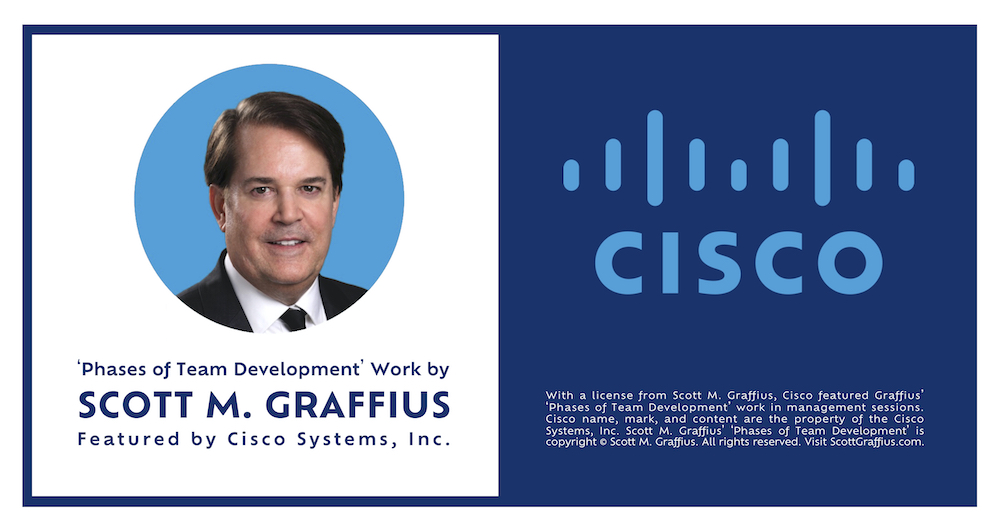










Sign up for Miro—it's free!
(Want more features? You can always upgrade to a paid plan.)




Permission Request Information
This work is copyright © Scott M. Graffius. All rights reserved.
To request permission to use Graffius' 'Phases of Team Development' visual shown at the top of this article, email Scott M. Graffius. If your request is approved, Graffius will give you an authorization/license and, if applicable, high-resolution files (JPG and PNG) of the visual. 

How to Cite This Article
Graffius, Scott M. (2025, January 7). Scott M. Graffius’ Phases of Team Development: 2025 Update. Available at: https://scottgraffius.com/blog/files/phases-of-team-development-update-for-2025.html. DOI: 10.13140/RG.2.2.33705.30564.

Digital Object Identifier (DOI)
DOI: 10.13140/RG.2.2.33705.30564

Short Link for Article
The short link for this article is https://bit.ly/teams-2025

Copyright
Copyright © Scott M. Graffius. All rights reserved.
Content on this site—including text, images, videos, and data—may not be used for training or input into any artificial intelligence, machine learning, or automatized learning systems, or published, broadcast, rewritten, or redistributed without the express written permission of Scott M. Graffius.
Most Valuable IT Certifications: Update for 2025



In Technology, there's no substitute for experience. However, certifications remain a valuable tool for advancing one's career.
Since 2017, Scott M. Graffius has researched and reported on the most valuable Information Technology (IT) related certifications. As new technologies emerge and business needs shift, the landscape of in-demand skills evolves. To reflect these ongoing changes, Graffius regularly updates his work. This article presents the 2025 edition of the most valuable IT certifications.


Certifications can help position people as a valuable asset to their current—and prospective future—employers.
Employers want employees and candidates with up-to-date knowledge and skills, and certifications demonstrate one's mastery of the respective subject. Additionally, certifications can advance marketability, leading to promotions and higher pay.
Graffius compiled and analyzed data from 15 sources—including the California Institute of Arts and Technology, CIO, CIO Dive, Computer Science, eWeek, Exceptional Agility, Forbes, Fortune, Global Knowledge, Indeed, ITTA, PC Magazine, Robert Half, Skillsoft, and Workday—to identify which IT certifications are widely seen as the most valuable. Ten certifications stood out as the top choices.
Now, on to this list for 2025!


1. CompTIA A+
- Certification name: CompTIA A+
- Certification name abbreviation: A+
- Governing organization - name: CompTIA
- Governing organization - website: https://www.comptia.org
- Short description of certification: This is generally considered to be a certification for people who want to start careers in the IT industry. To acquire the CompTIA A+ certification, you must pass two separate tests: Core 1 and Core 2. Core 1 (220-1101) covers mobile devices, networking technology, hardware, virtualization, and cloud computing. Core 2 (220-1102) covers operating systems, security, software, and operational procedures.
- Prerequisites (if any) for certification: None
- Certification exam – cost: Total cost for the two exams varies by location and other factors. The average total combined cost is $492
- Certification exam – delivery (in-person or online): in-person or online
- Certification exam – number of questions: Core 1 exam has 90 questions, Core 2 exam also has 90 questions
- Certification exam – time to complete it: 90 minutes for Core 1 exam, and 90 minutes for Core 2 exam
- Certification exam – minimum pass rate (X% or higher correct required to pass exam): Estimated to be 83% for the Core 1 exam. Estimated to be 86% for the Core 2 exam.
- Certification expiration – does it expire? Yes
- Certification expiration – how long does it last before expiring? 3 years
- Certification renewal cost: $75
Note: Prerequisites, cost (shown in United States Dollar - USD), and other data are subject to change by the governing organization.


2. Cisco Certified Network Associate (CCNA)
- Certification name: Cisco Certified Network Associate
- Certification name abbreviation: CCNA
- Governing organization - name: Cisco
- Governing organization - website: https://www.cisco.com
- Short description of certification: Validates the ability to install, operate, configure, and troubleshoot basic Cisco networking devices and technologies.
- Prerequisites (if any) for certification: No prerequisites. However, Cisco recommends having at least a basic knowledge of networking and at least one year of experience with Cisco products.
- Certification exam – cost: $300
- Certification exam – delivery (in-person or online): In-person or online
- Certification exam – number of questions: Varies, between 50-75 questions
- Certification exam – time to complete it: 120 minutes
- Certification exam – minimum pass rate (X% or higher correct required to pass exam): Estimated to be 80%
- Certification expiration – does it expire? Yes
- Certification expiration – how long does it last before expiring? 3 years
- Certification renewal cost: $150
Note: Prerequisites, cost (shown in United States Dollar - USD), and other data are subject to change by the governing organization.


3. Certified Information Systems Security Professional (CISSP)
- Certification name: Certified Information Systems Security Professional
- Certification name abbreviation: CISSP
- Governing organization - name: (ISC)²
- Governing organization - website: https://www.isc2.org
- Short description of certification: The CISSP is a highly respective, vendor-neutral certification that validates a broad understanding of information security and best practices.
- Prerequisites (if any) for certification: At least five years of paid, full time work experience involving two or more (of the eight) domains of the CISSP Common Body of Knowledge (CBK)
- Certification exam - cost: $749, although the cost may vary by location and other factors
- Certification exam - delivery (in-person or online): In-person at a Pearson VUE testing center
- Certification exam - number of questions: Between 125-175 questions
- Certification exam - time to complete it: 4 hours
- Certification exam - minimum pass rate (X% or higher correct required to pass exam): Estimated to be 70%
- Certification expiration - does it expire? Yes
- Certification expiration - how long does it last before expiring? 3 years
- Certification renewal cost: $125
Note: Prerequisites, cost (shown in United States Dollar - USD), and other data are subject to change by the governing organization.


4. Project Management Professional (PMP)
- Certification name: Project Management Professional
- Certification name abbreviation: PMP
- Governing organization - name: Project Management Institute (PMI)
- Governing organization - website: https://www.pmi.org/
- Short description of certification: PMP certification is a globally recognized and sought-after project management credential that recognizes experienced project managers for successfully leading teams through a project’s life cycle.
- Prerequisites (if any) for certification: A or B. (A) Bachelor's degree (or global equivalent) + 36 months of project management experience + 35 hours of project management education/training. Or (B) Secondary degree (high school diploma, associate’s degree or global equivalent) + 60 months of project management experience + 35 hours of project management education/training.
- Certification exam - cost: $405 for members of the PMI, $575 for those not a member of the PMI
- Certification exam - delivery (in-person or online): In-person
- Certification exam - number of questions: Between 180-200 questions
- Certification exam - time to complete it: 230 minutes
- Certification exam - minimum pass rate (X% or higher correct required to pass exam): Estimated to be 81%
- Certification expiration - does it expire? Yes
- Certification expiration - how long does it last before expiring? 3 years
- Certification renewal cost: $150
Note: Prerequisites, cost (shown in United States Dollar - USD), and other data are subject to change by the governing organization.


5. Certified Ethical Hacker (CEH)
- Certification name: Certified Ethical Hacker
- Certification name abbreviation: CEH
- Governing organization - name: EC-Council
- Governing organization - website: https://www.eccouncil.org
- Short description of certification: This certification is obtained by demonstrating knowledge of assessing the security of computer systems by looking for vulnerabilities in target systems, using the same knowledge and tools as a malicious hacker, but in a lawful and legitimate manner to assess the security posture of a target system.
- Prerequisites (if any) for certification: Candidates need to have experience in a job related to network security or complete approved training courses before taking the exam
- Certification exam - cost: $1,199, can vary based on registration options and other factors
- Certification exam - delivery (in-person or online): In-person at a Pearson VUE testing center or online proctored
- Certification exam - number of questions: 125
- Certification exam - time to complete it: 4 hours
- Certification exam - minimum pass rate (X% or higher correct required to pass exam): Estimated to be 70%
- Certification expiration - does it expire? Yes
- Certification expiration - how long does it last before expiring? 3 years
- Certification renewal cost: $85
Note: Prerequisites, cost (shown in United States Dollar - USD), and other data are subject to change by the governing organization.


6. AWS Certified Solutions Architect - Associate (AWS SA)
- Certification name: AWS Certified Solutions Architect - Associate
- Certification name abbreviation: AWS SA
- Governing organization - name: Amazon Web Services (AWS)
- Governing organization - website: http://aws.amazon.com
- Short description of certification: This certification showcases knowledge and skills in AWS technology, across a wide range of AWS services. The focus is on the design of cost- and performance-optimized solutions, demonstrating a strong understanding of the AWS Well-Architected Framework.
- Prerequisites (if any) for certification: None
- Certification exam - cost: $150
- Certification exam - delivery (in-person or online): In-person or online
- Certification exam - number of questions: 65 questions
- Certification exam - time to complete it: 130 minutes
- Certification exam - minimum pass rate (X% or higher correct required to pass exam): Estimated to be 70%
- Certification expiration - does it expire? Yes
- Certification expiration - how long does it last before expiring? 3 years
- Certification renewal cost: $75
Note: Prerequisites, cost (shown in United States Dollar - USD), and other data are subject to change by the governing organization.


7. Azure Administrator Associate
- Certification name: Azure Administrator Associate
- Certification name abbreviation: There isn't an abbreviation designated. AZ-104 (the corresponding exam code for the certification) is sometimes used as an identifier.
- Governing organization - name: Microsoft
- Governing organization - website: https://learn.microsoft.com
- Short description of certification: Azure Administrator Associate (also referred to as Microsoft Certified: Azure Administrator Associate) certification validates one’s ability to manage Azure subscriptions, implement and secure infrastructure, configure virtual networks, deploy virtual machines, monitor resources, and troubleshoot issues.
- Prerequisites (if any) for certification: None, but Microsoft recommends at least six months of experience administering Azure
- Certification exam - cost: $165
- Certification exam - delivery (in-person or online): In-person or online proctored
- Certification exam - number of questions: Varies, typically between 40-60 questions
- Certification exam - time to complete it: 120 minutes
- Certification exam - minimum pass rate (X% or higher correct required to pass exam): Estimated to be 70%
- Certification expiration - does it expire? Yes
- Certification expiration - how long does it last before expiring? 1 year
- Certification renewal cost: Free renewal
Note: Prerequisites, cost (shown in United States Dollar - USD), and other data are subject to change by the governing organization.


8. Google Certified Professional Cloud Architect (GCP Architect)
- Certification name: Google Certified Professional Cloud Architect
- Certification name abbreviation: GCP Architect
- Governing organization - name: Google
- Governing organization - website: https://cloud.google.com
- Short description of certification: Demonstrates expertise in designing, developing, and managing secure, reliable, scalable, and cost-effective solutions on the Google Cloud Platforms (GCP)
- Prerequisites (if any) for certification: None; familiarity with GCP products and services is recommended
- Certification exam - cost: $200
- Certification exam - delivery (in-person or online): In-person
- Certification exam - number of questions: 50 questions
- Certification exam - time to complete it: 120 minutes
- Certification exam - minimum pass rate (X% or higher correct required to pass exam): Estimated to be 70%
- Certification expiration - does it expire? Yes
- Certification expiration - how long does it last before expiring? 2 years
- Certification renewal cost: $100
Note: Prerequisites, cost (shown in United States Dollar - USD), and other data are subject to change by the governing organization.


9. Certified ScrumMaster (CSM)
- Certification name: Certified ScrumMaster
- Certification name abbreviation: CSM
- Governing organization - name: Scrum Alliance
- Governing organization - website: https://www.scrumalliance.org
- Short description of certification: Validates a solid understanding of Scrum including practical ways to apply it on one’s team and organization
- Prerequisites (if any) for certification: Completion of a two-day course by an authorized trainer
- Certification exam - cost: Course (referenced above) includes the cost of the exam. Cost ranges from about $500 to $1,500 depending on the location, delivery format, and other factors
- Certification exam - delivery (in-person or online): Online
- Certification exam - number of questions: 50
- Certification exam - time to complete it: 1 hour
- Certification exam - minimum pass rate (X% or higher correct required to pass exam): Estimated to be 74%
- Certification expiration - does it expire? Yes
- Certification expiration - how long does it last before expiring? 2 years
- Certification renewal cost: $100
Note: Prerequisites, cost (shown in United States Dollar - USD), and other data are subject to change by the governing organization.


10. Certified Artificial Intelligence Scientist (CSAI)
- Certification name: Certified Artificial Intelligence Scientist
- Certification name abbreviation: CAIS
- Governing organization - name: United States Artificial Intelligence Institute (USAII)
- Governing organization - website: https://www.usaii.org
- Short description of certification: The CAIS is publicized by USAII as the most sophisticated and ground-breaking certification program for senior AI professionals and business leaders to develop the perfect AI solutions and strategy, bringing the right organizational change leading to an absolute business transformation.
- Prerequisites (if any) for certification: One of three eligibility paths and completion of a self-paced course. Path 1: Bachelor's degree (or equivalent) in any academic discipline; and at least five years of experience in Artificial Intelligence, Machine Learning, Data Science, Business Analytics, Business Intelligence, Project Management, or any Programming Languages. Path 2: Bachelor's degree (or equivalent) in any academic discipline; and at least four years of experience in Artificial Intelligence, Machine Learning, Data Science, Business Analytics, Business Intelligence, Engineering, Finance, or Management. Path 3: Certified Artificial Intelligence Consultant (CAIC) (or other equivalent) certification; and at least four years of experience for a candidate who has a Bachelor's degree (or equivalent), or three years of experience for a candidate who has a Master's degree (or equivalent).
- Certification exam - cost: Course (referenced above) includes the cost of the exam. Cost is $894.
- Certification exam - delivery (in-person or online): In-person
- Certification exam - number of questions: 80
- Certification exam - time to complete it: 100 minutes
- Certification exam - minimum pass rate (X% or higher correct required to pass exam): 70%
- Certification expiration - does it expire? Yes
- Certification expiration - how long does it last before expiring? 3 years
- Certification renewal cost: $249
Note: Prerequisites, cost (shown in United States Dollar - USD), and other data are subject to change by the governing organization.


Certifications can provide significant value for professionals looking to enhance their skills and credibility in the marketplace. Employers often prefer to hire certified professionals, and people who invest in professional credentials typically enjoy larger salaries.
Informed by data from multiple sources, this article identified and profiled 10 IT-related certifications: CompTIA A+, Cisco Certified Network Associate (CCNA), Certified Information Systems Security Professional (CISSP), Project Management Professional (PMP), Certified Ethical Hacker (CEH), AWS Certified Solutions Architect - Associate (AWS SA), Azure Administrator Associate, Google Certified Professional Cloud Architect (GCP Architect), Certified ScrumMaster (CSM), and Certified Artificial Intelligence Scientist (CAIS).
Those interested in securing one or more IT-related certifications can leverage the data presented in this article to assist in their decision-making.


References/Sources:
- California Institute of Arts and Technology (CIAT) (2024, February). 10 In-Demand IT Jobs You Can Get With Tech Certifications. Available at: https://www.ciat.edu/blog/10-in-demand-it-jobs-you-can-get-with-tech-certifications.
- CIO (2024, November 24). The 15 Most Valuable IT Certifications Today. Available at: https://www.cio.com/article/286762/careers-staffing-12-it-certifications-that-deliver-career-advancement.html.
- CIO.com (2024, June 7). Top 8 IT Certifications in Demand Today. Available at: https://www.cio.com/article/193586/top-15-it-certifications-in-demand-today.html.
- CIO Dive (2023, November 14). 5 Highest-Paying IT Certifications in 2023. Available at: https://www.ciodive.com/news/top-paying-IT-certifications-project-management-security/699641.
- Computer Science(dot)org. (2023, November 9). Best IT Certifications To Boost Your Computer Science Career. Available at: https://www.computerscience.org/resources/top-it-certifications.
- eWeek (2024, February 8). 30 Top AI Certifications: Hotlist of 2024. Available at: https://www.eweek.com/artificial-intelligence/ai-certifications.
- Exceptional Agility (2024, January 4). Top Agile Certifications: Update for 2024. Available at: https://exceptionalagility.com/blog/files/top-agile-certifications-2024.html.
- Forbes (2024, March 21). 10 Certificates To Put On Your Resume In 2024. Available at: https://www.forbes.com/sites/rachelwells/2024/03/21/10-certificates-to-put-on-your-resume-in-2024/.
- Fortune (2023, November 14). How Much Can You Make with IT Certifications? Available at: https://fortune.com/education/articles/how-much-can-you-make-with-it-certifications-average-salaries.
- Global Knowledge (2023, April 27). 10 Top-Paying IT Certifications. Available at: https://www.globalknowledge.com/us-en/resources/resource-library/articles/10-top-paying-it-certifications.
- Graffius, Scott M. (2024, March 15). Most Valuable IT Certifications: Update for 2024. Available at: https://scottgraffius.com/blog/files/it-certs-2024.html. DOI: 10.13140/RG.2.2.11776.03849.
- Indeed (2023, December 18). Top 17 IT Certifications in Demand for 2024. Available at: https://www.indeed.com/career-advice/career-development/top-it-certifications.
- Indeed (2024, April 18). 10 High-Paying IT Certifications. Available at: https://www.indeed.com/career-advice/finding-a-job/highest-paying-it-certifications.
- ITTA (2024, November 7). Top 10 Must-have IT certifications for 2025. Available at: https://www.itta.net/en/blog/top-10-must-have-it-certifications-for-2025/.
- PC Magazine (2023, December 1). Level Up Your Career: The Highest-Paying IT Certifications for 2024. Available at: https://www.pcmag.com/news/highest-paying-it-certifications.
- Robert Half (2023, November 27). The 29 Most Valuable IT Certifications. Available at: https://www.roberthalf.com/us/en/insights/career-development/which-it-certifications-are-most-valuable.
- Robert Half (2024, December 17). 34 of the Best IT Certifications for Boosting Your Tech Career. Available at: https://www.roberthalf.com/us/en/insights/career-development/which-it-certifications-are-most-valuable.
- Skillsoft (2024, January 16). The 20 Top-Paying Microsoft Certifications in 2024. Available at: https://www.skillsoft.com/blog/top-paying-microsoft-certifications.
- Workday (2025, February 4). Ultimate Guide to IT Certifications in 2025. Available at: https://blog.workday.com/en-us/ultimate-guide-to-it-certifications-in-2025.html.


How to Cite This Article
Graffius, Scott M. (2025, February 5). Most Valuable IT Certifications: Update for 2025. Available at: https://scottgraffius.com/blog/files/top-it-certifications-update-for-2025.html.

About Scott M. Graffius

Scott M. Graffius is an AI, Agile, and Project Management/PMO leader, researcher, author, and speaker. Along the way, he spearheaded initiatives that have generated over $2.3 billion in impact for organizations across tech, entertainment, finance, healthcare, and beyond. The following sections provide additional information on his experience, contributions, and influence.
Experience
Graffius heads the professional services firm Exceptional PPM and PMO Solutions, along with its subsidiary Exceptional Agility. These consultancies offer strategic and tactical advisory, training, embedded expertise, and consulting services to the public, private, and government sectors. They help organizations enhance their capabilities and results in agile, project management, program management, portfolio management, and PMO leadership, supporting innovation and driving competitive advantage. The consultancies confidently back services with a Delighted Client Guarantee™.
Graffius is a former VP of project management with a publicly traded provider of diverse consumer products and services over the Internet. Before that, he ran and supervised the delivery of projects and programs in public and private organizations with businesses ranging from e-commerce to advanced technology products and services, retail, manufacturing, entertainment, and more.
He has experience with consumer, business, reseller, government, and international markets.
Award-Winning Author
Graffius has authored three books.
- Agile Scrum: Your Quick Start Guide with Step-by-Step Instructions, his first book, earned 17 awards.
- Agile Transformation: A Brief Story of How an Entertainment Company Developed New Capabilities and Unlocked Business Agility to Thrive in an Era of Rapid Change, his second book, was named one of the best Scrum books of all time by BookAuthority.
- Agile Protocol: The Transformation Ultimatum, his third book and his first work of fiction, was released in April 2025. The book trailer is on YouTube.
International Public Speaker
Organizations worldwide engage Graffius to present on tech (including AI), Agile, project management, program management, portfolio management, and PMO leadership. He crafts and delivers unique and compelling talks and workshops. To date, Graffius has conducted 93 sessions across 25 countries. Select examples of events include Agile Trends Gov, BSides (Newcastle Upon Tyne), Conf42 Quantum Computing, DevDays Europe, DevOps Institute, DevOpsDays (Geneva), Frug’Agile, IEEE, Microsoft, Scottish Summit, Scrum Alliance RSG (Nepal), Techstars, and W Love Games International Video Game Development Conference (Helsinki), and more.
With an average rating of 4.81 (on a scale of 1-5), sessions are highly valued.
The speaker engagement request form is here.
Thought Leadership and Influence
Prominent businesses, professional associations, government agencies, and universities have showcased Graffius and his contributions—spanning his books, talks, workshops, and beyond. Select examples include:
- Adobe,
- American Management Association,
- Amsterdam Public Health Research Institute,
- Bayer,
- BMC Software,
- Boston University,
- Broadcom,
- Cisco,
- Coburg University of Applied Sciences and Arts - Germany,
- Computer Weekly,
- Constructor University - Germany,
- Data Governance Success,
- Deimos Aerospace,
- DevOps Institute,
- Dropbox,
- EU's European Commission,
- Ford Motor Company,
- Gartner,
- GoDaddy,
- Harvard Medical School,
- Hasso Plattner Institute - Germany,
- IEEE,
- Innovation Project Management,
- Johns Hopkins University,
- Journal of Neurosurgery,
- Lam Research (Semiconductors),
- Leadership Worthy,
- Life Sciences Trainers and Educators Network,
- London South Bank University,
- Microsoft,
- NASSCOM,
- National Academy of Sciences,
- New Zealand Government,
- Oracle,
- Pinterest Inc.,
- Project Management Institute,
- Mary Raum (Professor of National Security Affairs, United States Naval War College),
- SANS Institute,
- SBG Neumark - Germany,
- Singapore Institute of Technology,
- Torrens University - Australia,
- TBS Switzerland,
- Tufts University,
- UC San Diego,
- UK Sports Institute,
- University of Galway - Ireland,
- US Department of Energy,
- US National Park Service,
- US Soccer,
- US Tennis Association,
- Verizon,
- Wrike,
- Yale University,
- and many others.
Graffius has played a key role in the Project Management Institute (PMI) in developing professional standards. He was a member of multiple teams that authored, reviewed, and produced:
- Practice Standard for Work Breakdown Structures—Second Edition.
- A Guide to the Project Management Body of Knowledge—Sixth Edition.
- The Standard for Program Management—Fourth Edition.
- The Practice Standard for Project Estimating—Second Edition.
Additional details are here.
He was also a subject matter expert reviewer of content for the PMI’s Congress. Beyond the PMI, Graffius also served as a member of the review team for two of the Scrum Alliance’s Global Scrum Gatherings.
Acclaimed Authority on Teamwork Tradecraft
Graffius is a renowned authority on teamwork tradecraft. Informed by the research of Bruce W. Tuckman and Mary Ann C. Jensen, over 100 subsequent studies, and Graffius' first-hand professional experience with, and analysis of, team leadership and performance, Graffius created his 'Phases of Team Development' as a unique perspective and visual conveying the five phases of team development. First introduced in 2008 and periodically updated, his work provides a diagnostic and strategic guide for navigating team dynamics. It provides actionable insights for leaders across industries to develop high-performance teams. Its adoption by esteemed organizations such as Yale University, IEEE, Cisco, Microsoft, Ford, Oracle, Broadcom, the U.S. National Park Service, and the Journal of Neurosurgery, among others, highlights its utility and value, solidifying its status as an indispensable resource for elevating team performance and driving organizational excellence.
The 2025 edition of Graffius' "Phases of Team Development" intellectual property is here.
Expert on Temporal Dynamics on Social Media Platforms
Graffius is also an authority on temporal dynamics on social media platforms. His 'Lifespan (Half-Life) of Social Media Posts' research—first published in 2018 and updated annually—delivers a precise quantitative analysis of post longevity across digital platforms, utilizing advanced statistical techniques to determine mean half-life with precision. It establishes a solid empirical base, effectively highlighting the ephemeral nature of content within social media ecosystems. Referenced and applied by leading entities such as the Center for Direct Marketing, Fast Company, GoDaddy, Pinterest Inc., and PNAS, among others, his research exemplifies methodological rigor and sustained significance in the field of digital informatics.
The 2025 edition of Graffius "Lifespan (Half-Life) of Social Media Posts" research is here.
Education and Professional Certifications
Graffius has a bachelor’s degree in psychology with a focus in Human Factors. He holds eight professional certifications:
- Certified SAFe 6 Agilist (SA),
- Certified Scrum Professional - ScrumMaster (CSP-SM),
- Certified Scrum Professional - Product Owner (CSP-PO),
- Certified ScrumMaster (CSM),
- Certified Scrum Product Owner (CSPO),
- Project Management Professional (PMP),
- Lean Six Sigma Green Belt (LSSGB), and
- IT Service Management Foundation (ITIL).
He is an active member of the Scrum Alliance, the Project Management Institute (PMI), and the Institute of Electrical and Electronics Engineers (IEEE).
Advancing AI, Agile, and Project/PMO Management
Scott M. Graffius continues to advance the fields of AI, Agile, and Project/PMO Management through his leadership, research, writing, and real-world impact. Businesses and other organizations leverage Graffius’ insights to drive their success.
Thought Leader | Public Speaker | Agile Protocol Book | Agile Scrum Book | Agile Transformation Book | Blog | Photo | X | LinkedIn | Email













Sign up for Miro—it's free!
(Want more features? You can always upgrade to a paid plan.)

Copyright
Copyright © Scott M. Graffius. All rights reserved.
Content on this site—including text, images, videos, and data—may not be used for training or input into any artificial intelligence, machine learning, or automatized learning systems, or published, broadcast, rewritten, or redistributed without the express written permission of Scott M. Graffius.
